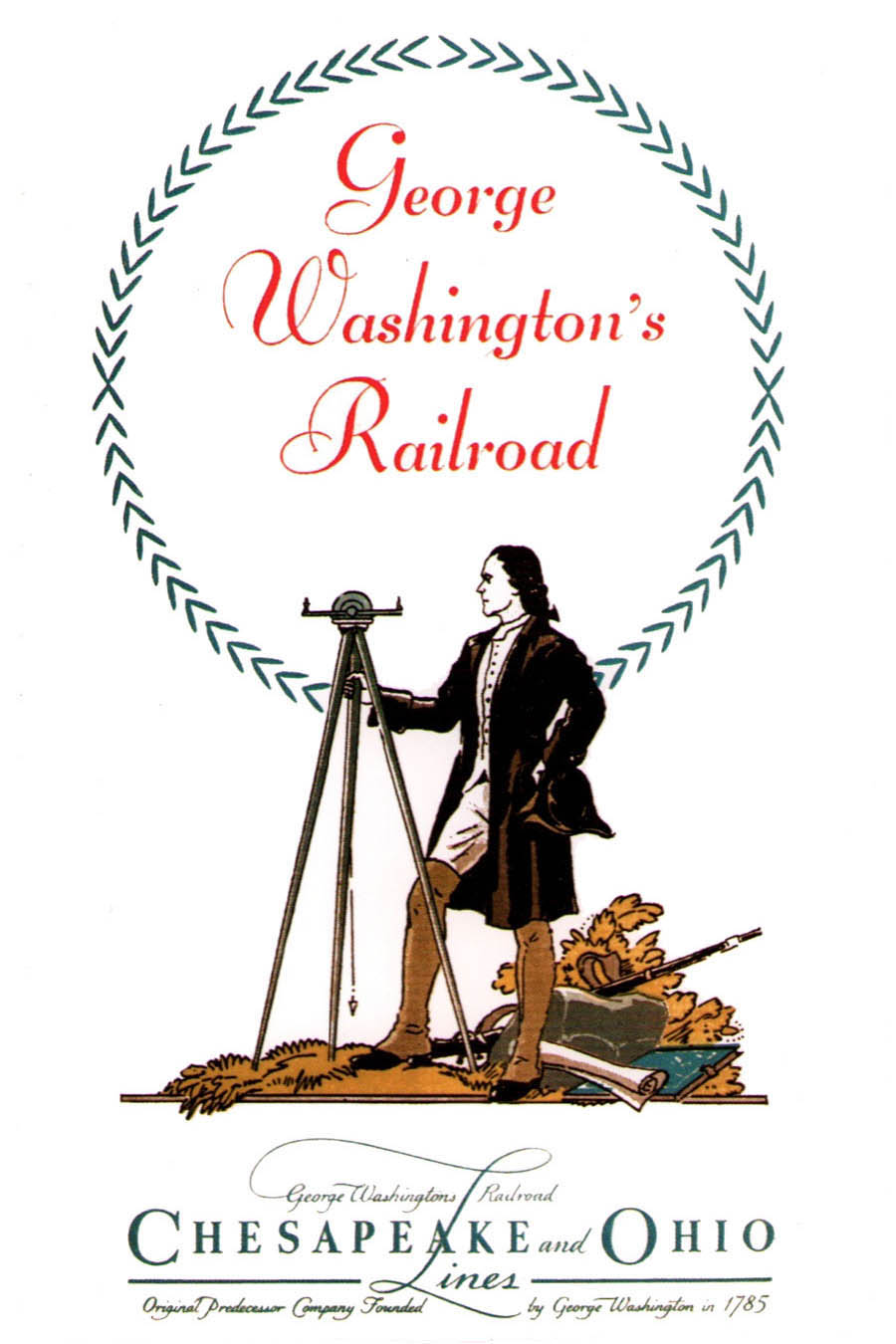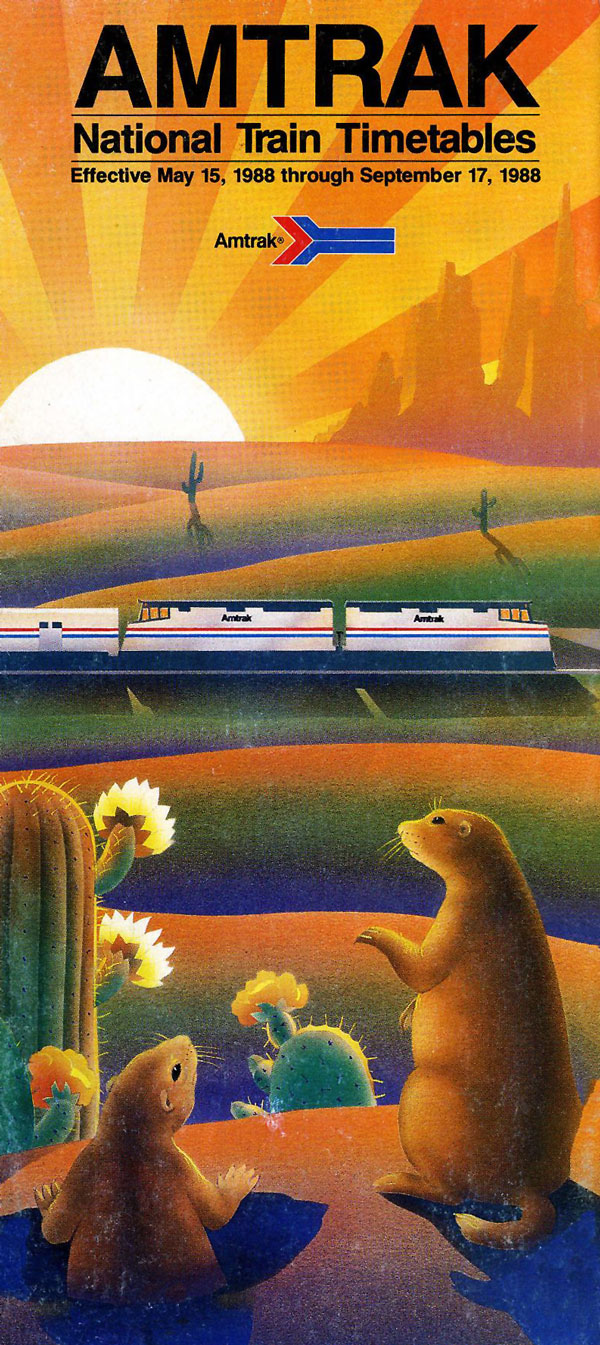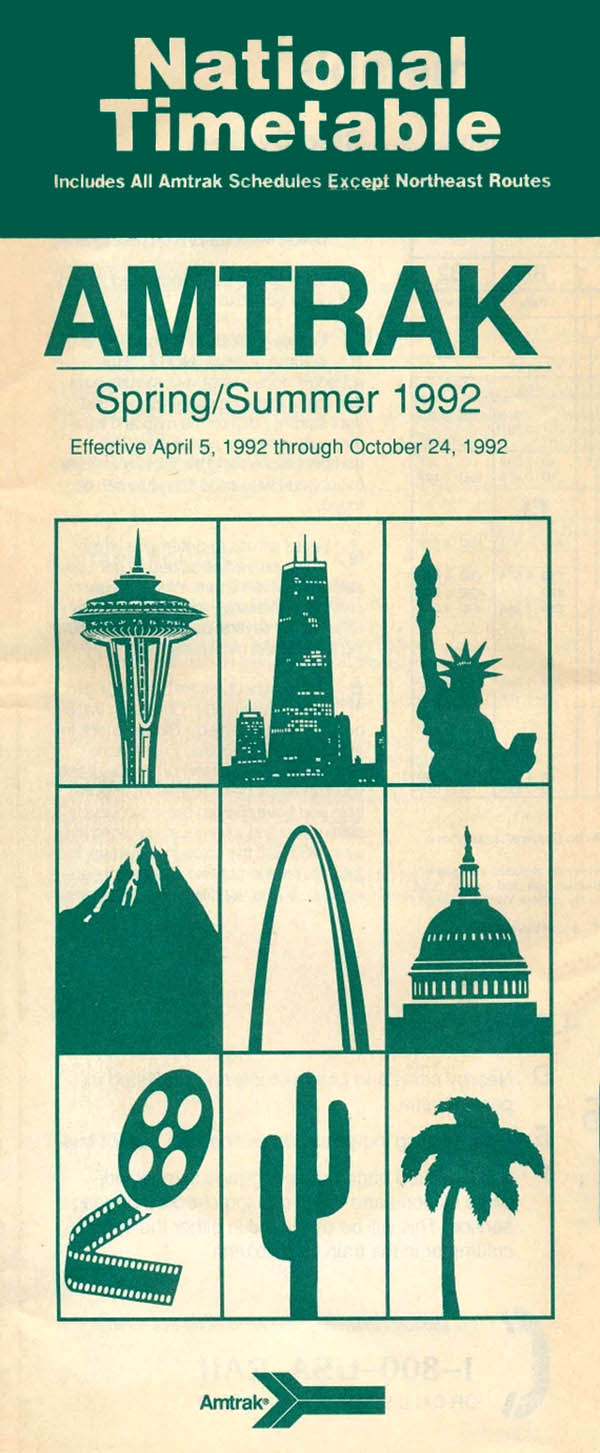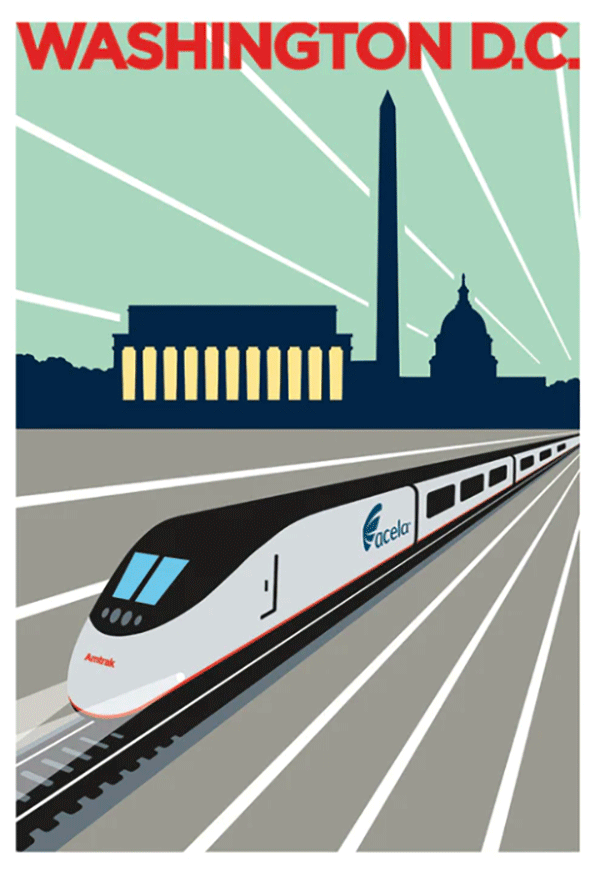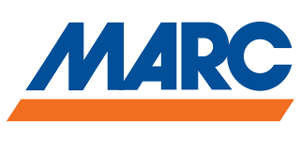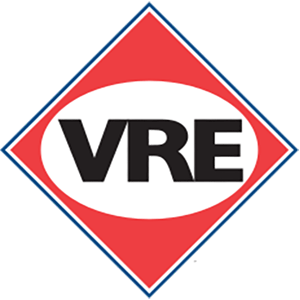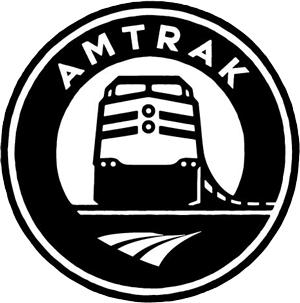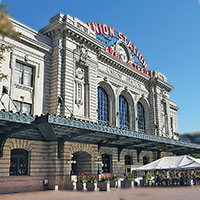 |
Amtrak Great Stations Washington, DC |
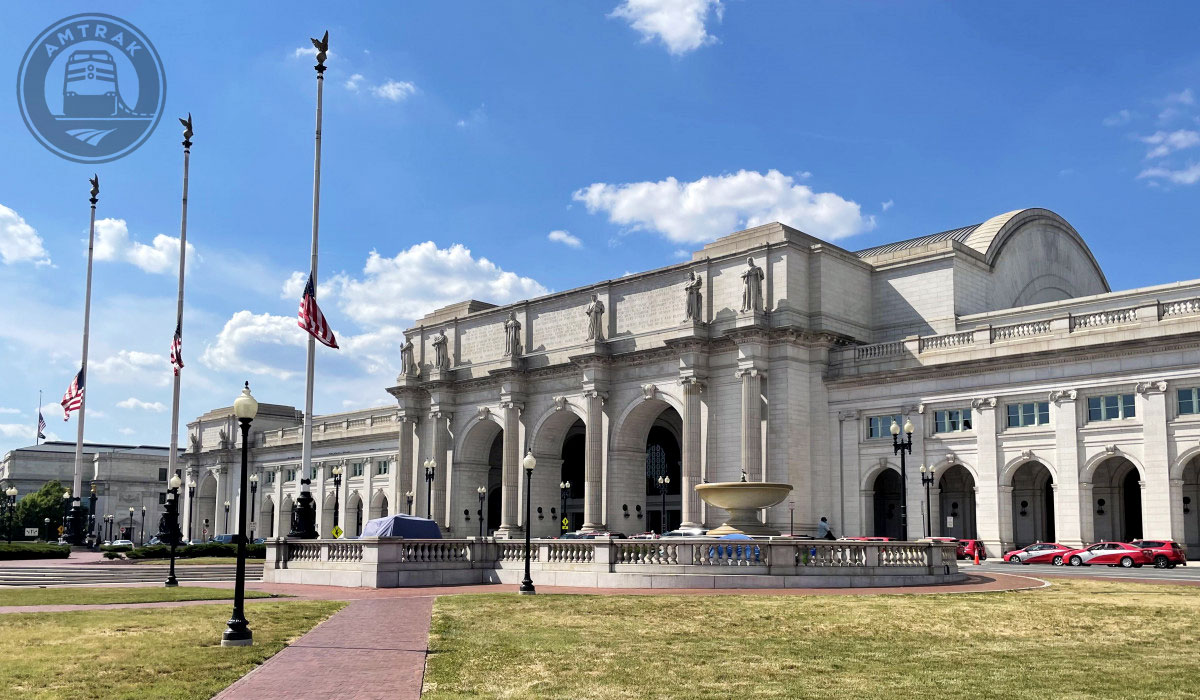
collection

Washington Union Station
 n 1901, the U. S. Senate Park Commission invited master American architect and planner Daniel Burnham to orchestrate a sweeping City Beautiful plan for Washington, D.C., and make it a setting that was both practical and grandly befitting a world capital. Burnham’s work, inspired by that of L’Enfant, would help create the monumental architecture now associated with the National Mall. As part of this work, Burnham designed a Union Station that removed the rail lines from the center of the Mall, which had become a tangle of paths, gardens and buildings, and brought two major railroads, the Pennsylvania and the Baltimore and Ohio, into one terminal.
n 1901, the U. S. Senate Park Commission invited master American architect and planner Daniel Burnham to orchestrate a sweeping City Beautiful plan for Washington, D.C., and make it a setting that was both practical and grandly befitting a world capital. Burnham’s work, inspired by that of L’Enfant, would help create the monumental architecture now associated with the National Mall. As part of this work, Burnham designed a Union Station that removed the rail lines from the center of the Mall, which had become a tangle of paths, gardens and buildings, and brought two major railroads, the Pennsylvania and the Baltimore and Ohio, into one terminal.
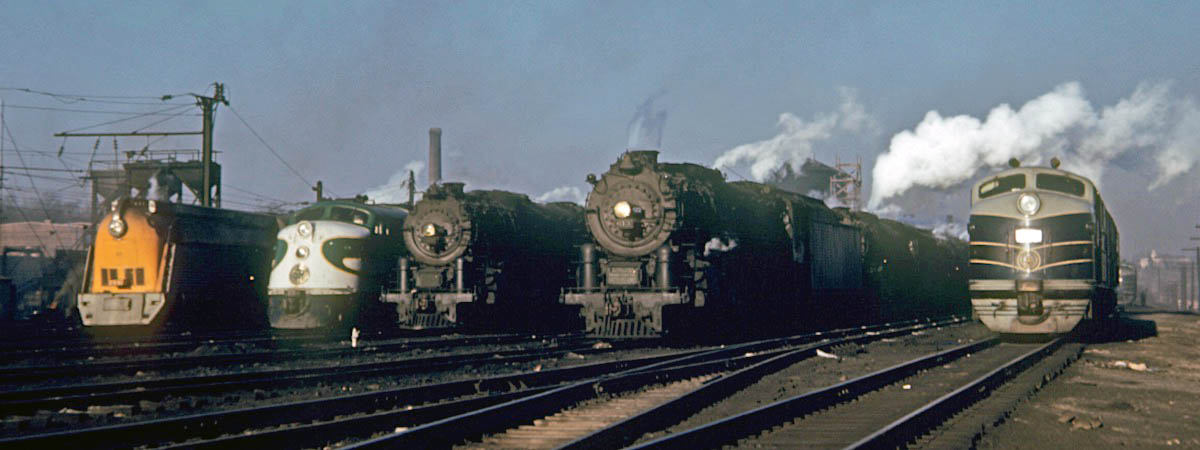 Completed in 1908, the station inspires visitors with its exquisitely detailed neoclassical architecture. Although faced with Bethel white granite from Vermont on the exterior and interior, the building’s bones are modern concrete and steel. The front of the station, on Columbus Circle, presents travelers with a soaring vaulted entryway and heroic statuary on its 600-foot length. The 96-foot high Main Hall coffered ceiling shines brilliantly with gold leaf and reflects natural light entering from the large Diocletian windows.
Completed in 1908, the station inspires visitors with its exquisitely detailed neoclassical architecture. Although faced with Bethel white granite from Vermont on the exterior and interior, the building’s bones are modern concrete and steel. The front of the station, on Columbus Circle, presents travelers with a soaring vaulted entryway and heroic statuary on its 600-foot length. The 96-foot high Main Hall coffered ceiling shines brilliantly with gold leaf and reflects natural light entering from the large Diocletian windows.
 The former Main Concourse, now the heart of the station, lifts its barrel-vaulted glass and coffered plaster ceiling 45 feet above the main floor and stretches 760 feet long. It was once said to be the largest single room in the world. When the building first opened, it also featured a private, secure waiting room for the president and his visitors, as well as a public dining room whose walls were covered in murals modeled after those recently excavated at the ancient Roman cities of Pompeii and Herculaneum.
The former Main Concourse, now the heart of the station, lifts its barrel-vaulted glass and coffered plaster ceiling 45 feet above the main floor and stretches 760 feet long. It was once said to be the largest single room in the world. When the building first opened, it also featured a private, secure waiting room for the president and his visitors, as well as a public dining room whose walls were covered in murals modeled after those recently excavated at the ancient Roman cities of Pompeii and Herculaneum.
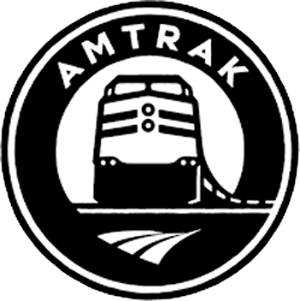 More than 100,000 visitors pass through Union Station each day, including passengers using Amtrak, Maryland Area Regional Commuter (MARC) rail and Virginia Railway Express (VRE), Metro subway trains and buses, taxis, tourist buses, intercity buses and Capital Bikeshare. The building is also a popular shopping and dining destination for residents of the Capitol Hill neighborhood, and the city at large. Behind the station, above the train sheds, stands a parking structure offering approximately 2,500 spaces. The station, bringing all these modes of transportation together, makes it easy for people to move from private automobile to Amtrak to taxi or from commuter rail onto the subway and still have time to buy a meal, a gift, or a cup of coffee on their way.
More than 100,000 visitors pass through Union Station each day, including passengers using Amtrak, Maryland Area Regional Commuter (MARC) rail and Virginia Railway Express (VRE), Metro subway trains and buses, taxis, tourist buses, intercity buses and Capital Bikeshare. The building is also a popular shopping and dining destination for residents of the Capitol Hill neighborhood, and the city at large. Behind the station, above the train sheds, stands a parking structure offering approximately 2,500 spaces. The station, bringing all these modes of transportation together, makes it easy for people to move from private automobile to Amtrak to taxi or from commuter rail onto the subway and still have time to buy a meal, a gift, or a cup of coffee on their way.
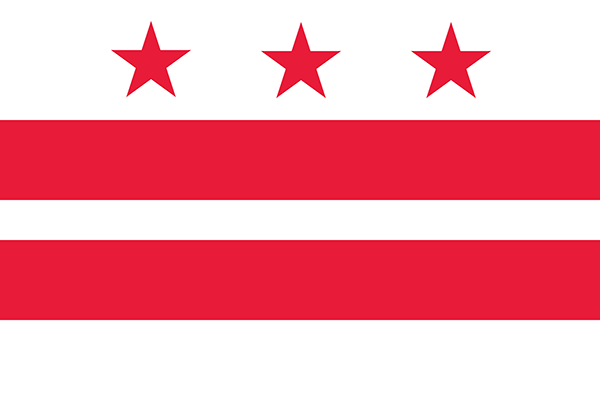 Today the station, which is larger than the U.S. Capitol, is the number one destination for visitors to Washington, D.C. It houses an indoor mall in the former Main Concourse, with many shops and kiosks throughout the station, providing ample space to meet, greet and shop. There is more than 210,000 square feet of retail space, including full service restaurants and small eateries providing quick meals. Amtrak maintained its corporate offices at the station from 1988 until late 2017. Since its re-opening, Union Station has hosted a large variety of cultural and civic events, presidential inaugural balls, free concerts, art and photography exhibits, and many other activities.
Today the station, which is larger than the U.S. Capitol, is the number one destination for visitors to Washington, D.C. It houses an indoor mall in the former Main Concourse, with many shops and kiosks throughout the station, providing ample space to meet, greet and shop. There is more than 210,000 square feet of retail space, including full service restaurants and small eateries providing quick meals. Amtrak maintained its corporate offices at the station from 1988 until late 2017. Since its re-opening, Union Station has hosted a large variety of cultural and civic events, presidential inaugural balls, free concerts, art and photography exhibits, and many other activities.
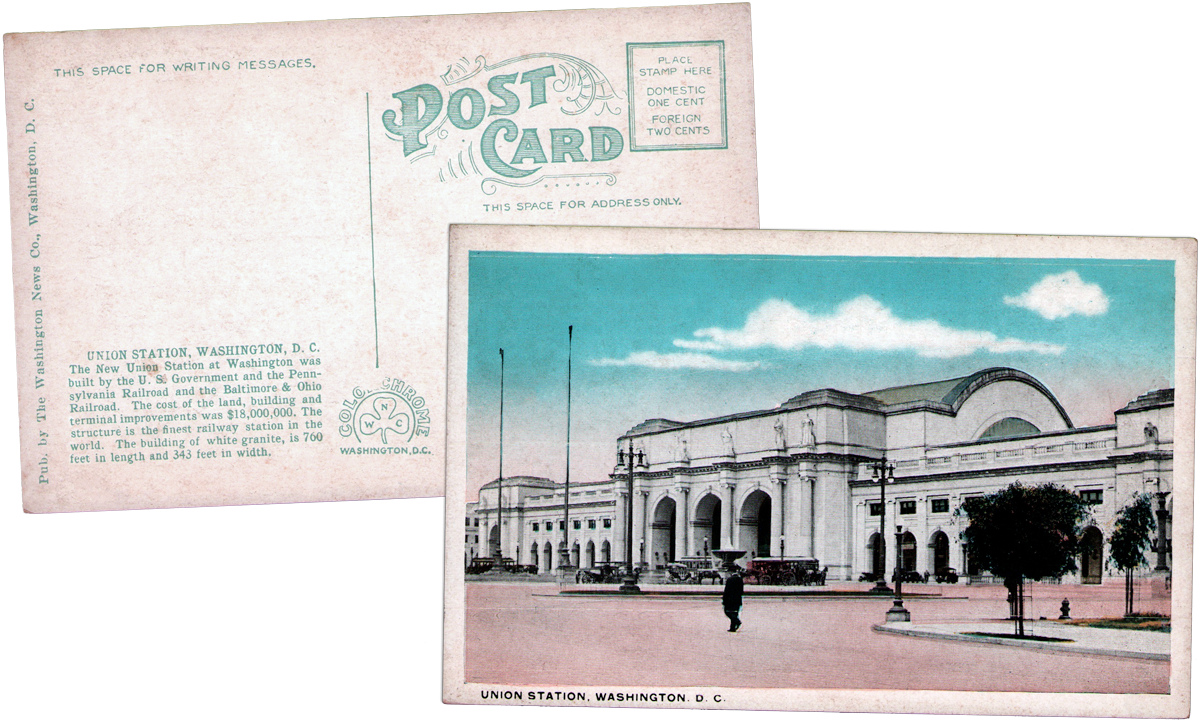
postcard / collection

Union Station overhead / Google Maps


Washington DC
- name:Washington Union Station
- station code:WAS
- location:50 Massachusetts Ave NE, Washington DC
- owners:United States Dept of Transportation (building)
Washington Terminal Co / Amtrak (platforms, tracks) - operators:Amtrak, MARC, VRE
- platforms:18 platforms
- tracks:22 tracks, plus yards
- opened:1908, electrified 1935
- style:Classical, Beaux-Arts
- architect:D.H. Burnham & Company
- rebuilt:1981-89
- Nat Reg Historic Places:1969
- notes:
- Amtrak's headquarters and second busiest station
- routes:
- Northeast Corridor | Capital Limited | Cardinal | Carolinian | Crescent | Palmetto | Silver Service | Vermonter



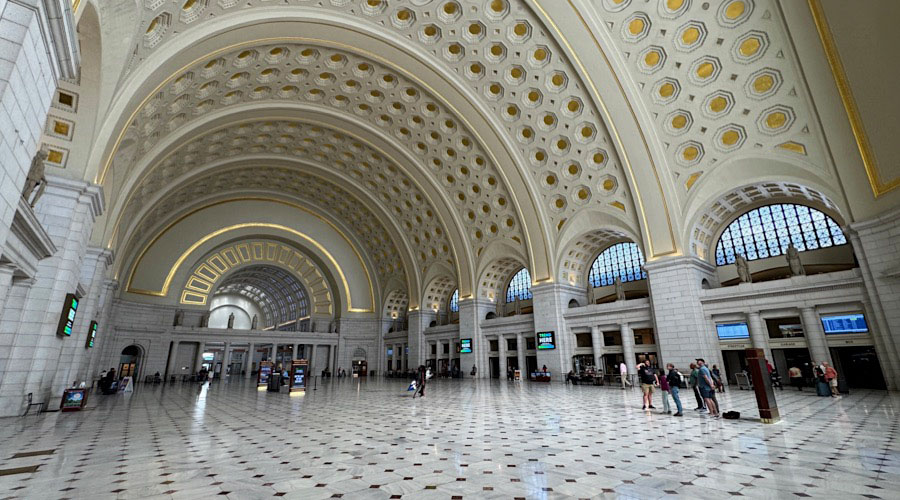
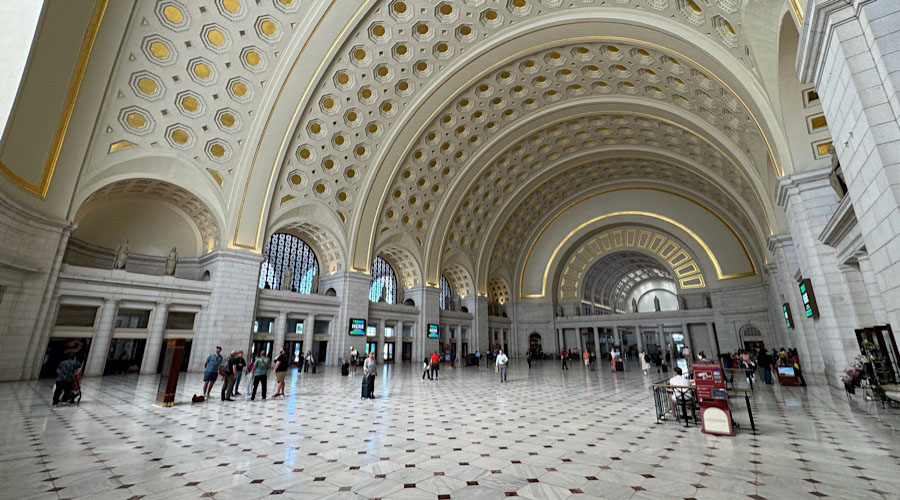
RWH
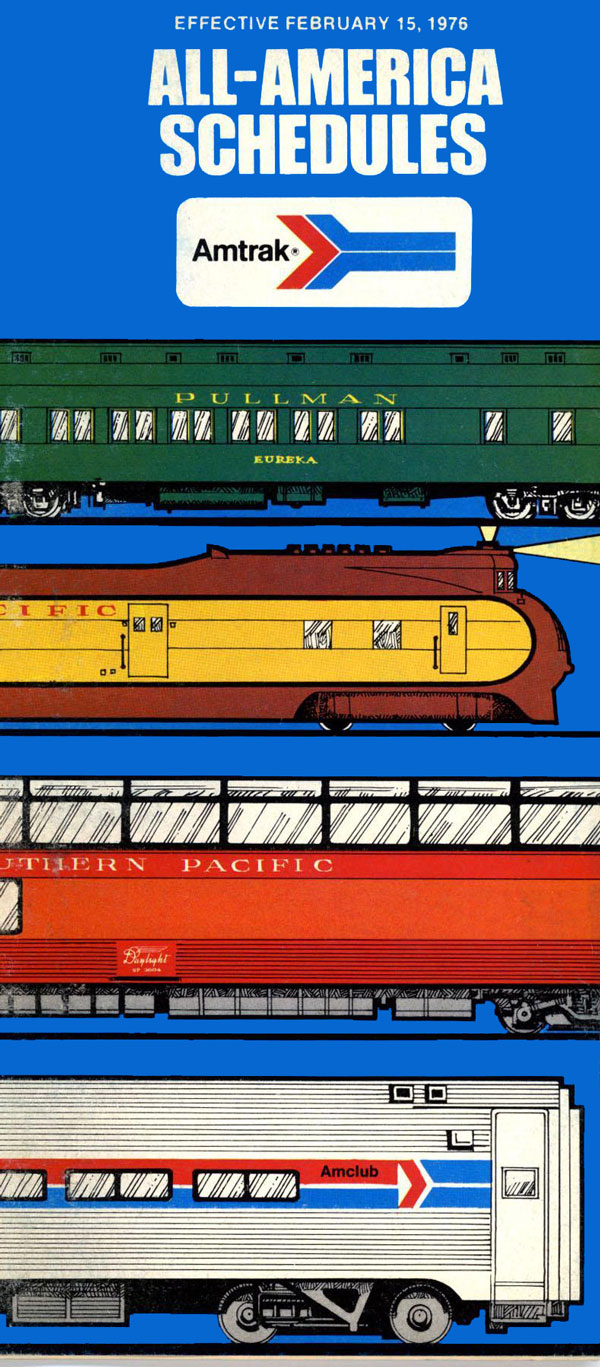
collection
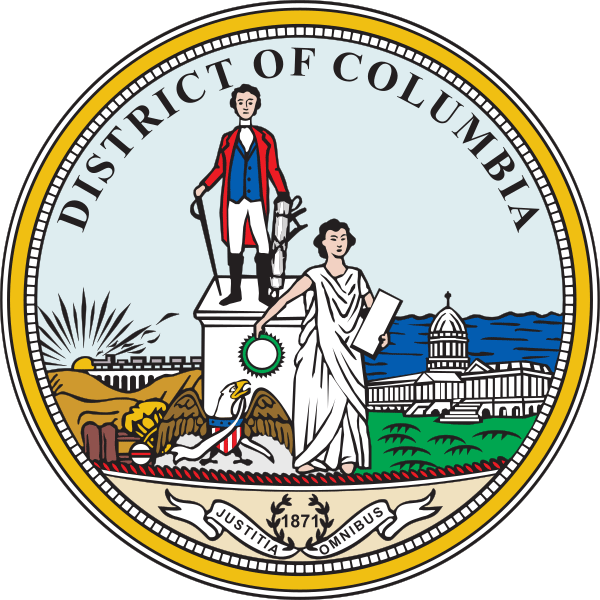
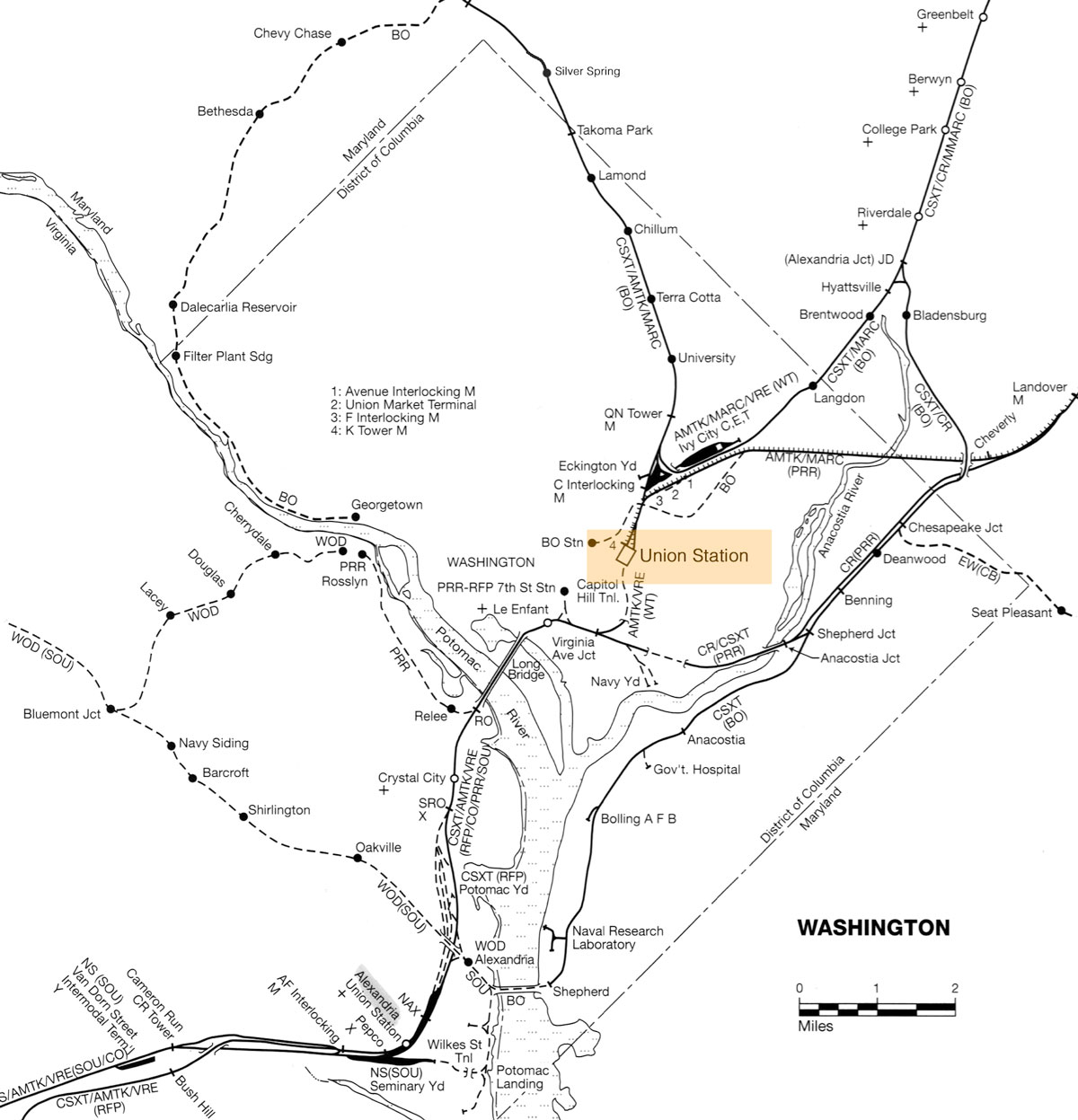
DC regional rail map / adapted RWH
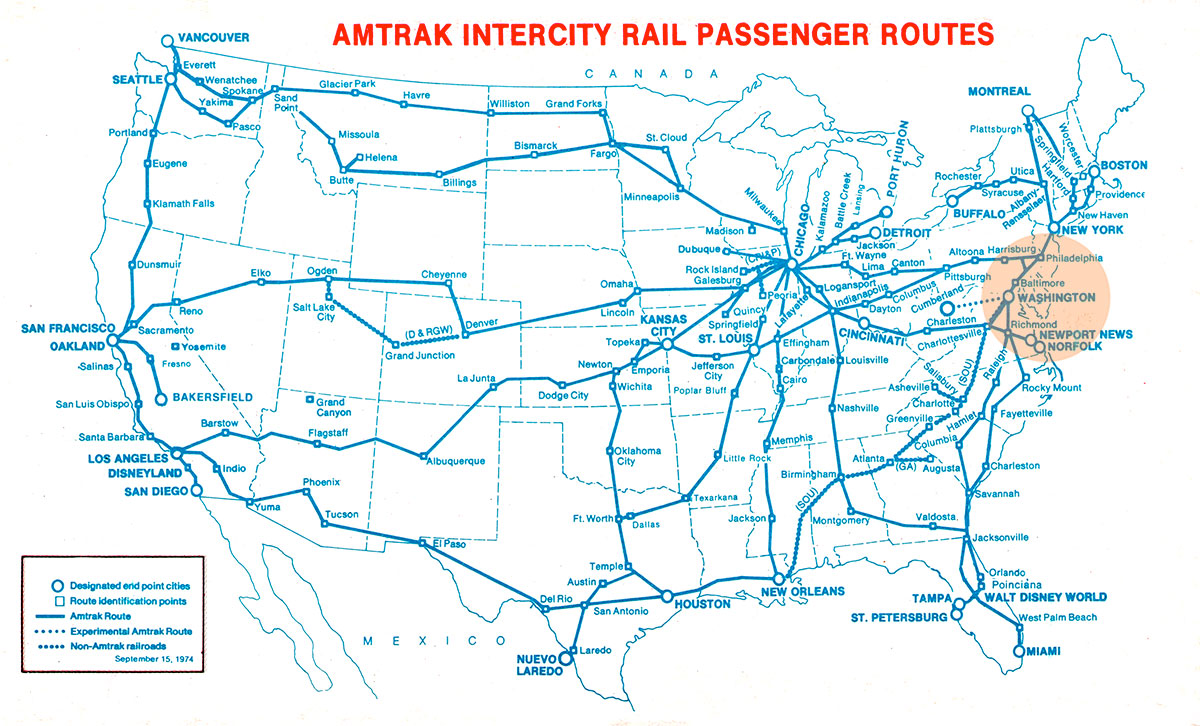
1974 Amtrak timetable map / collection
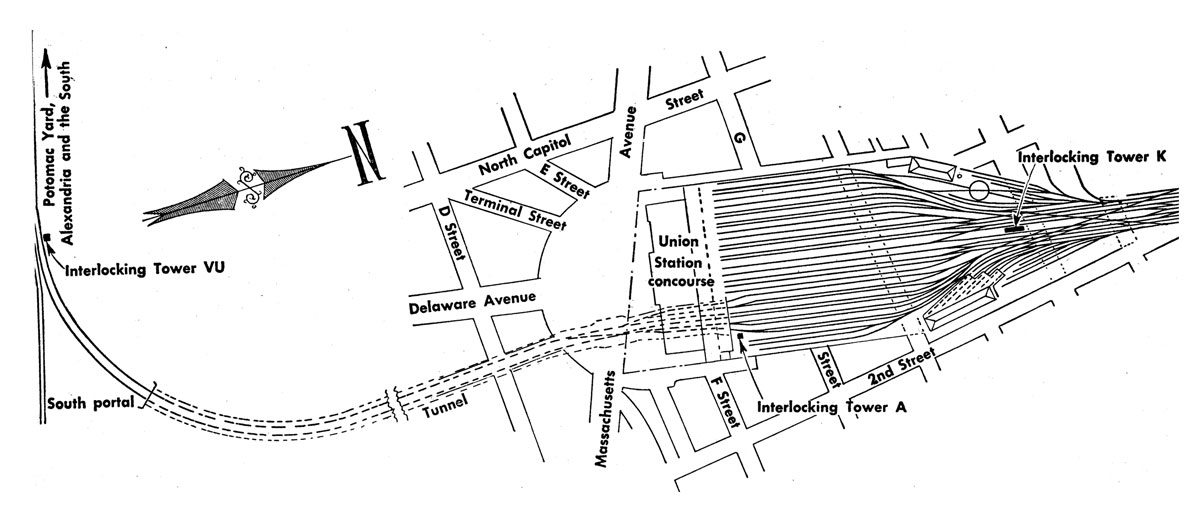
Union track diagram / Wikipedia
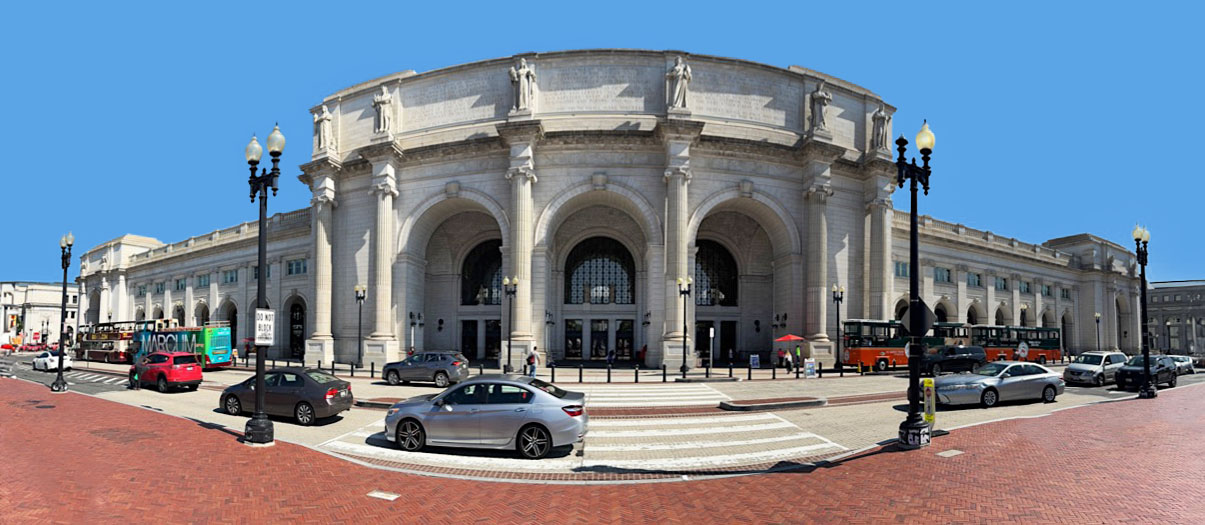
Washington, DC / Aug 2024 / RWH

 ashington, D.C.’s Union Station was built jointly by the Pennsylvania (PRR) and Baltimore & Ohio (B&O) Railroads on an area of swampland near the U.S. Capitol Building. The station, designed by architect Daniel Burnham, opened with the arrival of a B&O Railroad passenger train from Pittsburgh on October 27, 1907. A magnificent gateway to our nation’s capital, the station has served the needs of the traveling public continuously since that year.
ashington, D.C.’s Union Station was built jointly by the Pennsylvania (PRR) and Baltimore & Ohio (B&O) Railroads on an area of swampland near the U.S. Capitol Building. The station, designed by architect Daniel Burnham, opened with the arrival of a B&O Railroad passenger train from Pittsburgh on October 27, 1907. A magnificent gateway to our nation’s capital, the station has served the needs of the traveling public continuously since that year.
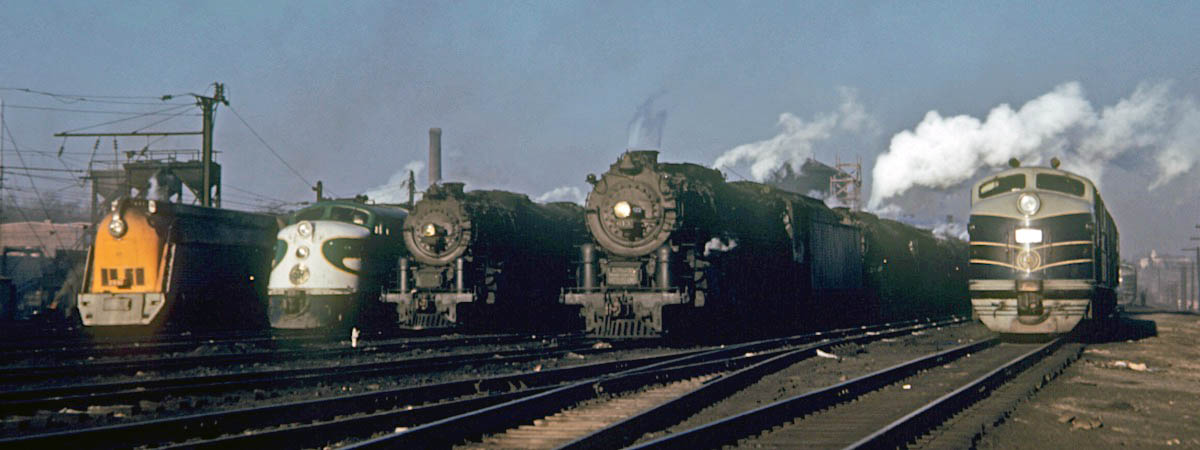 Besides the B&O and PRR, the station also served the Chesapeake & Ohio, Southern, Richmond, Fredericksburg, and Potomac (RF & P), Atlantic Coast Line, and Seaboard Railroads. The Pullman Company and the Railway Express Agency also had substantial presences.
Besides the B&O and PRR, the station also served the Chesapeake & Ohio, Southern, Richmond, Fredericksburg, and Potomac (RF & P), Atlantic Coast Line, and Seaboard Railroads. The Pullman Company and the Railway Express Agency also had substantial presences.
During World War II as many as 200,000 passengers a day passed through the station. The USO operated a canteen in the station during the War.
During the 1980s the station underwent a major renovation, costing over $160 Million Dollars. Completed in 1988, the effort restored the station’s grandeur and remade it into a transportation, shopping, and dining megaplex. The station is now served by Amtrak, VRE, MARC, Metro (red line), several bus companies, and the DC Street car.

postcard / collection
Front Façade
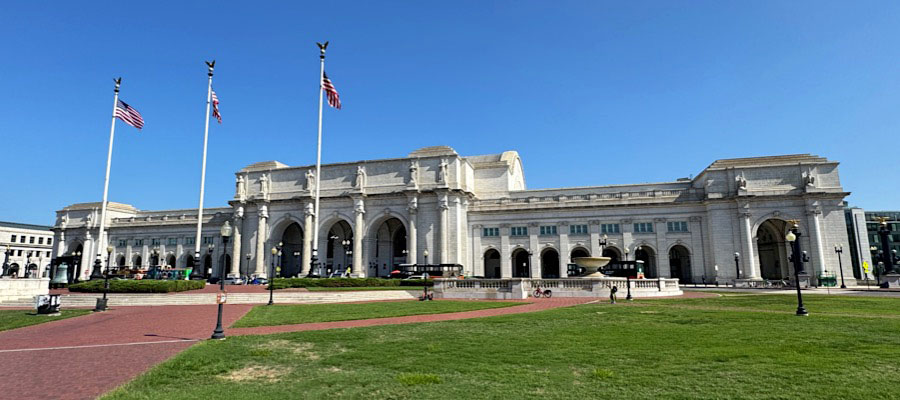
Washington DC / Aug 2024 / RWH

Click to see Amtrak's Washington Union Station plotted on a Google Maps page
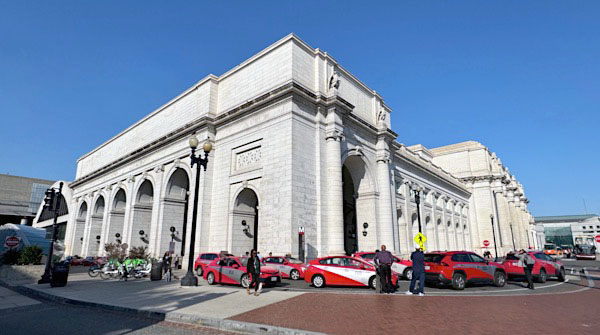
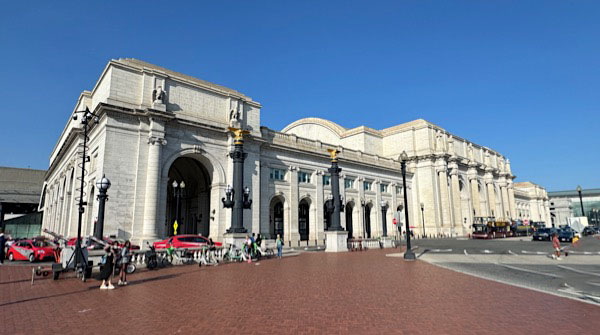
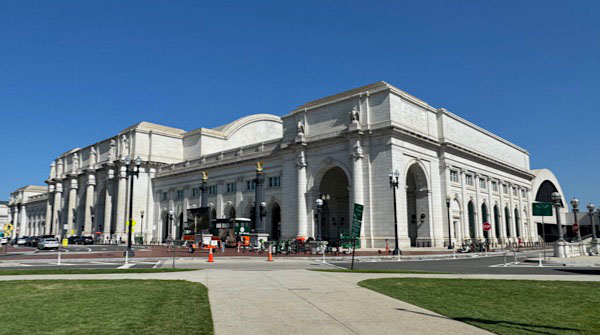
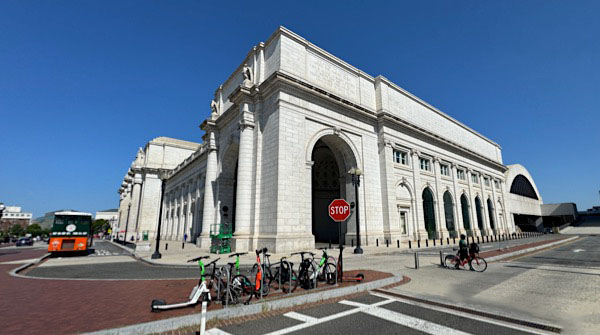
Washington DC / Aug 2024 / RWH

Washington DC / Aug 2024 / RWH
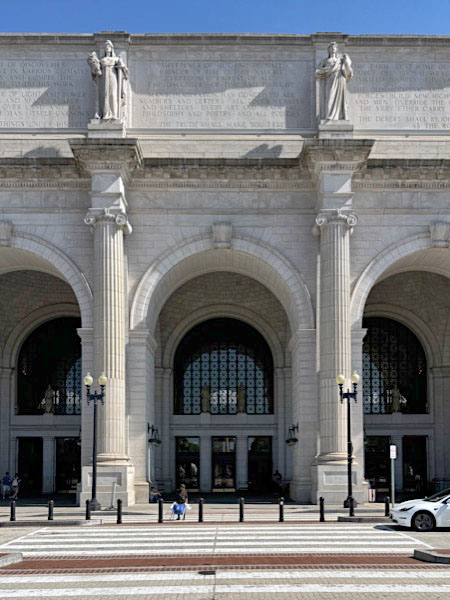
Aug 2024 / RWH

postcard / collection
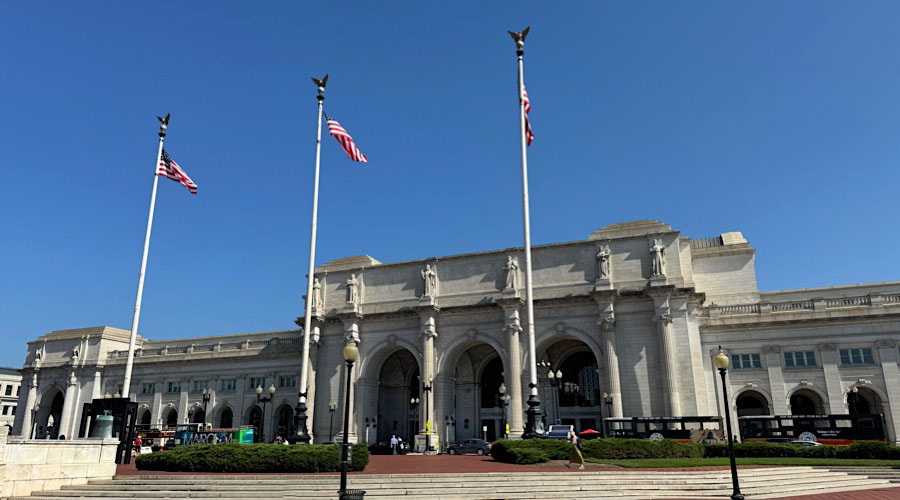
Washington DC / Aug 2024 / RWH
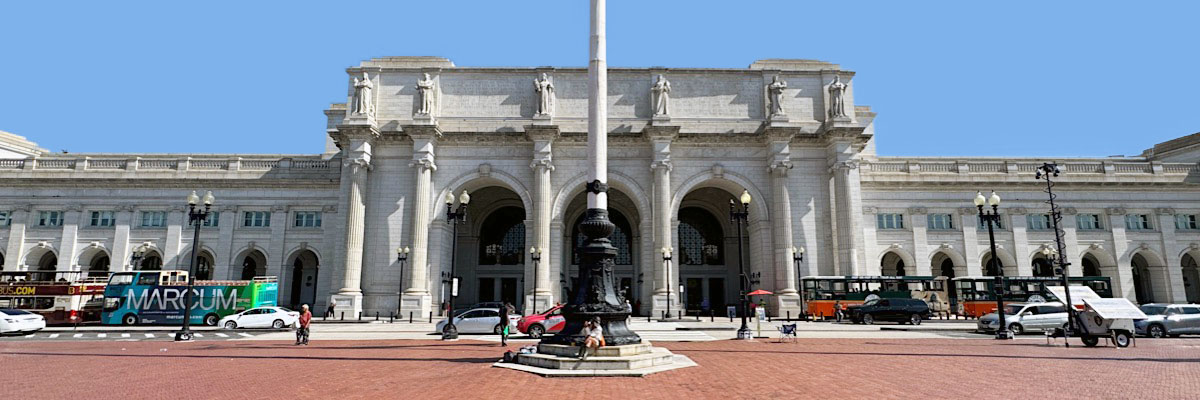
Washington DC / Aug 2024 / RWH

Wikipedia

Aug 2024 / RWH
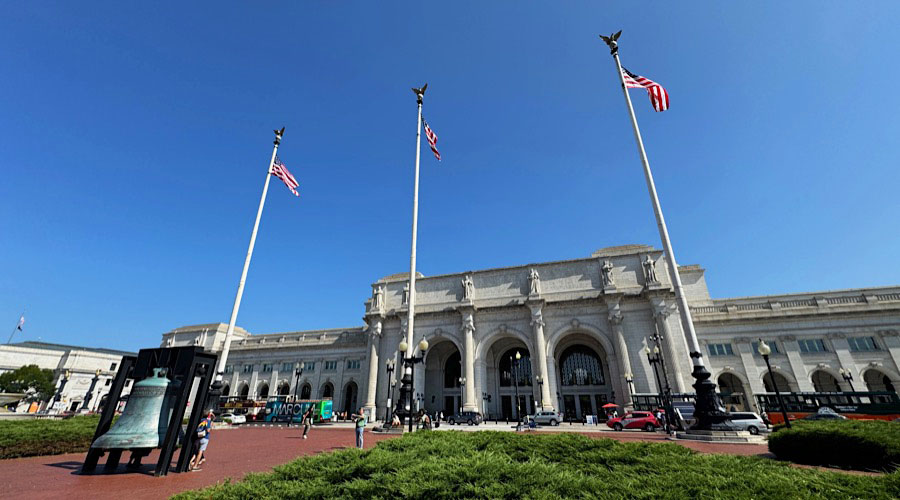
Washington DC / Aug 2024 / RWH
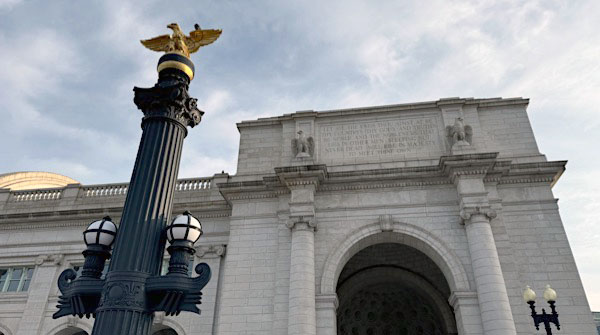
Aug 2024 / RWH
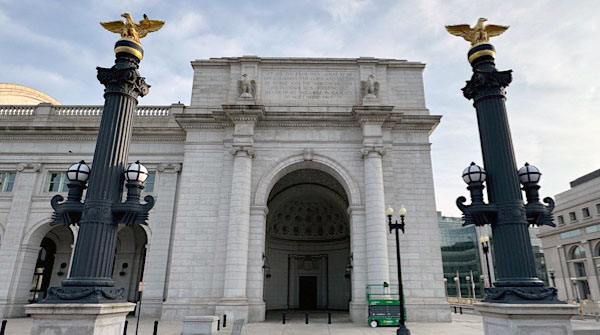
Aug 2024 / RWH
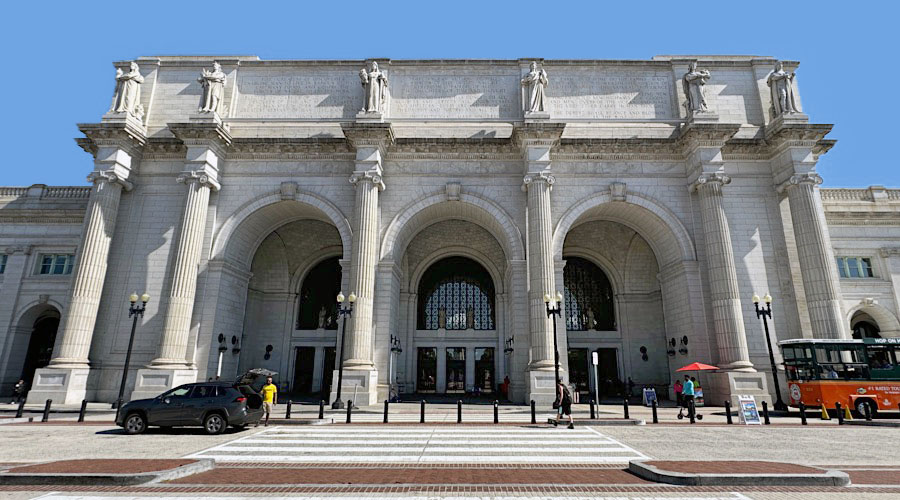
Aug 2024 / RWH

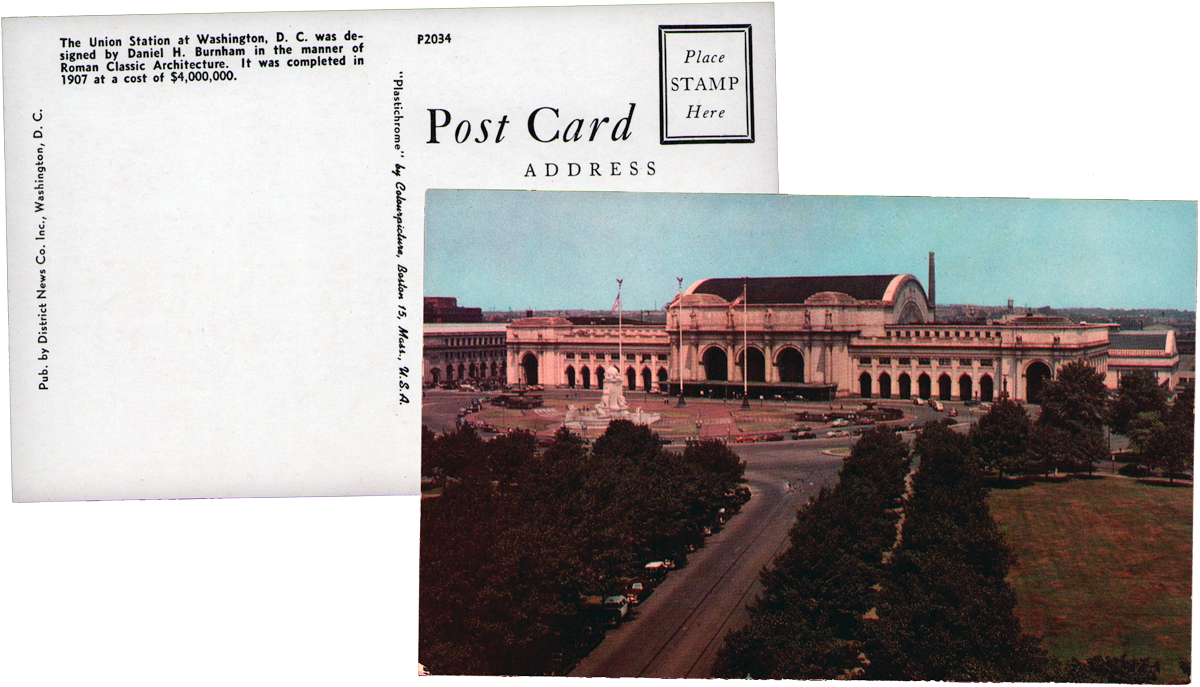
postcard / collection

Washington DC / Aug 2024 / RWH

Washington DC / Aug 2024 / RWH
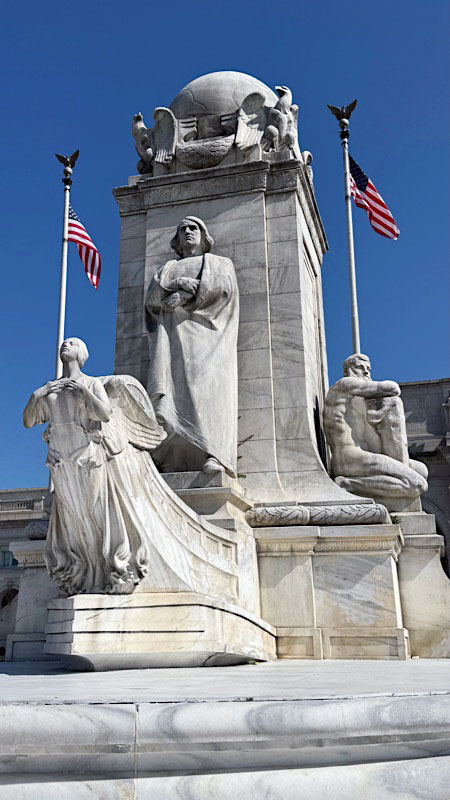
Aug 2024 / RWH

Aug 2024 / RWH
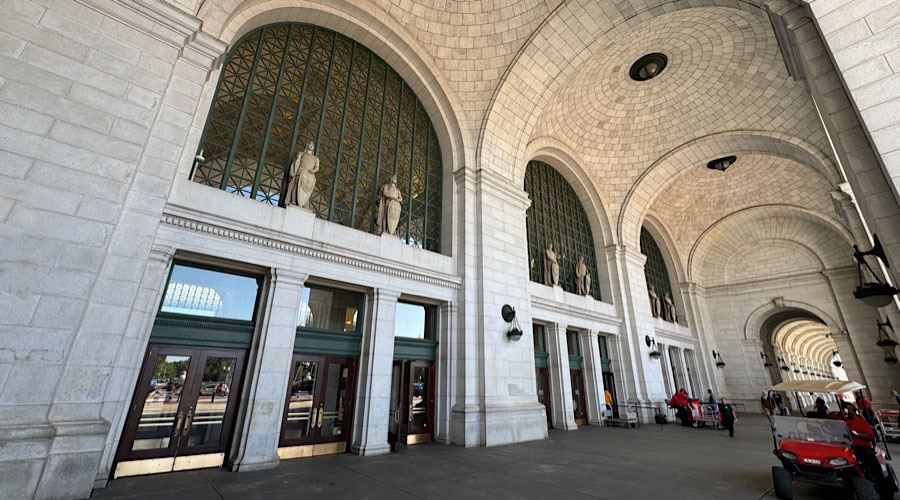
Aug 2024 / RWH

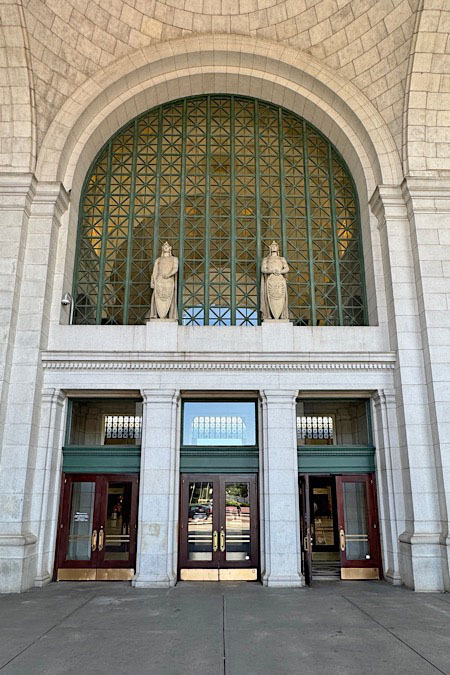
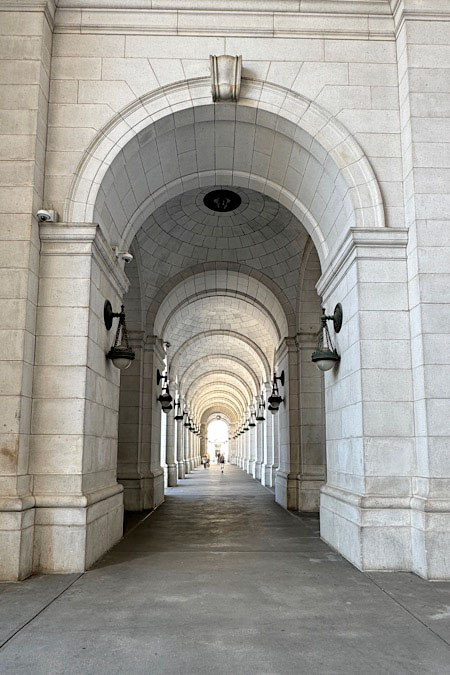
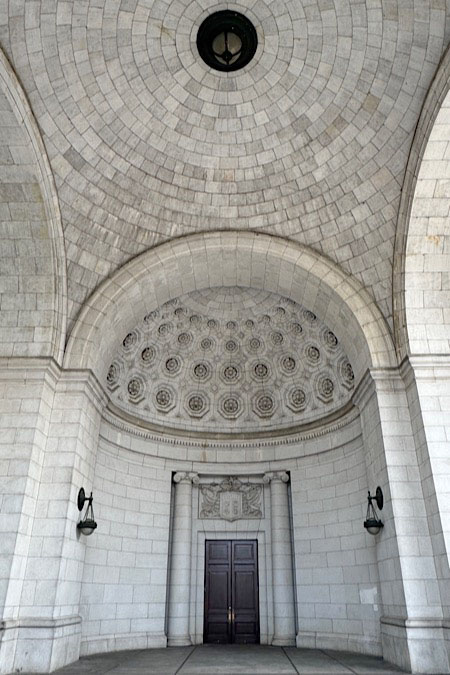
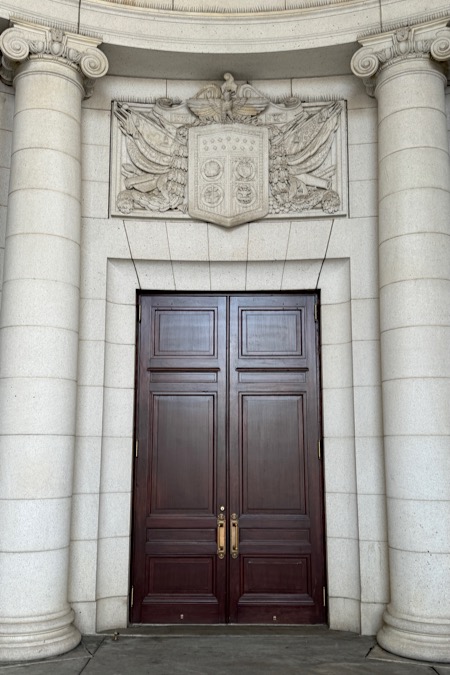

Aug 2024 / RWH
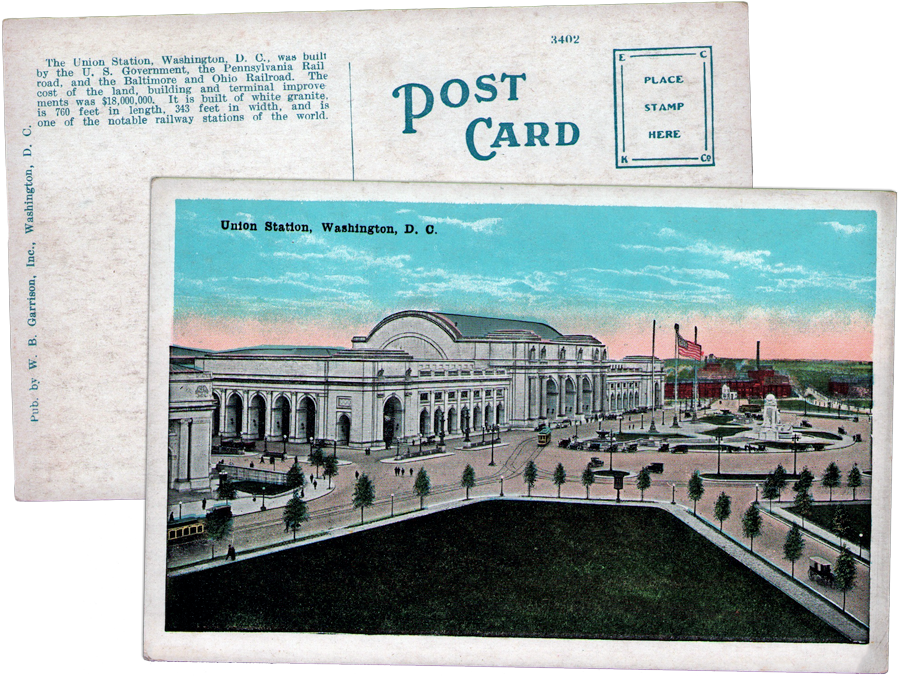
postcard / collection

Aug 2024 / RWH
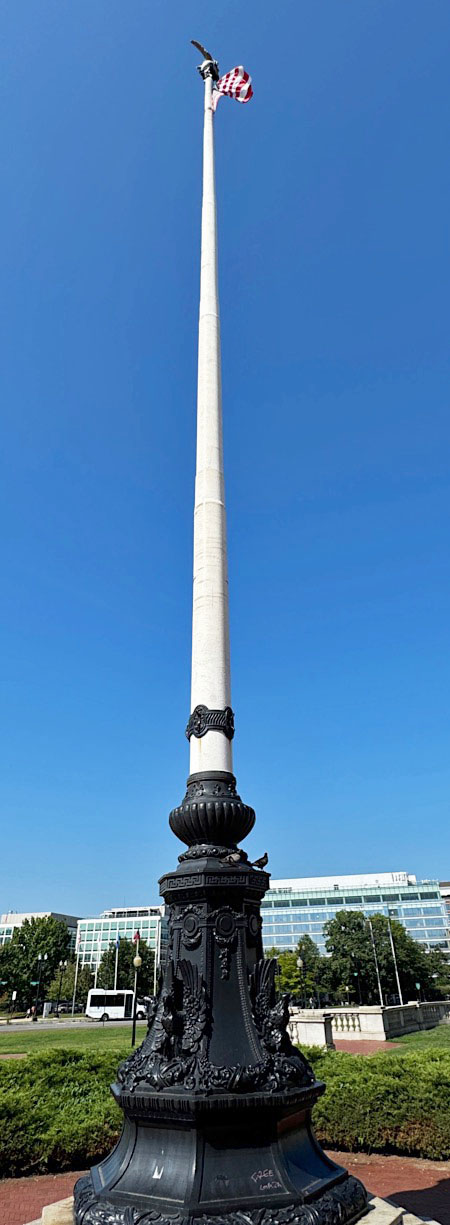
Aug 2024 / RWH
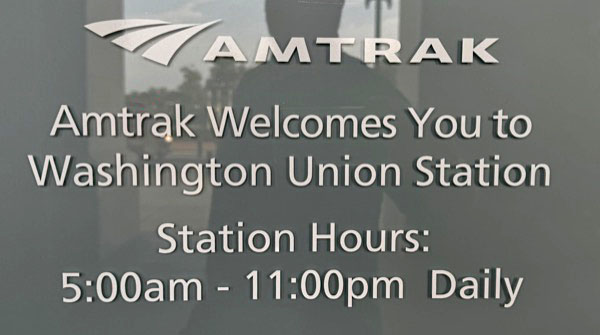
Aug 2024 / RWH
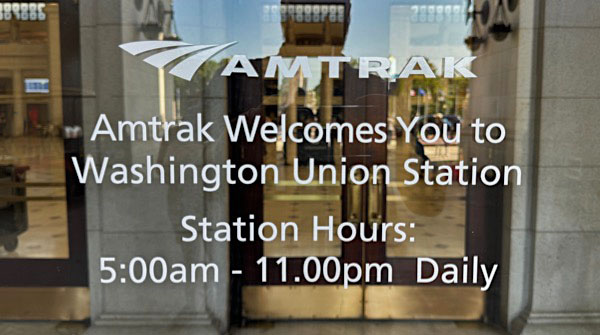
Aug 2024 / RWH
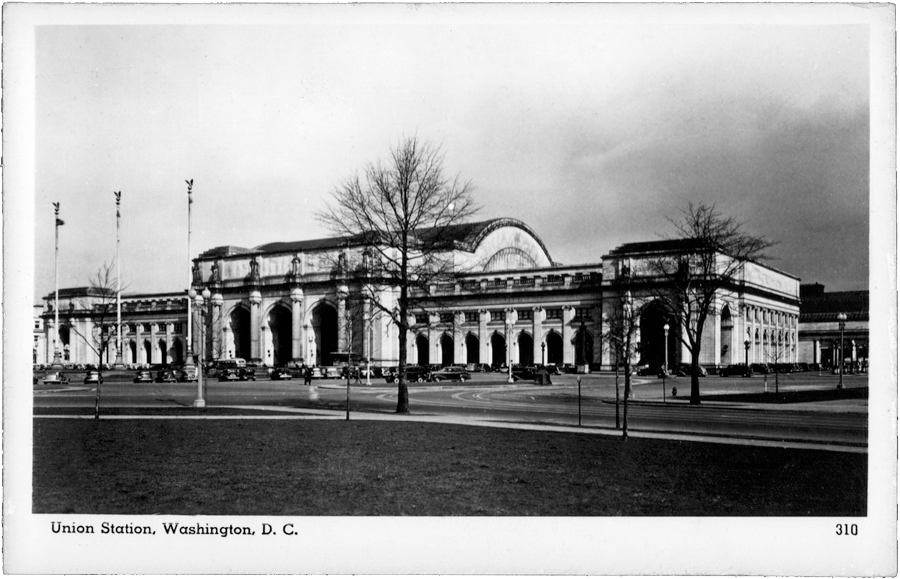
postcard / collection
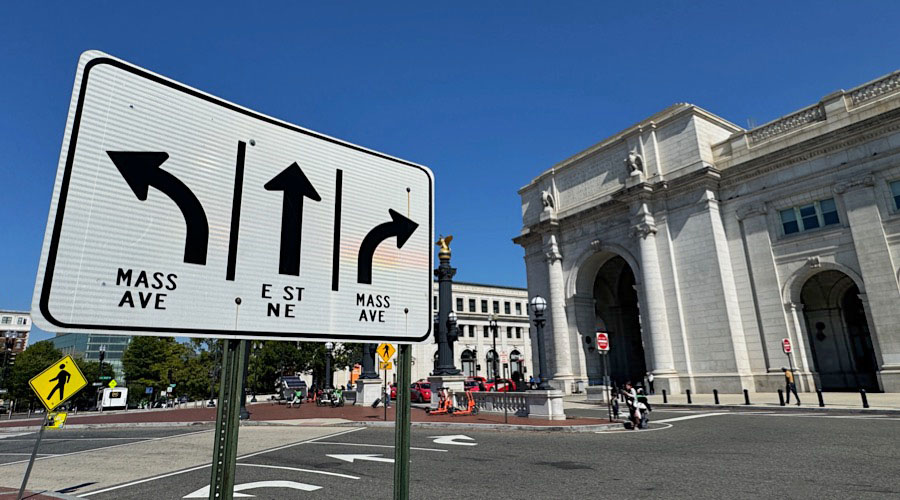
Washington DC / Aug 2024 / RWH
 Union @ Night
Union @ Night

Washington DC / Aug 2024 / RWH
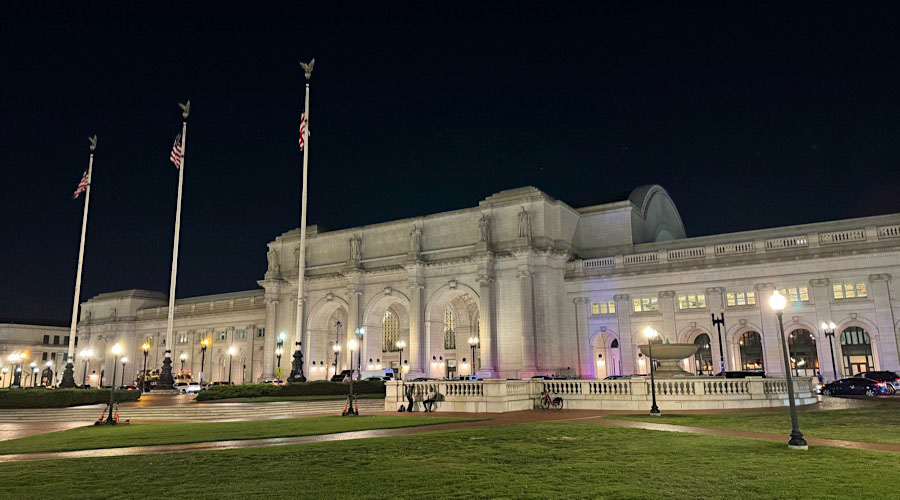
Washington DC / Aug 2024 / RWH
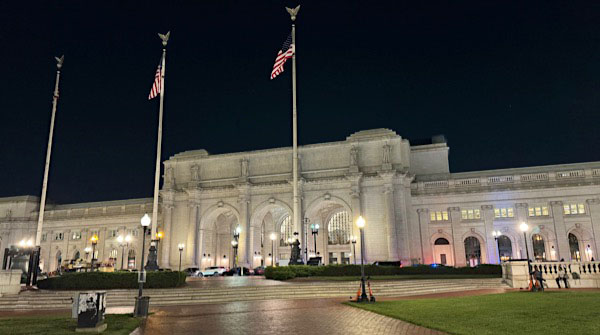
Washington DC / Aug 2024 / RWH
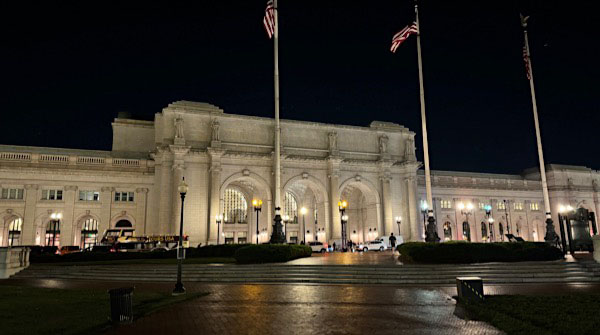
Washington DC / Aug 2024 / RWH

Washington DC / Aug 2024 / RWH
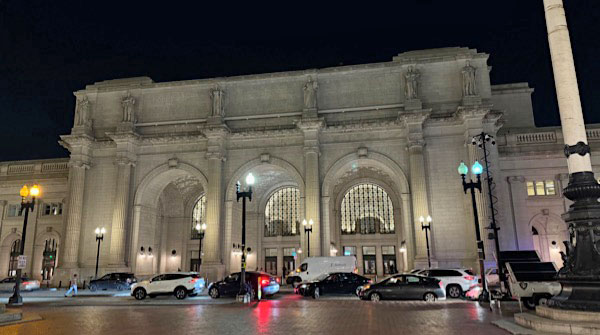
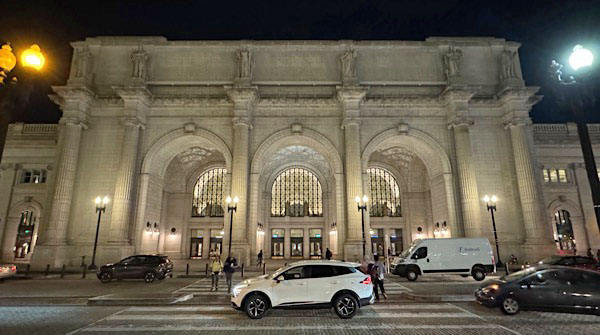

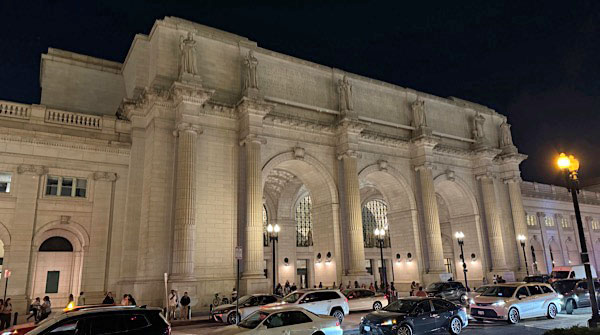
Aug 2024 / RWH

Washington DC / Aug 2024 / RWH
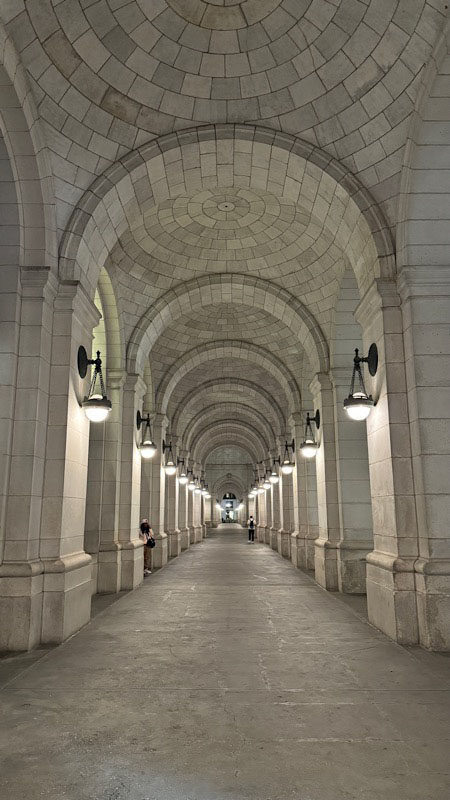
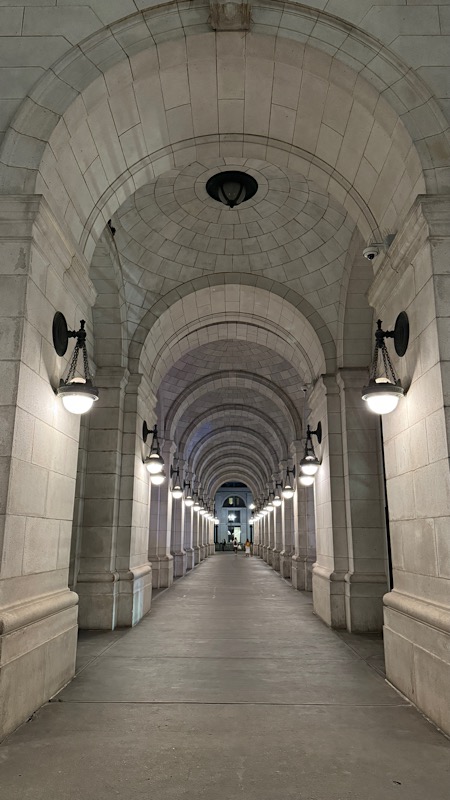

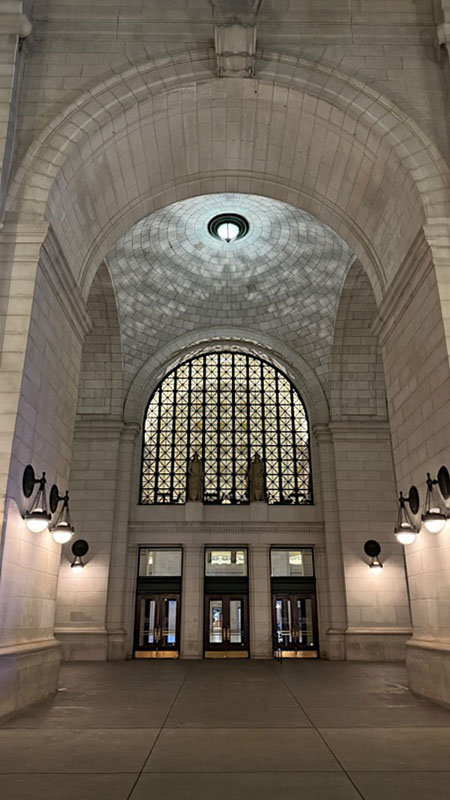
Aug 2024 / RWH
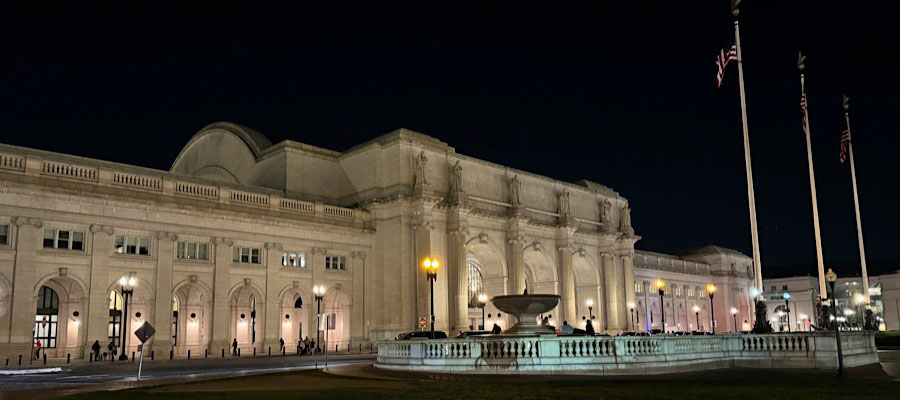
Washington DC / Aug 2024 / RWH
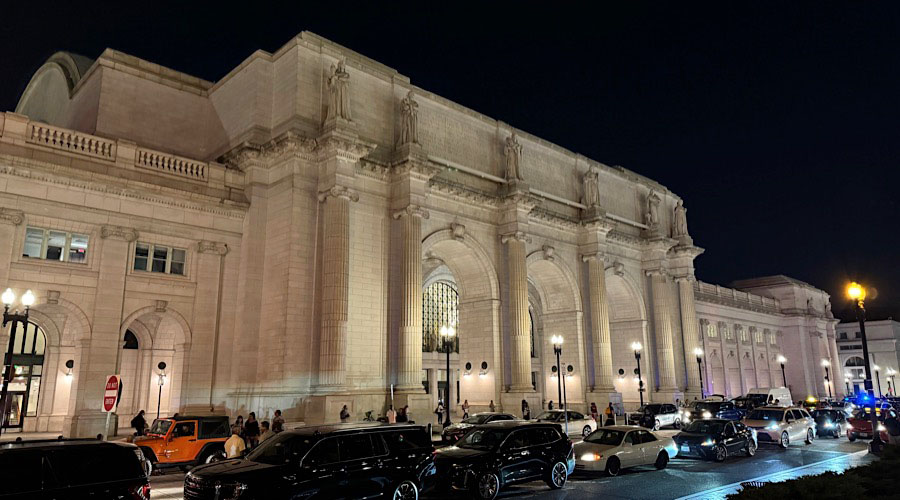
Washington DC / Aug 2024 / RWH
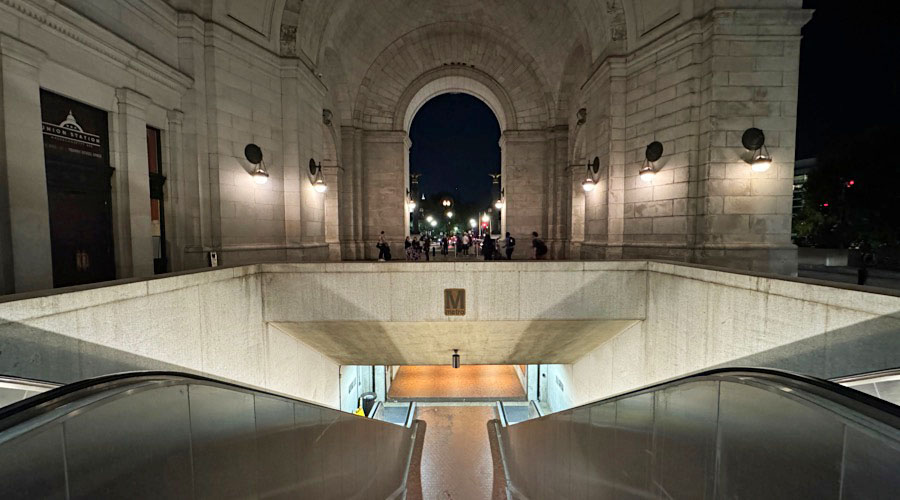
Aug 2024 / RWH

Aug 2024 / RWH
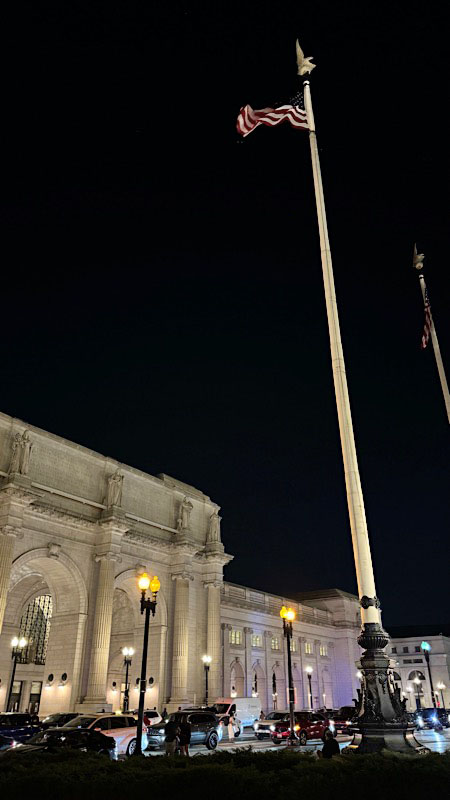
Aug 2024 / RWH

Aug 2024 / RWH
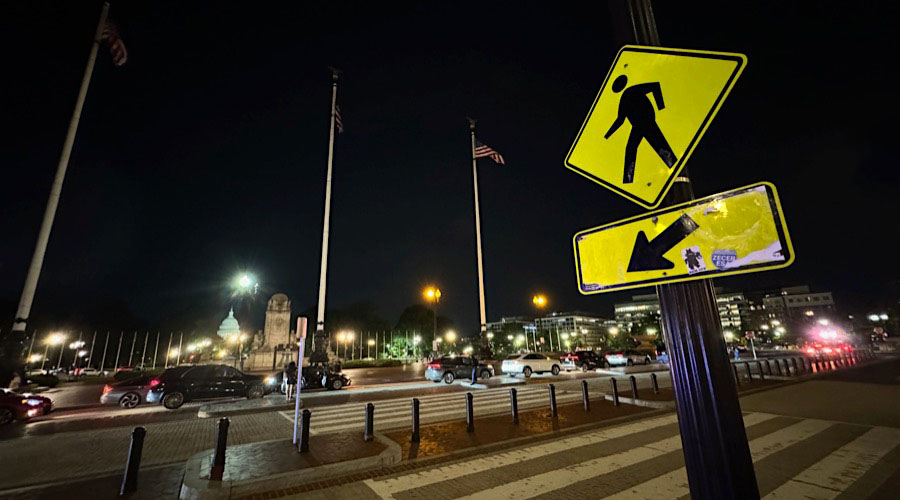
Washington DC / Aug 2024 / RWH

postcard / collection
Main Hall
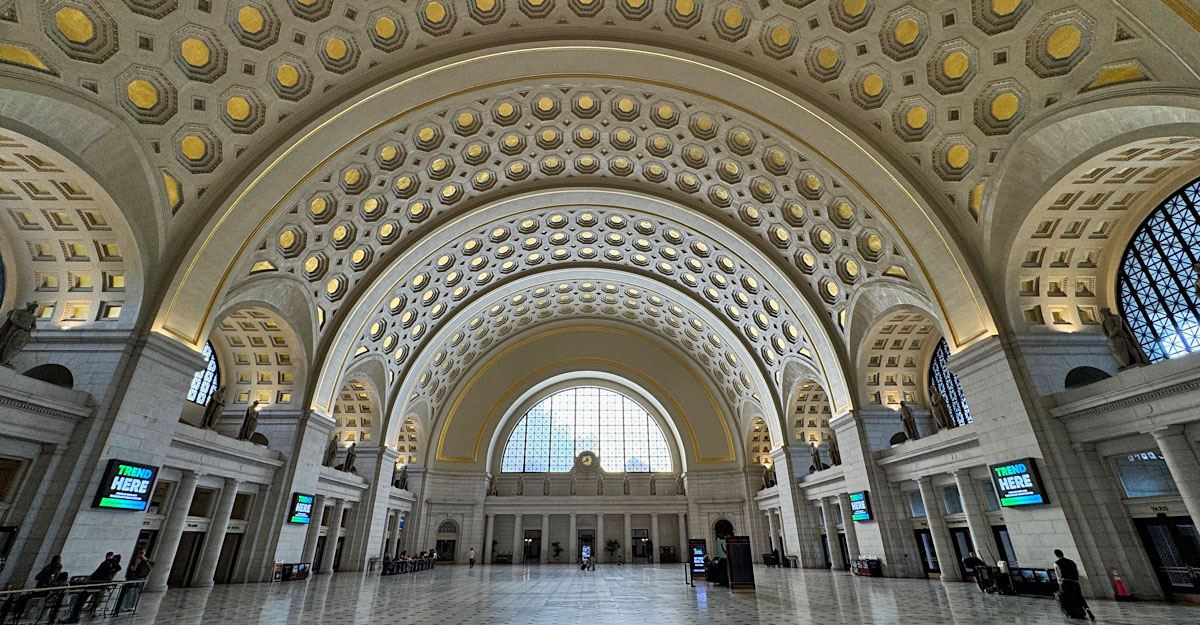
Aug 2024 / RWH
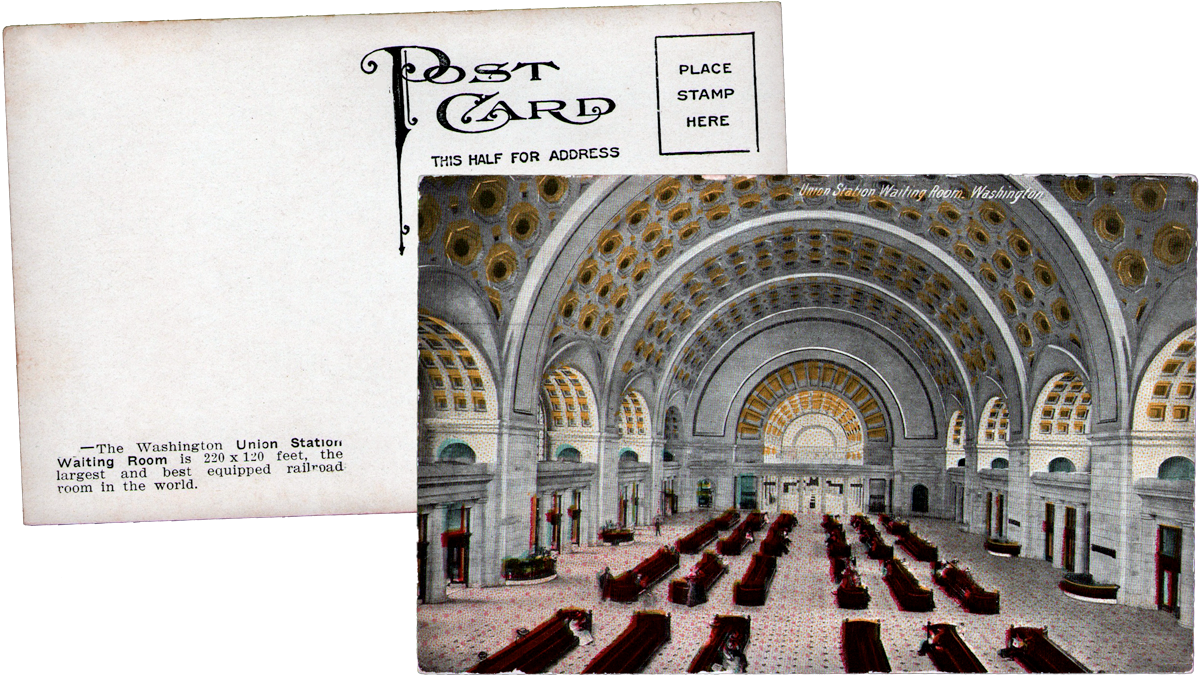
postcard / collection

Aug 2024 / RWH

Aug 2024 / RWH

Aug 2024 / RWH

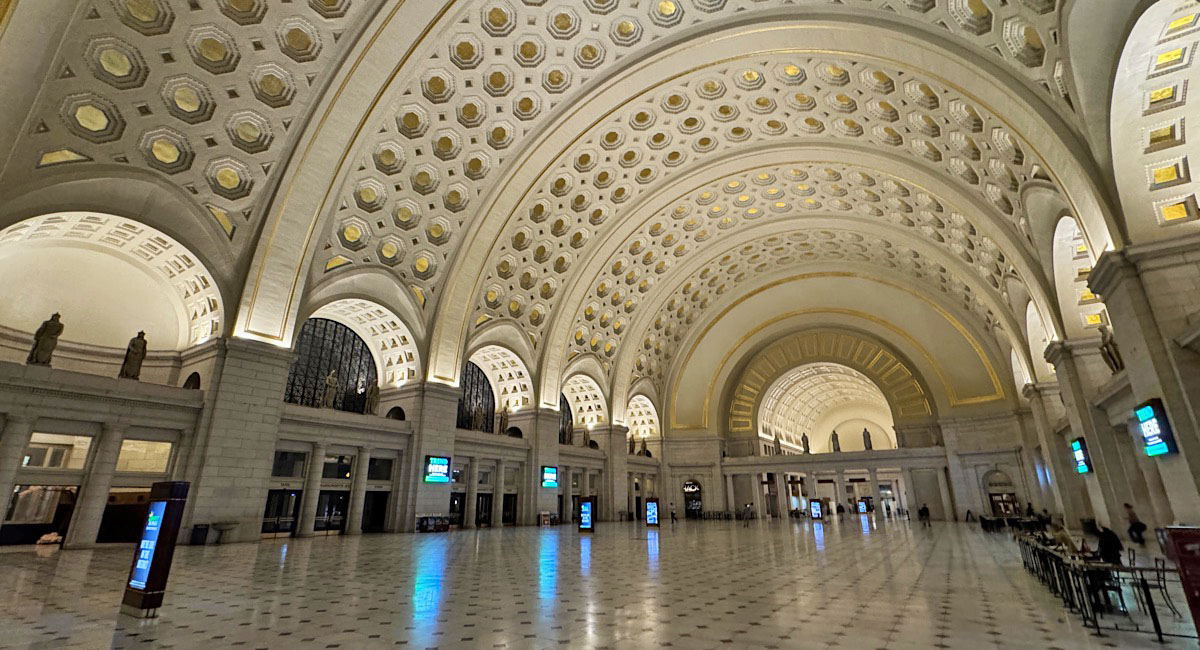
Aug 2024 / RWH

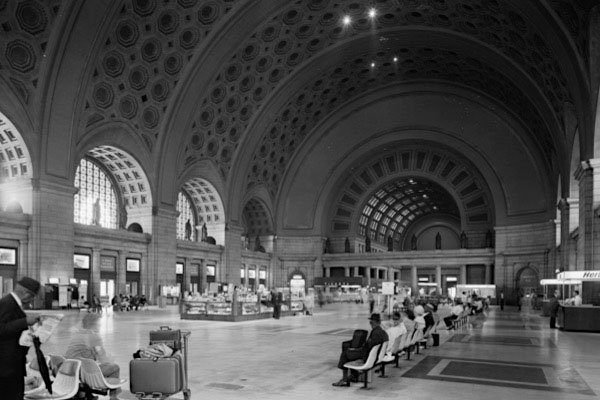
 he front of the station, on Columbus Circle, presents travelers with a soaring vaulted entryway and heroic statuary on its 600-foot length. The 96-foot high Main Hall coffered ceiling shines brilliantly with gold leaf and reflects natural light entering from the large Diocletian windows.
The former Main Concourse, now the heart of the station, lifts its barrel-vaulted glass and coffered plaster ceiling 45 feet above the main floor and stretches 760 feet long. It was once said to be the largest single room in the world. When the building first opened, it also featured a private, secure waiting room for the president and his visitors, as well as a public dining room whose walls were covered in murals modeled after those recently excavated at the ancient Roman cities of Pompeii and Herculaneum.
he front of the station, on Columbus Circle, presents travelers with a soaring vaulted entryway and heroic statuary on its 600-foot length. The 96-foot high Main Hall coffered ceiling shines brilliantly with gold leaf and reflects natural light entering from the large Diocletian windows.
The former Main Concourse, now the heart of the station, lifts its barrel-vaulted glass and coffered plaster ceiling 45 feet above the main floor and stretches 760 feet long. It was once said to be the largest single room in the world. When the building first opened, it also featured a private, secure waiting room for the president and his visitors, as well as a public dining room whose walls were covered in murals modeled after those recently excavated at the ancient Roman cities of Pompeii and Herculaneum.
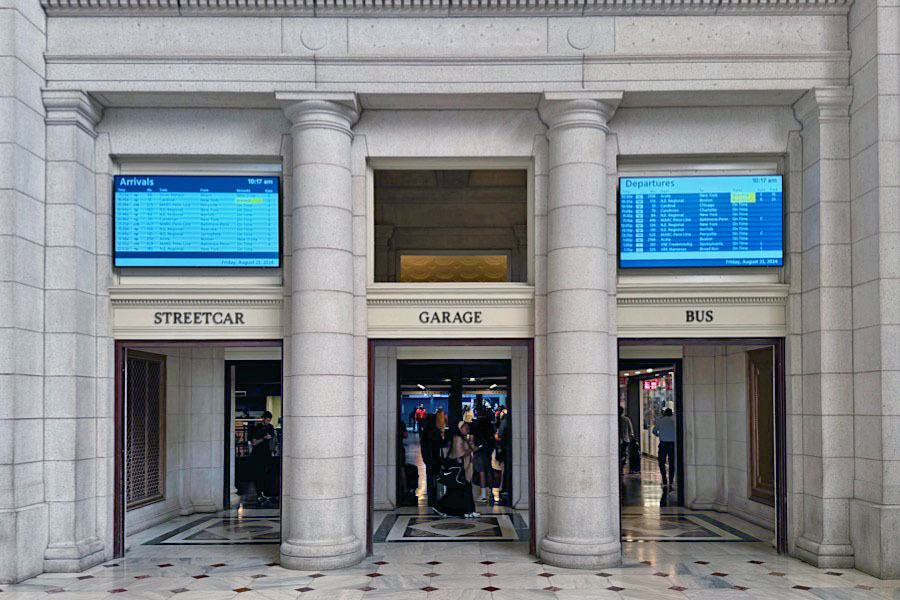
Aug 2024 / RWH

Aug 2024 / RWH

Aug 2024 / RWH


Aug 2024 / RWH


Aug 2024 / RWH

Aug 2024 / RWH
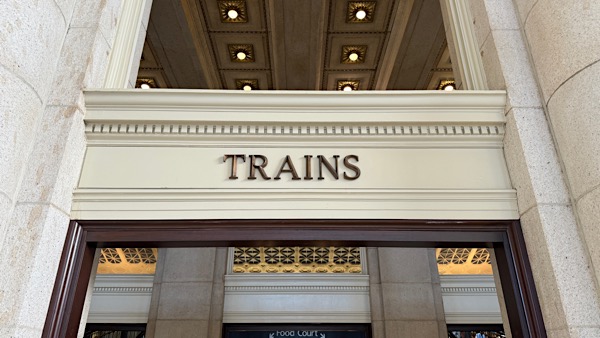
Aug 2024 / RWH
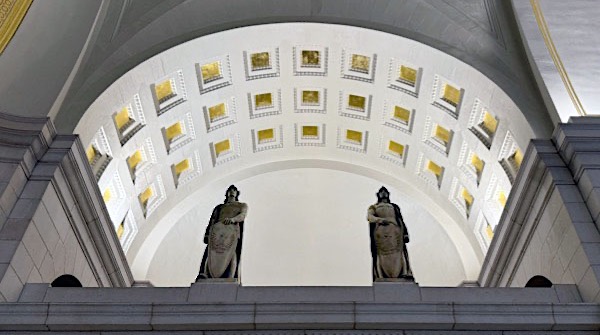
Aug 2024 / RWH

Aug 2024 / RWH
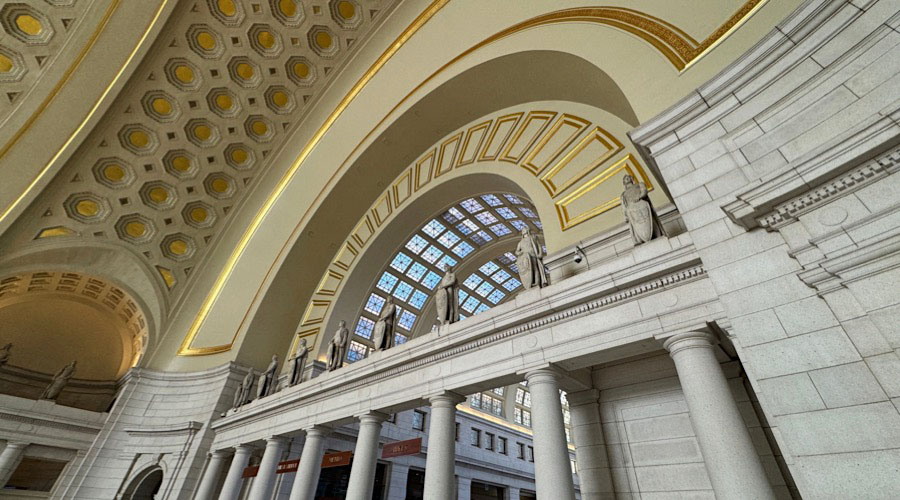
Aug 2024 / RWH
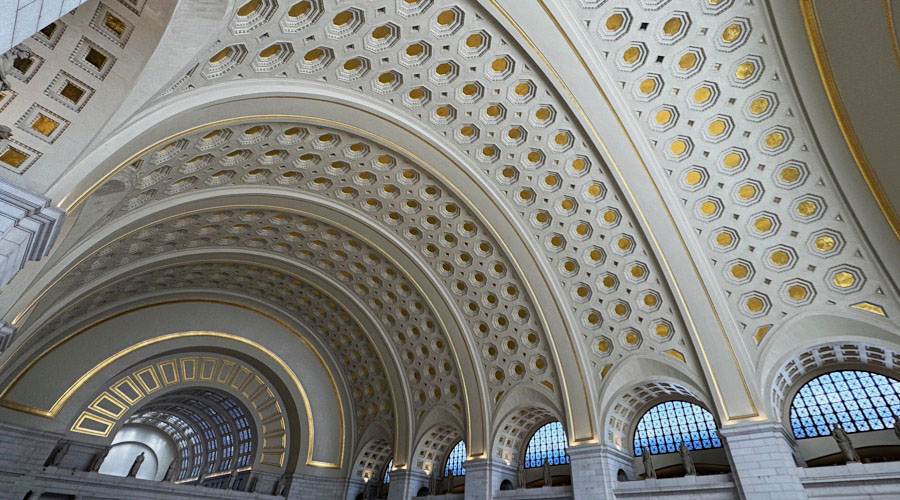
Aug 2024 / RWH
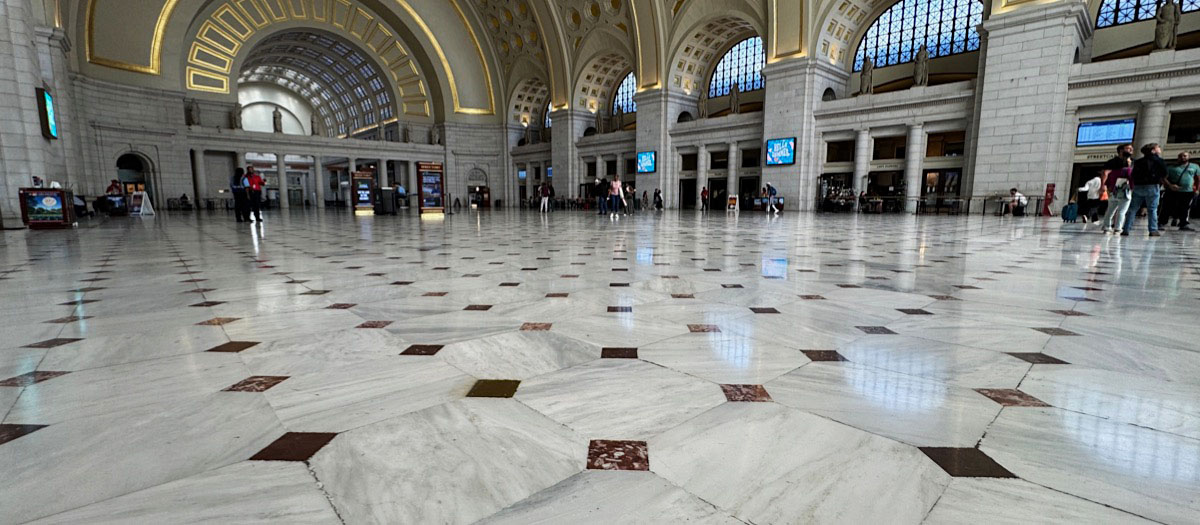
Aug 2024 / RWH
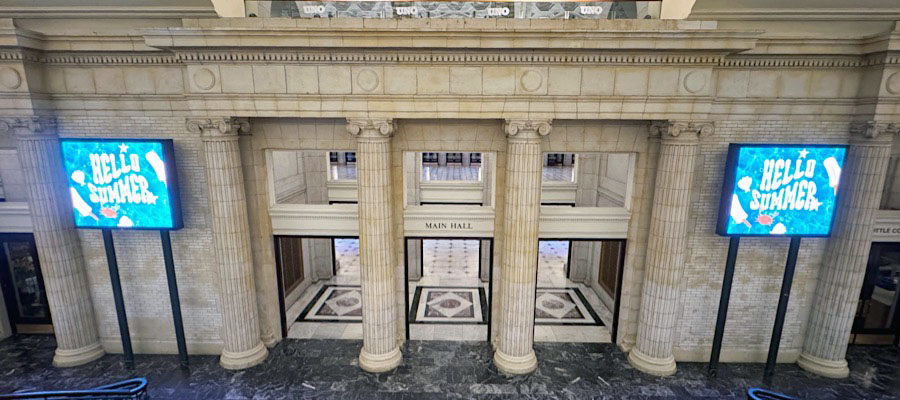
Aug 2024 / RWH
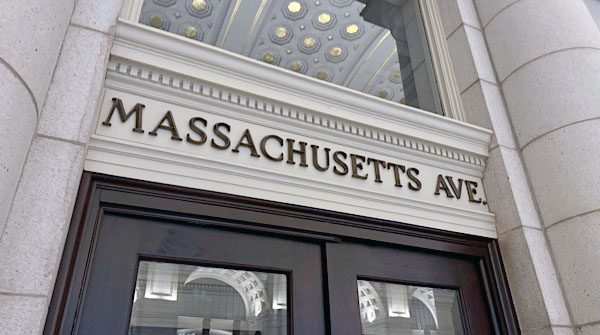
Aug 2024 / RWH
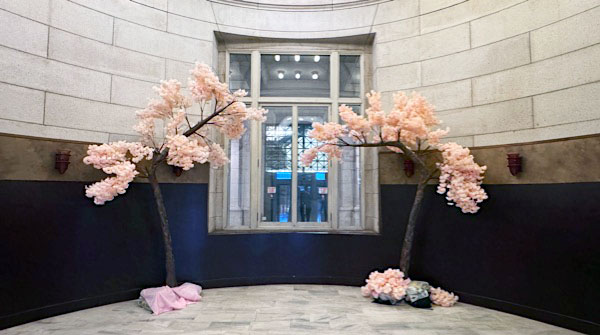
Aug 2024 / RWH

 he station has evolved through a vivid history of bustling use during its early years, to a period of decline, to a three year, $160 million restoration completed in 1988 that is still cited as one of the nation’s most successful examples of adaptive reuse through a private-public partnership. Coordinating this effort was the Union Station Redevelopment Corporation (USRC), a non-profit organization created in 1983 to preserve and restore the station’s historic and architectural significance, preserve its long-term function as a multi-use transportation center and enhance the retail and amenities.
he station has evolved through a vivid history of bustling use during its early years, to a period of decline, to a three year, $160 million restoration completed in 1988 that is still cited as one of the nation’s most successful examples of adaptive reuse through a private-public partnership. Coordinating this effort was the Union Station Redevelopment Corporation (USRC), a non-profit organization created in 1983 to preserve and restore the station’s historic and architectural significance, preserve its long-term function as a multi-use transportation center and enhance the retail and amenities.
Key improvements undertaken during the 1980s rehabilitation project included introduction of a mezzanine level within the Concourse that provided expanded retail opportunities; creation of a food court in the basement; the addition of dedicated areas for Amtrak seating and signage; restoration of the floors in the West, East and Main Halls; restoration of exterior walls, doors, and windows; upgrades to the exterior lighting; and installation of a public elevator to connect all three levels of the station.
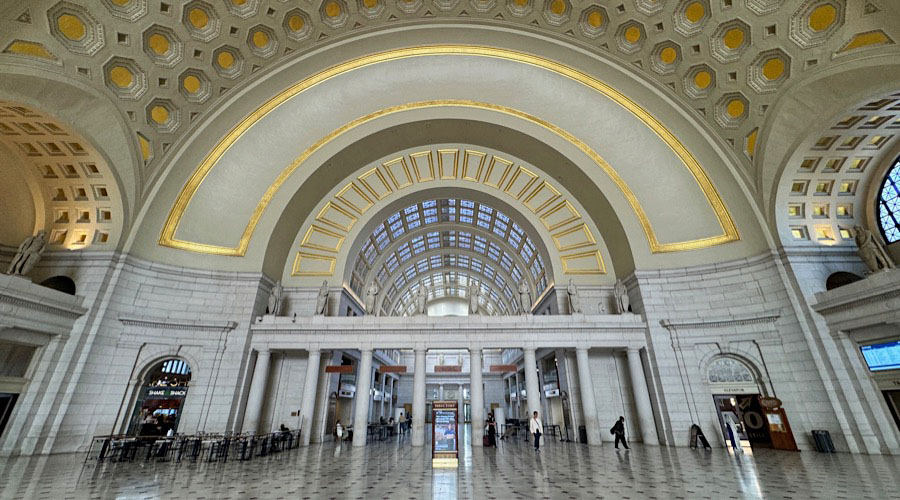
Aug 2024 / RWH
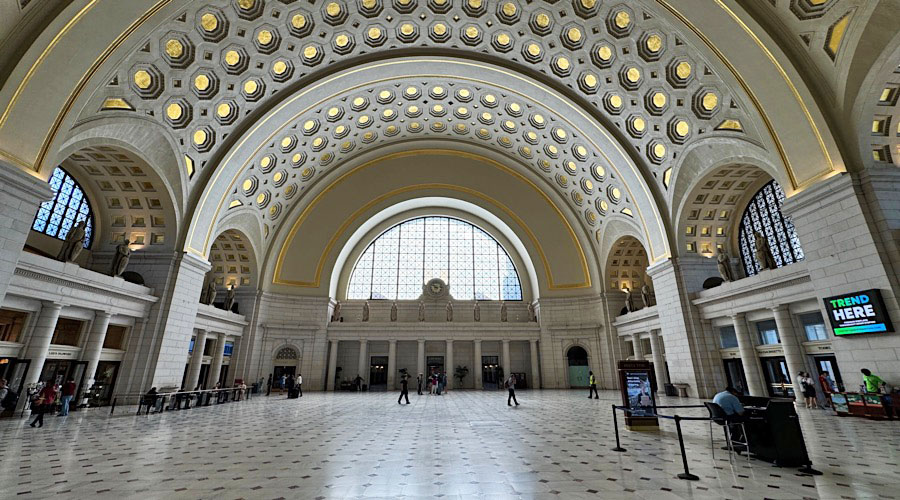
Aug 2024 / RWH
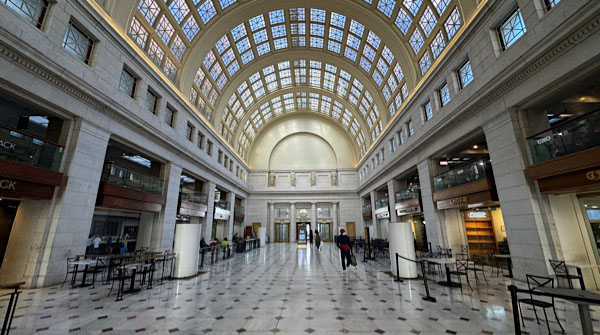
Aug 2024 / RWH
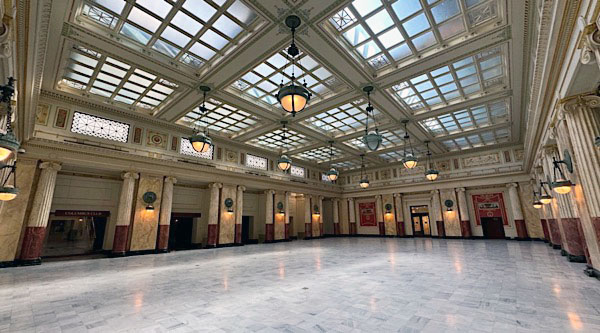
Aug 2024 / RWH
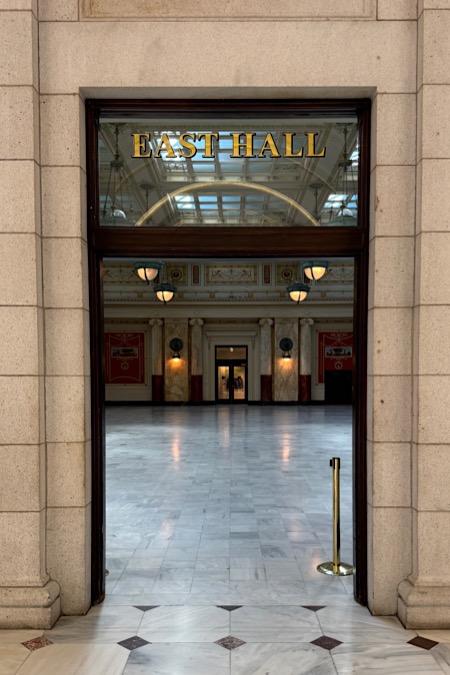
Aug 2024 / RWH
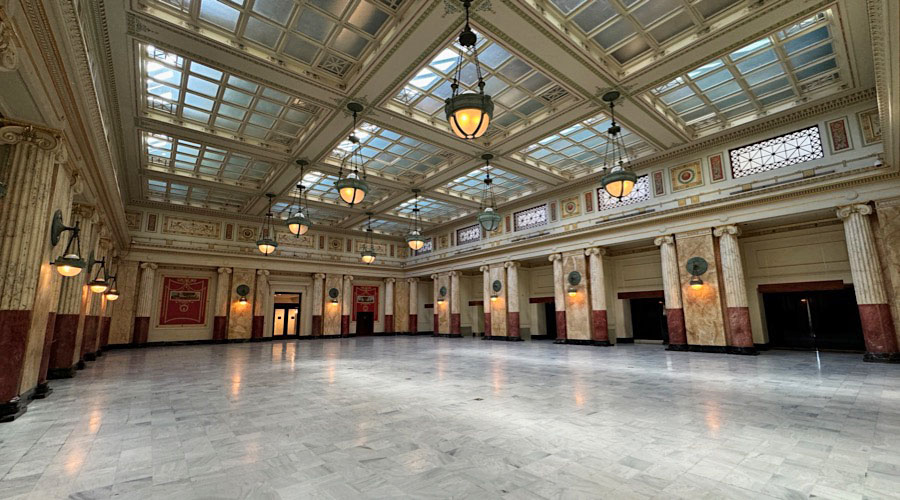
Aug 2024 / RWH
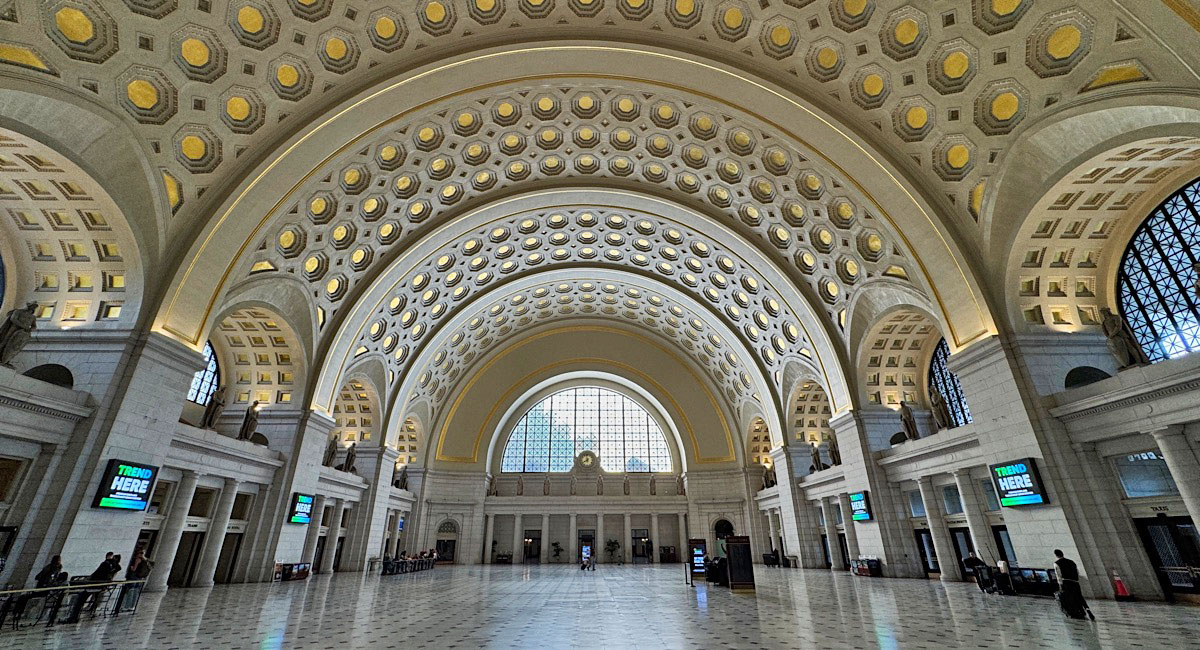
Aug 2024 / RWH
Interior Levels
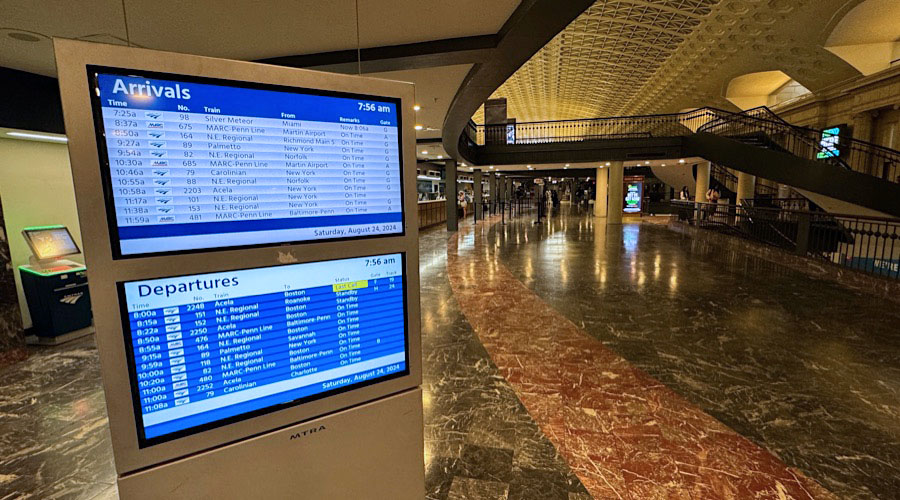
Aug 2024 / RWH

Aug 2024 / RWH
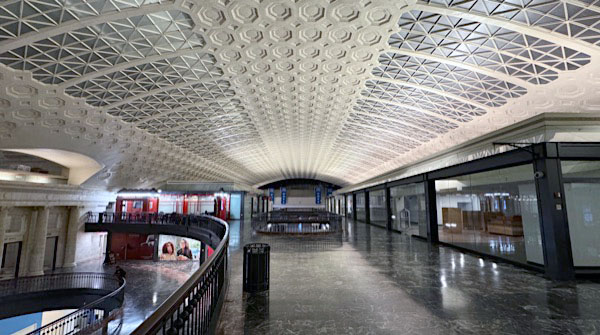
Aug 2024 / RWH
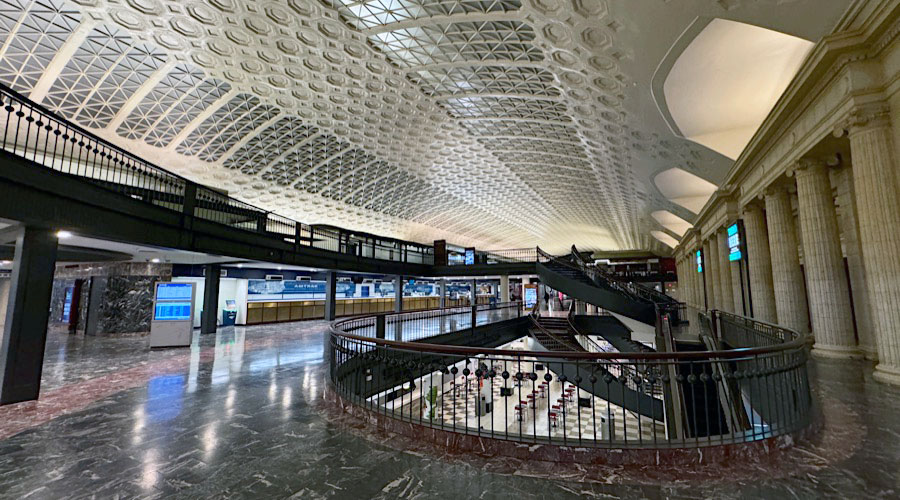
Aug 2024 / RWH

Aug 2024 / RWH

Aug 2024 / RWH
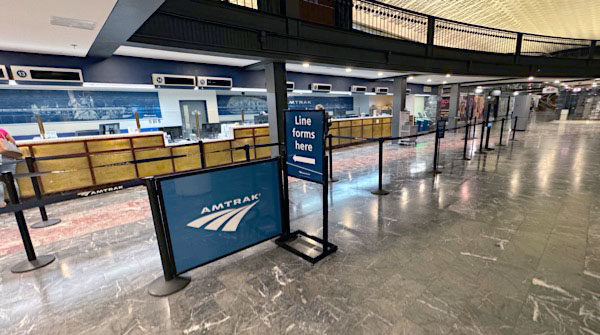
Aug 2024 / RWH
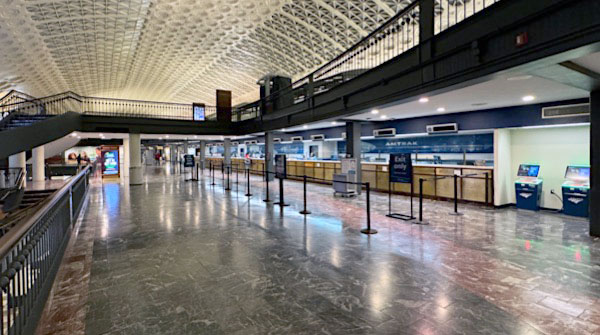
Aug 2024 / RWH
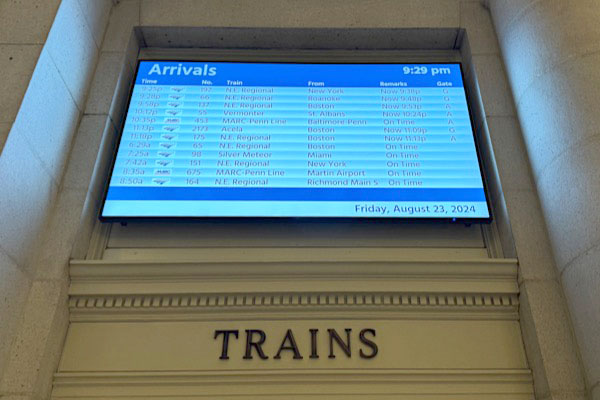
Aug 2024 / RWH

Aug 2024 / RWH
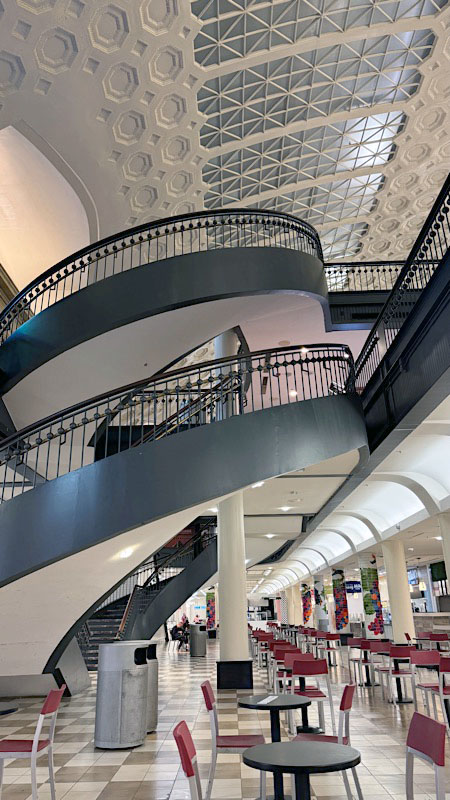
Aug 2024 / RWH

Aug 2024 / RWH
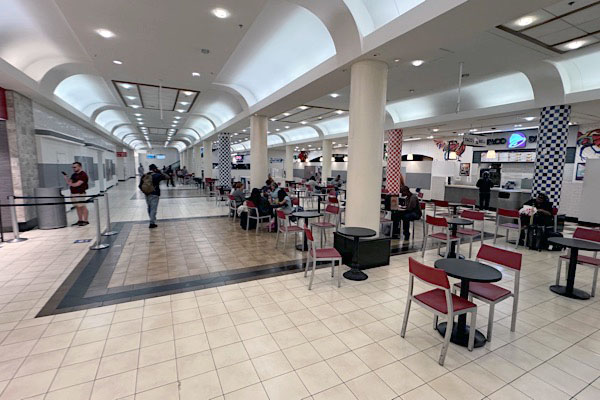
Aug 2024 / RWH
 Claytor Concourse
Claytor Concourse
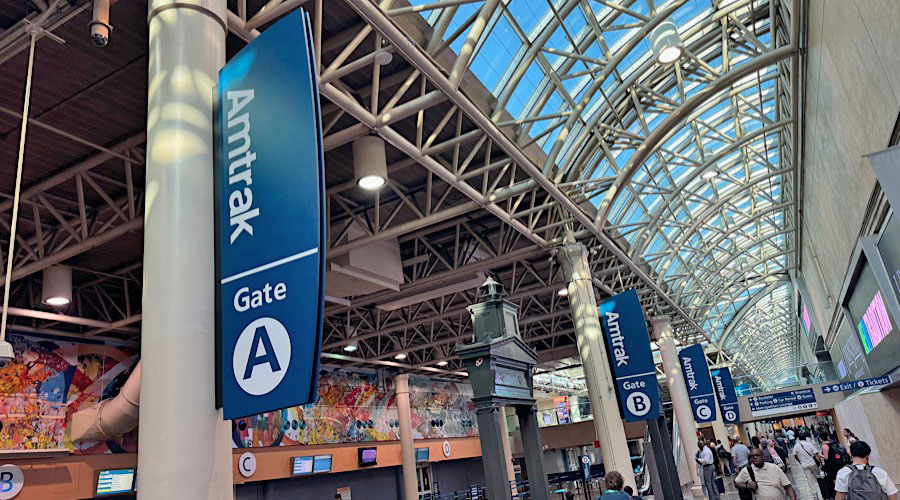
Aug 2024 / RWH
The food court still retains the original arches under which the trains were parked as well as the track numbers on those arches. A variety of shops opened along the Concourse and Main Hall, and a new Amtrak terminal at the back behind the original Concourse. Trains no longer enter the original Concourse, but the original, decorative gates were relocated to the new passenger concourse. In 1994, this new passenger concourse was renamed to honor W. Graham Claytor Jr., who served as Amtrak's president from 1982 to 1993. The decorative elements of the station were also restored. The skylights were preserved, but sunlight no longer illuminates the Concourse because it is blocked by the newer roof structure built directly overhead to support the aging, original structure.
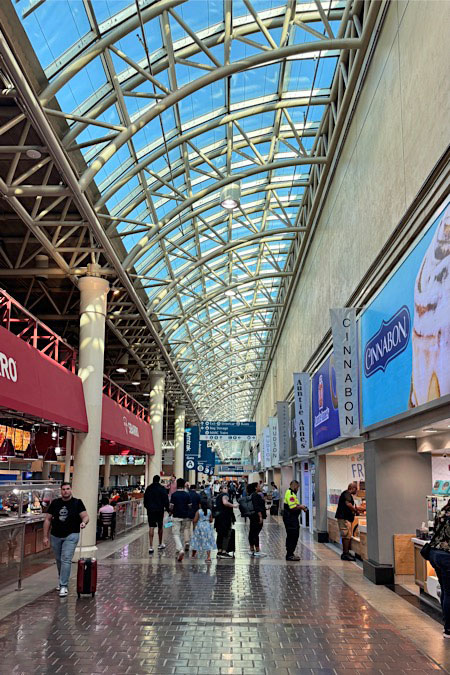
Aug 2024 / RWH

Aug 2024 / RWH

Aug 2024 / RWH

RWH
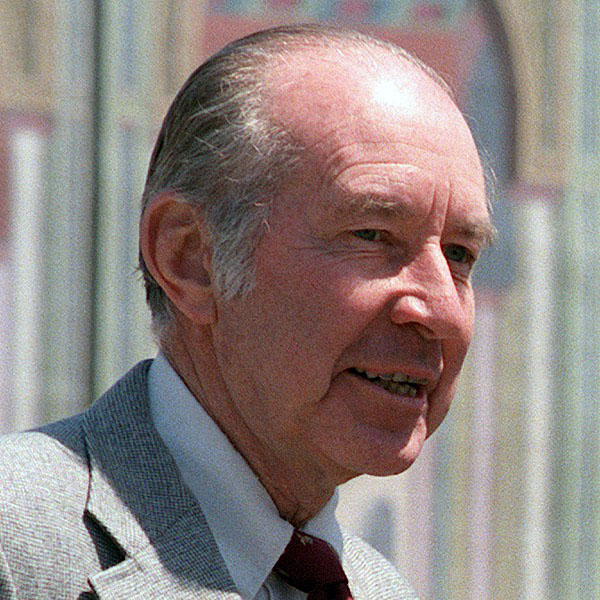 William Graham Claytor Jr. (March 14, 1912 – May 14, 1994) was an American attorney, United States Navy officer, and railroad, transportation and defense administrator for the United States government, working under the administrations of three US presidents.
William Graham Claytor Jr. (March 14, 1912 – May 14, 1994) was an American attorney, United States Navy officer, and railroad, transportation and defense administrator for the United States government, working under the administrations of three US presidents.
He is remembered for his actions as the commanding officer of the destroyer escort USS Cecil J. Doyle during World War II, which helped to save 316 lives during the USS Indianapolis tragedy. Over 30 years later, Claytor's moderate actions on behalf of the rights of female and gay service personnel as Secretary of the Navy were considered progressive for the time. He is also credited with a distinguished transportation career, including ten years as president of the Southern Railway and 11 years as the head of Amtrak, guiding the passenger railroad through a particularly difficult period in its history. He was named the Virginian of the Year in 1977.
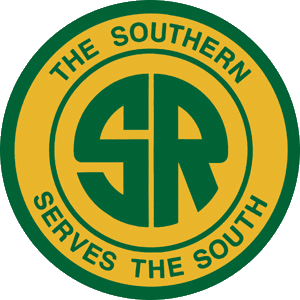 After World War II, he resumed practice of law in Washington, D.C. He became an officer of the Southern Railway in 1963, serving as president from 1967 to 1977. Notwithstanding his legal background, Claytor was known as an "operations" man, often riding the company's trains, monitoring and questioning performance. In contrast to his predecessor, D. William Brosnan, Claytor was an "employee's President," often chatting with the crews of the trains on which he rode, actively soliciting their suggestions on how to make the railroad run better. He carried this attitude with him during his later service as the President of Amtrak.
After World War II, he resumed practice of law in Washington, D.C. He became an officer of the Southern Railway in 1963, serving as president from 1967 to 1977. Notwithstanding his legal background, Claytor was known as an "operations" man, often riding the company's trains, monitoring and questioning performance. In contrast to his predecessor, D. William Brosnan, Claytor was an "employee's President," often chatting with the crews of the trains on which he rode, actively soliciting their suggestions on how to make the railroad run better. He carried this attitude with him during his later service as the President of Amtrak.
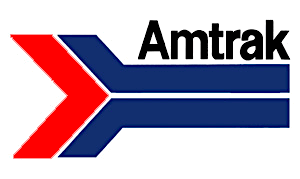 In 1982, Claytor came out of retirement to lead Amtrak. He was recruited and strongly supported by John H. Riley, an attorney who was also the head of the Federal Railroad Administration (FRA) under the Reagan Administration from 1983 to 1989. Claytor maintained a good relationship with the U.S. Congress during his 11 years in the position. Within 7 years of being under Claytor's leadership, Amtrak was generating enough money to cover 72 percent of its $1.7 billion operating budget by 1989, up from 48 percent in 1981. This was achieved mainly through vigorous cost-cutting and aggressive marketing. He is credited with bringing political and operational stability to the nation's passenger train network, keeping the railroad functioning properly despite repeated attempts by the administrations of Ronald Reagan and his successor George H. W. Bush to eliminate its funding. Claytor retired from Amtrak in 1993.
In 1982, Claytor came out of retirement to lead Amtrak. He was recruited and strongly supported by John H. Riley, an attorney who was also the head of the Federal Railroad Administration (FRA) under the Reagan Administration from 1983 to 1989. Claytor maintained a good relationship with the U.S. Congress during his 11 years in the position. Within 7 years of being under Claytor's leadership, Amtrak was generating enough money to cover 72 percent of its $1.7 billion operating budget by 1989, up from 48 percent in 1981. This was achieved mainly through vigorous cost-cutting and aggressive marketing. He is credited with bringing political and operational stability to the nation's passenger train network, keeping the railroad functioning properly despite repeated attempts by the administrations of Ronald Reagan and his successor George H. W. Bush to eliminate its funding. Claytor retired from Amtrak in 1993.
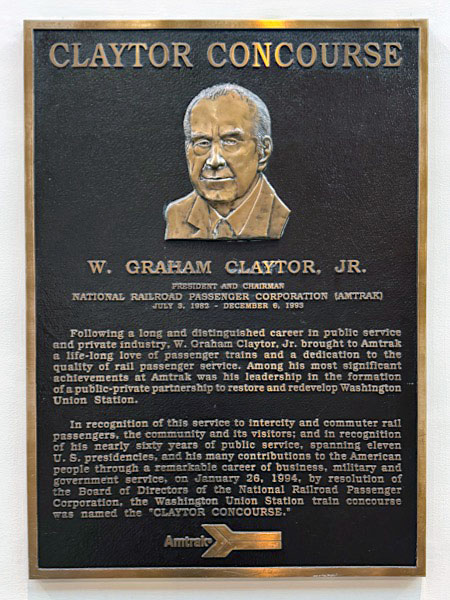
Aug 2024 / RWH

Aug 2024 / RWH

postcard / collection

See also our complete Southern Railway Featured Fallen Flag scrapbook in Mainlines
Metro Station
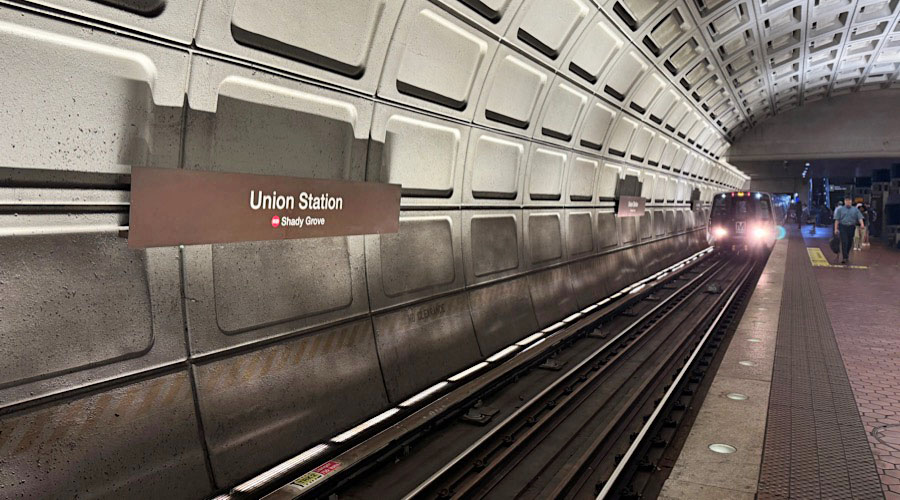
Washington, DC / Aug 2024 / RWH

Click to see the Washington Union Metro Station plotted on a Google Maps page
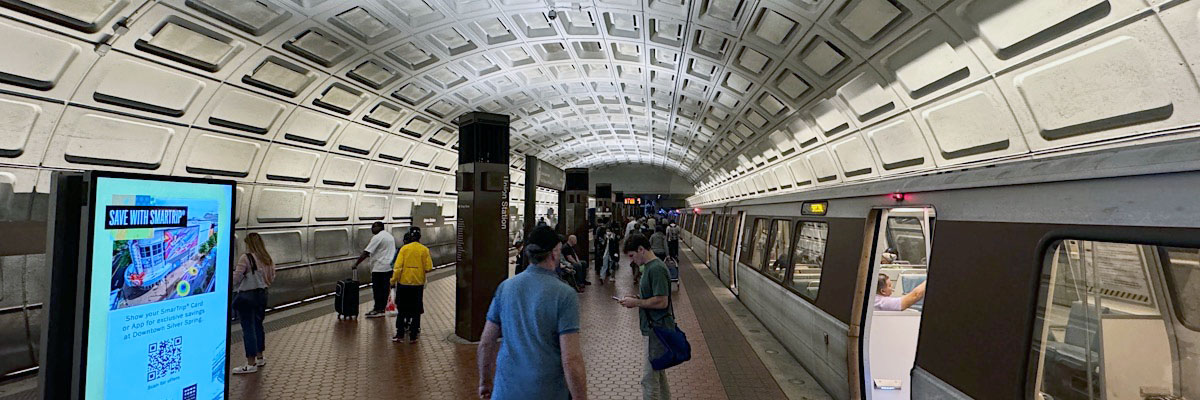
Washington, DC / Aug 2024 / RWH

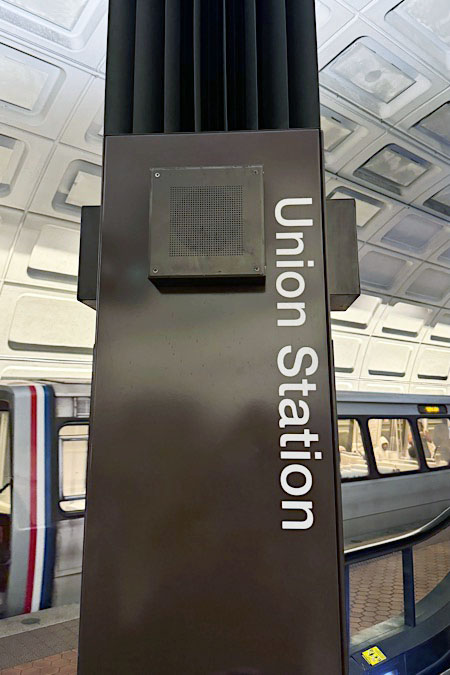
Aug 2024 / RWH
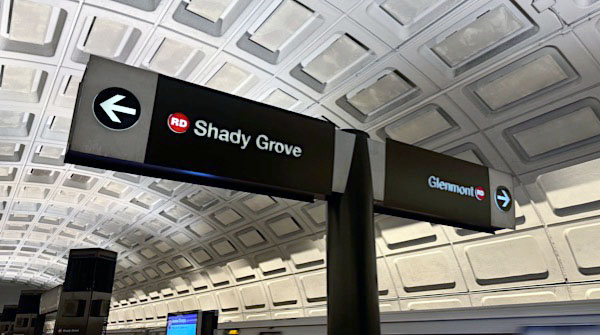
Aug 2024 / RWH

Aug 2024 / RWH
 The Washington Metro, often abbreviated as the Metro and formally the Metrorail, is a rapid transit system serving the Washington metropolitan area of the United States. It is administered by the Washington Metropolitan Area Transit Authority (WMATA), which also operates the Metrobus service under the Metro name. Opened in 1976, the network now includes six lines, 98 stations, and 129 miles of route.
The Washington Metro, often abbreviated as the Metro and formally the Metrorail, is a rapid transit system serving the Washington metropolitan area of the United States. It is administered by the Washington Metropolitan Area Transit Authority (WMATA), which also operates the Metrobus service under the Metro name. Opened in 1976, the network now includes six lines, 98 stations, and 129 miles of route.
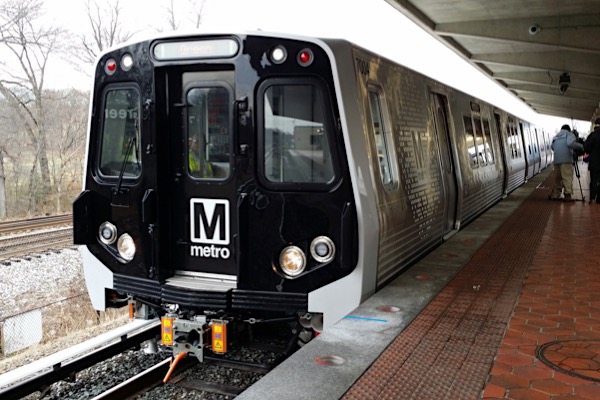 Metro serves Washington, D.C., as well as several jurisdictions in the states of Maryland and Virginia. In Maryland, Metro provides service to Montgomery and Prince George's counties; in Virginia, to Arlington, Fairfax and Loudoun counties, and to the independent city of Alexandria. The system's most recent expansion, which is the construction of a new station (and altering the line), serving Potomac Yard, opened on May 19, 2023. It operates mostly as a deep-level subway in more densely populated parts of the D.C. metropolitan area (including most of the District itself), while most of the suburban tracks are at surface level or elevated. The longest single-tier escalator in the Western Hemisphere, spanning 230 feet , is located at Metro's deep-level Wheaton station.
Metro serves Washington, D.C., as well as several jurisdictions in the states of Maryland and Virginia. In Maryland, Metro provides service to Montgomery and Prince George's counties; in Virginia, to Arlington, Fairfax and Loudoun counties, and to the independent city of Alexandria. The system's most recent expansion, which is the construction of a new station (and altering the line), serving Potomac Yard, opened on May 19, 2023. It operates mostly as a deep-level subway in more densely populated parts of the D.C. metropolitan area (including most of the District itself), while most of the suburban tracks are at surface level or elevated. The longest single-tier escalator in the Western Hemisphere, spanning 230 feet , is located at Metro's deep-level Wheaton station.
In 2023, the system had a ridership of 136,303,200, or about 576,300 per weekday as of the second quarter of 2024, making it the second-busiest heavy rail rapid transit system in the United States, in number of passenger trips, after the New York City Subway, and the sixth-busiest in North America. In June 2008, Metro set a monthly ridership record with 19,729,641 trips, or 798,456 per weekday. Fares vary based on the distance traveled, the time of day, and the type of card used by the passenger. Riders enter and exit the system using a proximity card called SmarTrip.

Aug 2024 / RWH
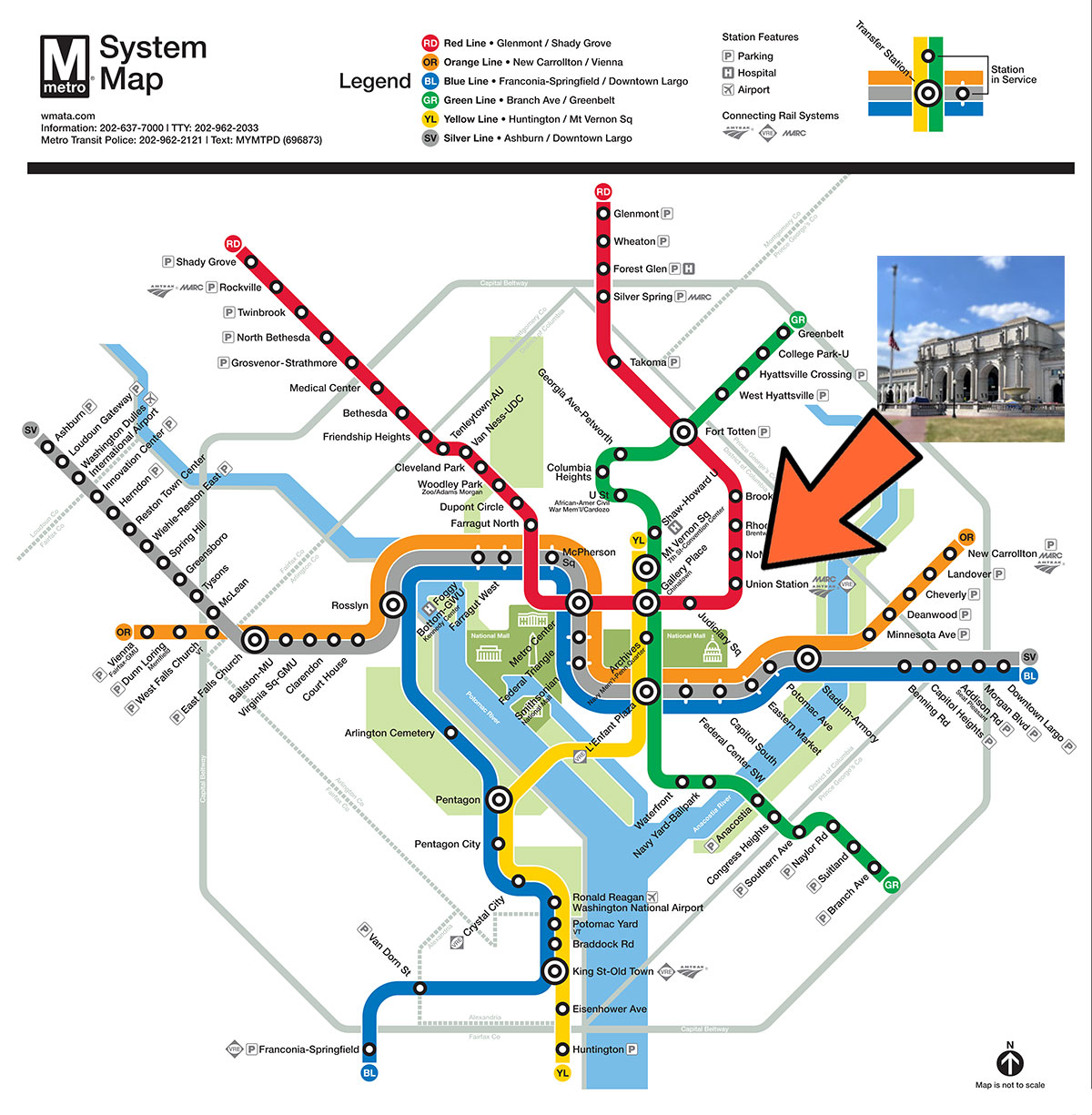
Metro system map / adapted RWH
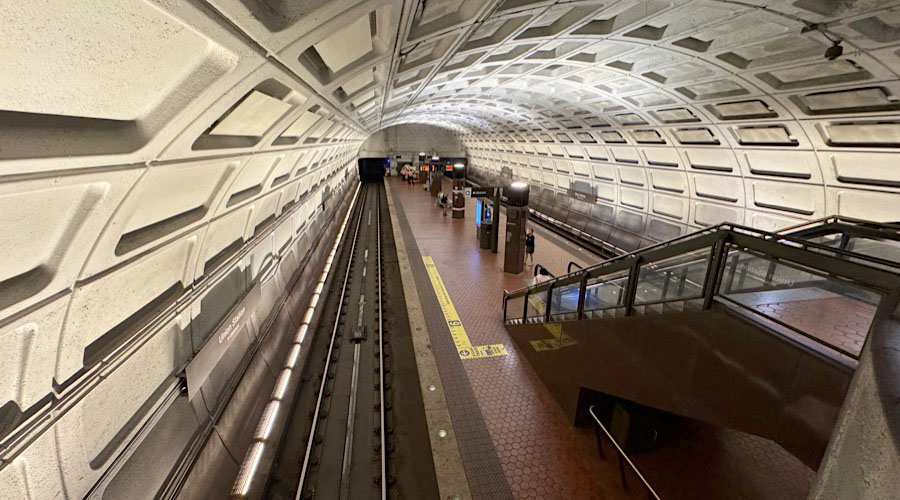
Washington, DC / Aug 2024 / RWH
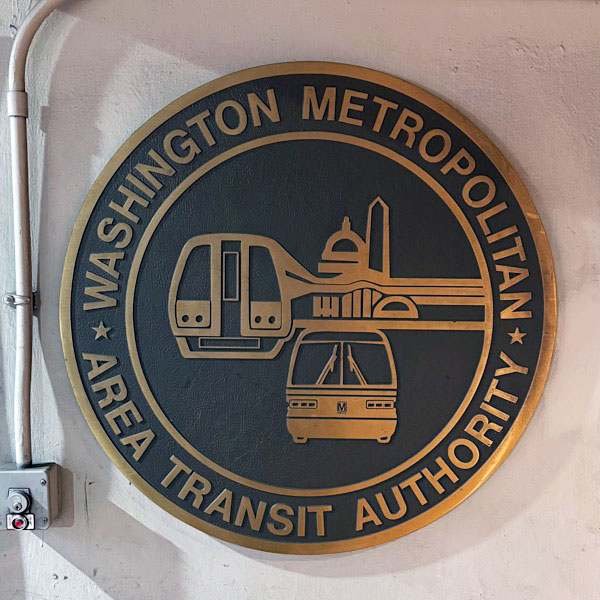
Aug 2024 / RWH
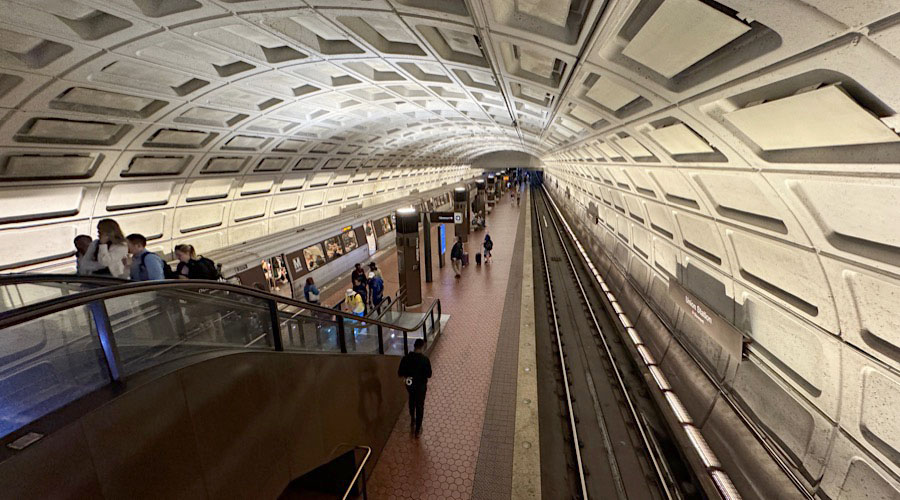
Washington, DC / Aug 2024 / RWH

Aug 2024 / RWH
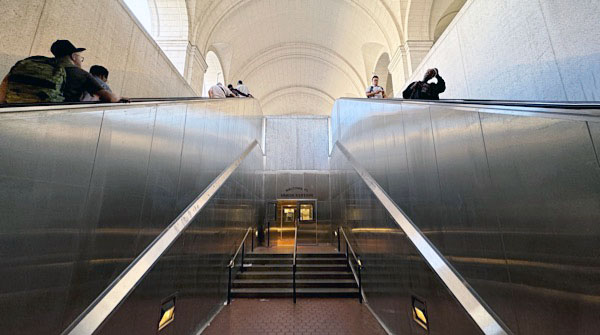
Washington, DC / Aug 2024 / RWH
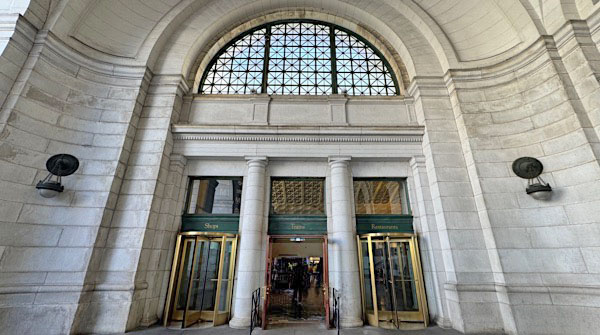
Washington, DC / Aug 2024 / RWH
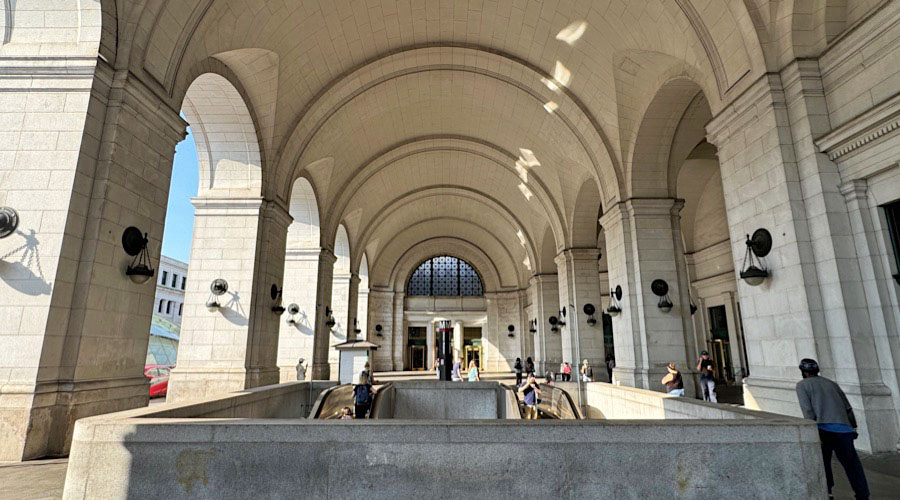
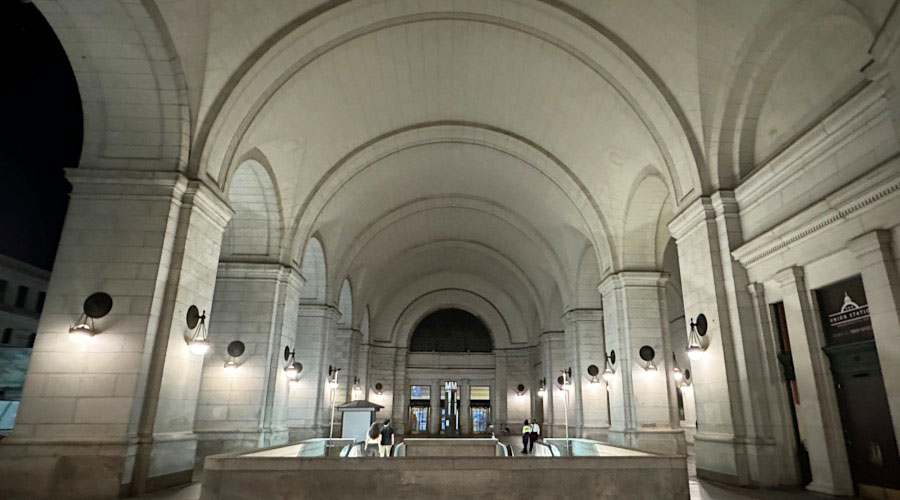
Washington, DC / Aug 2024 / RWH
 Signs and Scenes
Signs and Scenes
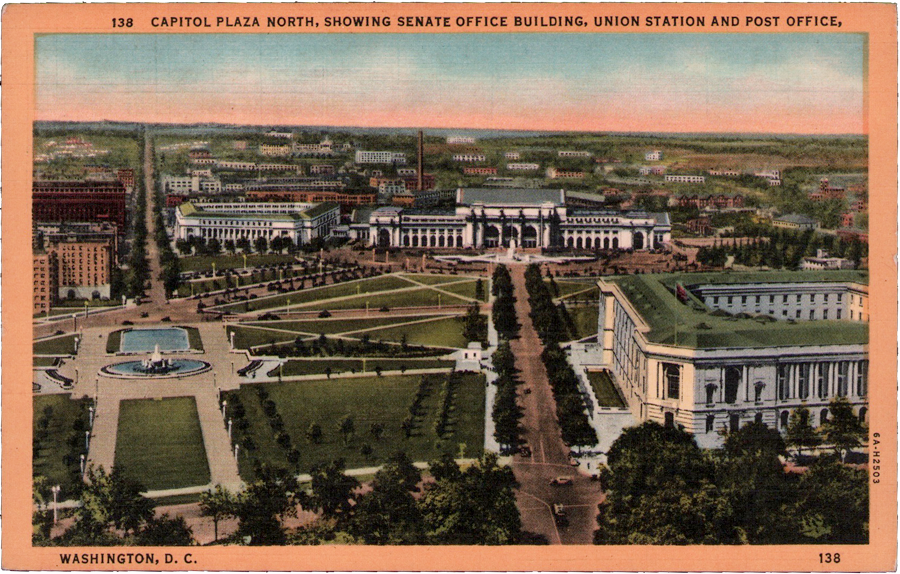
postcard / collection

Aug 2024 / RWH
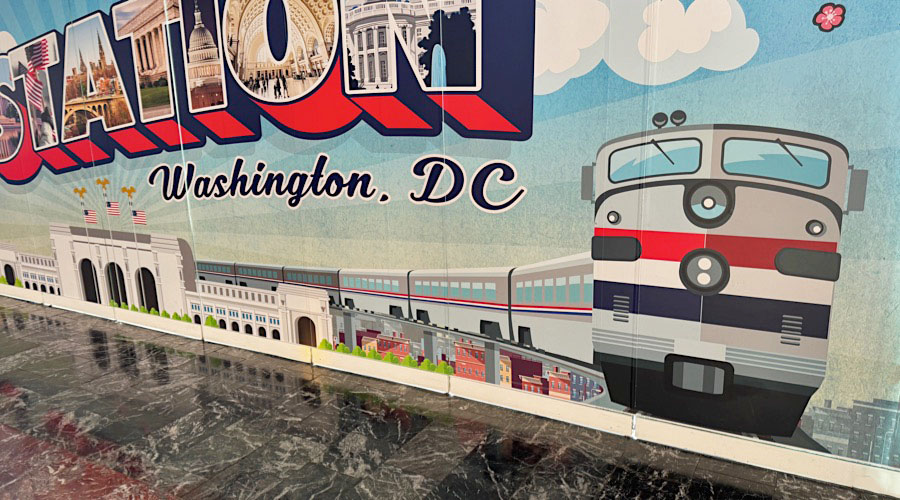
Aug 2024 / RWH
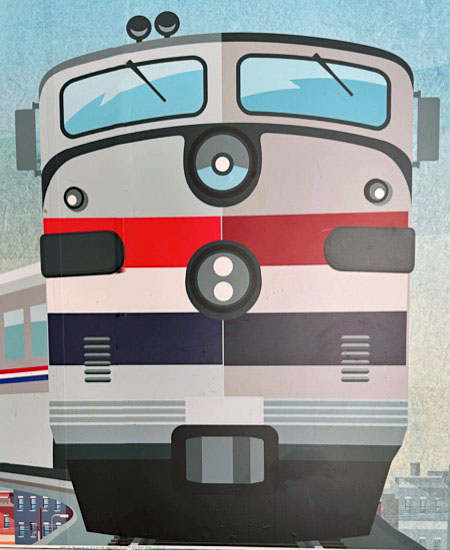
Aug 2024 / RWH

Aug 2024 / RWH

Aug 2024 / RWH
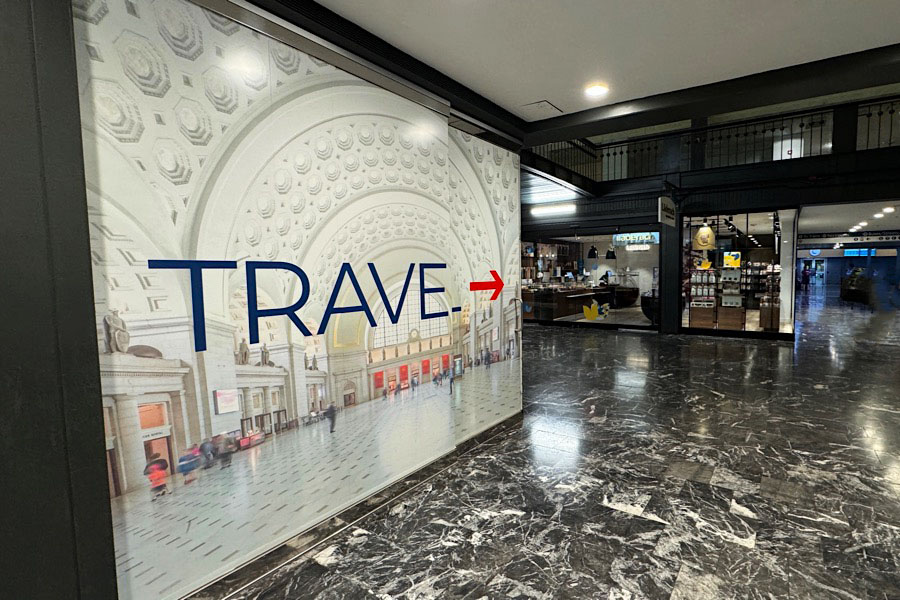
Aug 2024 / RWH

Aug 2024 / RWH
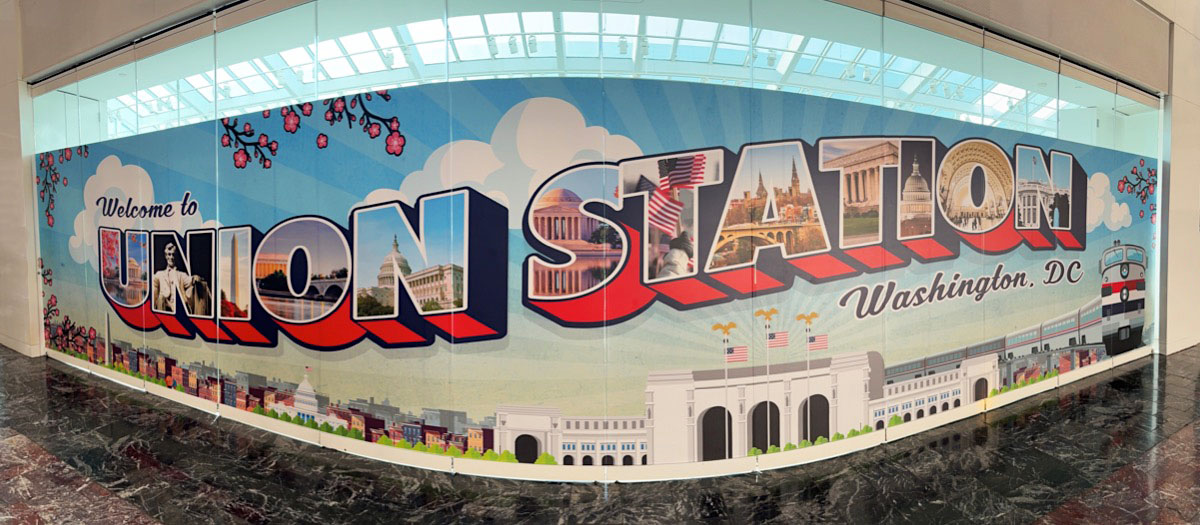
Aug 2024 / RWH
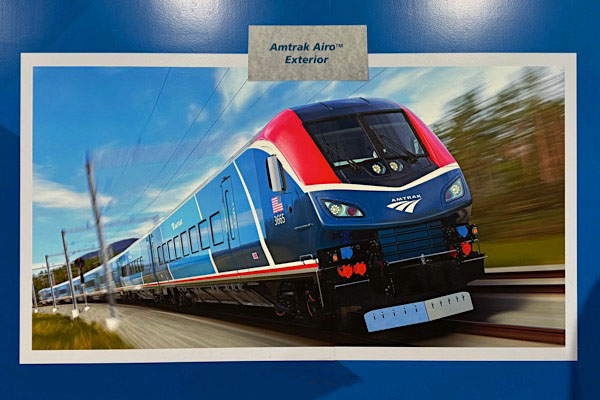
Aug 2024 / RWH
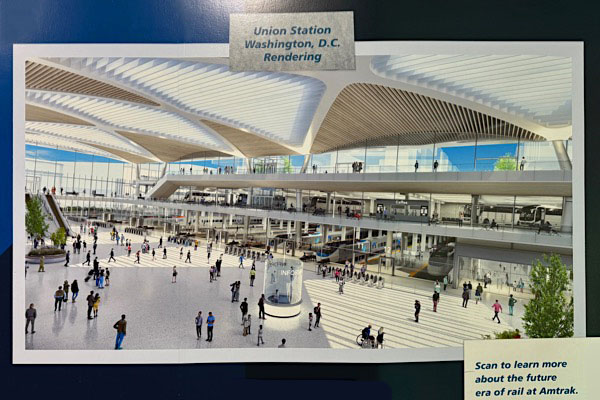
Aug 2024 / RWH
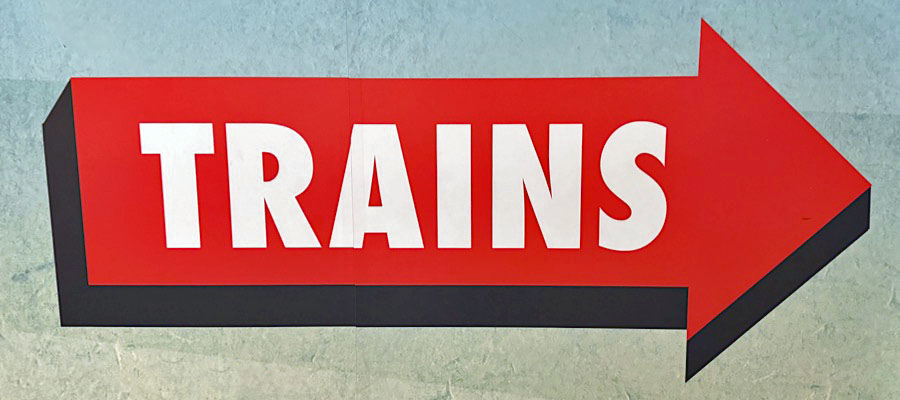
Aug 2024 / RWH
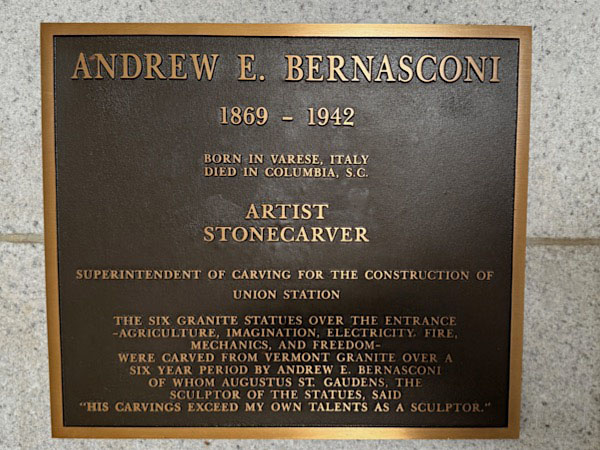
Aug 2024 / RWH
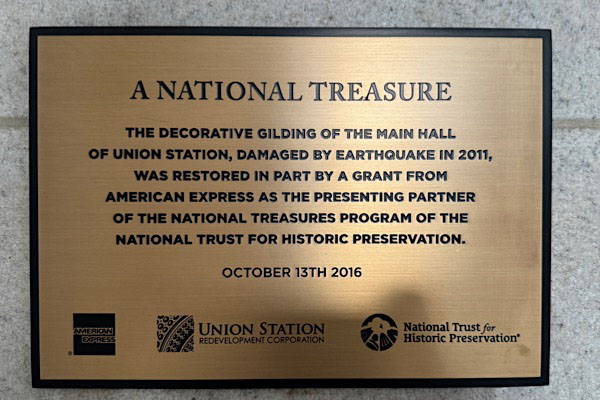
Aug 2024 / RWH
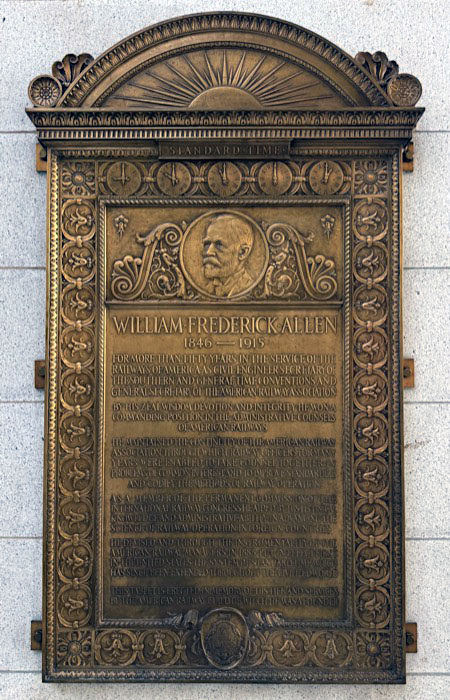
Aug 2024 / RWH
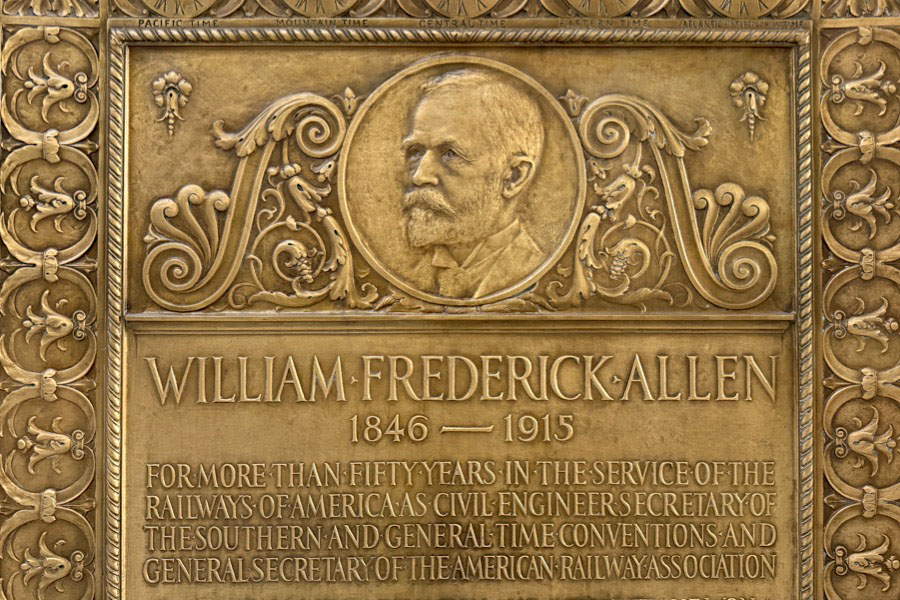
Aug 2024 / RWH
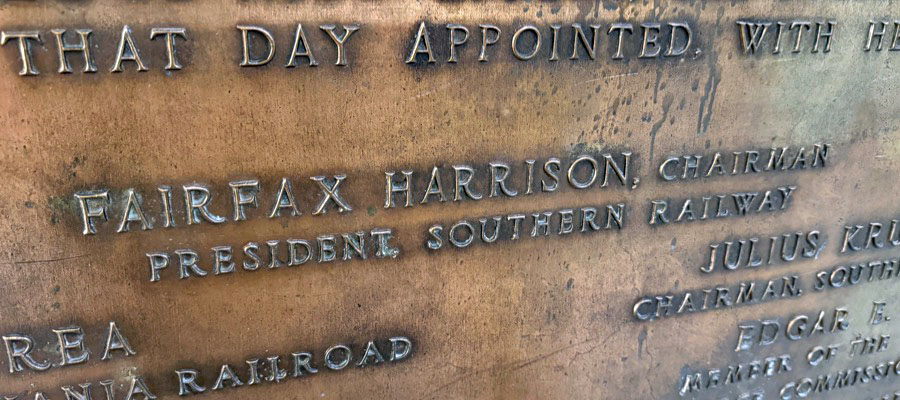
Aug 2024 / RWH

Aug 2024 / RWH
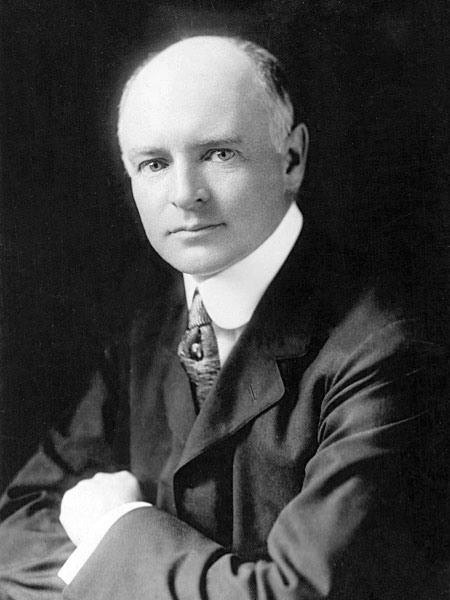 Reginald Fairfax Harrison (March 13, 1869 – February 2, 1938) was an American lawyer, businessman, and author. A son of the secretary to Confederate President Jefferson Davis, Harrison studied law at Yale University and Columbia University before becoming a lawyer for the Southern Railway Company in 1896. By 1906, he was Southern's vice-president of finance, and in 1907, he helped secure funding to keep the company solvent. In 1913, he was elected president of Southern, where he instituted a number of reforms in the way the company operated.
Reginald Fairfax Harrison (March 13, 1869 – February 2, 1938) was an American lawyer, businessman, and author. A son of the secretary to Confederate President Jefferson Davis, Harrison studied law at Yale University and Columbia University before becoming a lawyer for the Southern Railway Company in 1896. By 1906, he was Southern's vice-president of finance, and in 1907, he helped secure funding to keep the company solvent. In 1913, he was elected president of Southern, where he instituted a number of reforms in the way the company operated.
 By 1916, under Harrison's leadership, the Southern had expanded to an 8,000-mile network across 13 states, its greatest extent until the 1950s. In December 1917, months after the United States entered World War I in April, the federal government took control of the railroads, running them through the United States Railroad Administration, on which Harrison served. An economic boom after the war helped the company to expand its operations; Harrison worked to improve the railroad's public relations and to upgrade the locomotive stock by introducing more powerful engines. Another of his concerns was to increase the amount of the railroad's track and to expand the area it served. Harrison struggled to keep the railroad industry afloat during the Great Depression, but by 1936, Southern was once again showing a profit. Harrison retired in 1937, intending to focus on his hobby of writing about historical subjects, including the roots of the American Thoroughbred horse, but he died three months later in February 1938.
By 1916, under Harrison's leadership, the Southern had expanded to an 8,000-mile network across 13 states, its greatest extent until the 1950s. In December 1917, months after the United States entered World War I in April, the federal government took control of the railroads, running them through the United States Railroad Administration, on which Harrison served. An economic boom after the war helped the company to expand its operations; Harrison worked to improve the railroad's public relations and to upgrade the locomotive stock by introducing more powerful engines. Another of his concerns was to increase the amount of the railroad's track and to expand the area it served. Harrison struggled to keep the railroad industry afloat during the Great Depression, but by 1936, Southern was once again showing a profit. Harrison retired in 1937, intending to focus on his hobby of writing about historical subjects, including the roots of the American Thoroughbred horse, but he died three months later in February 1938.

See also our complete Southern Railway Featured Fallen Flag scrapbook in Mainlines
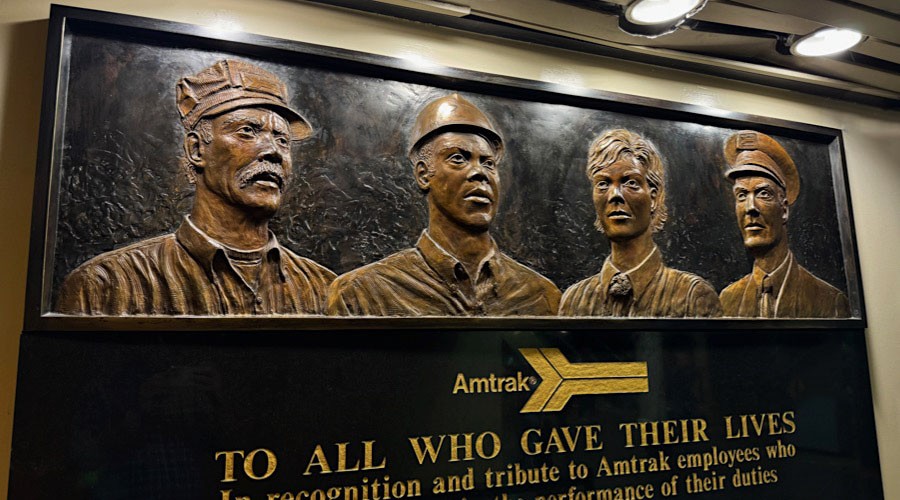
Aug 2024 / RWH
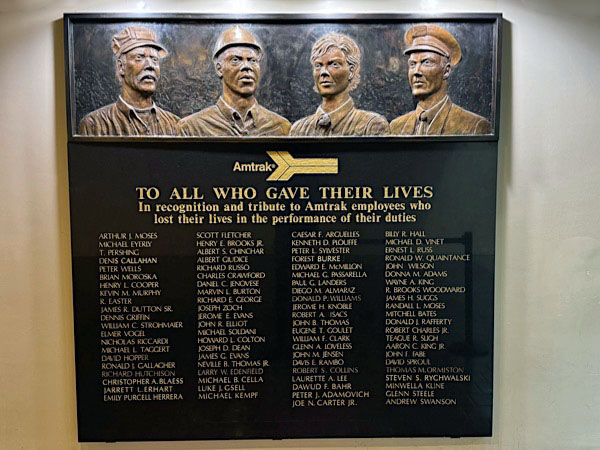
Aug 2024 / RWH
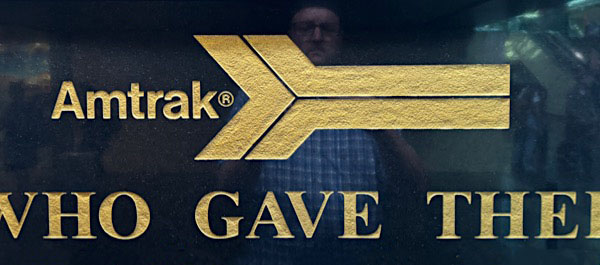
Aug 2024 / RWH
All Aboard!
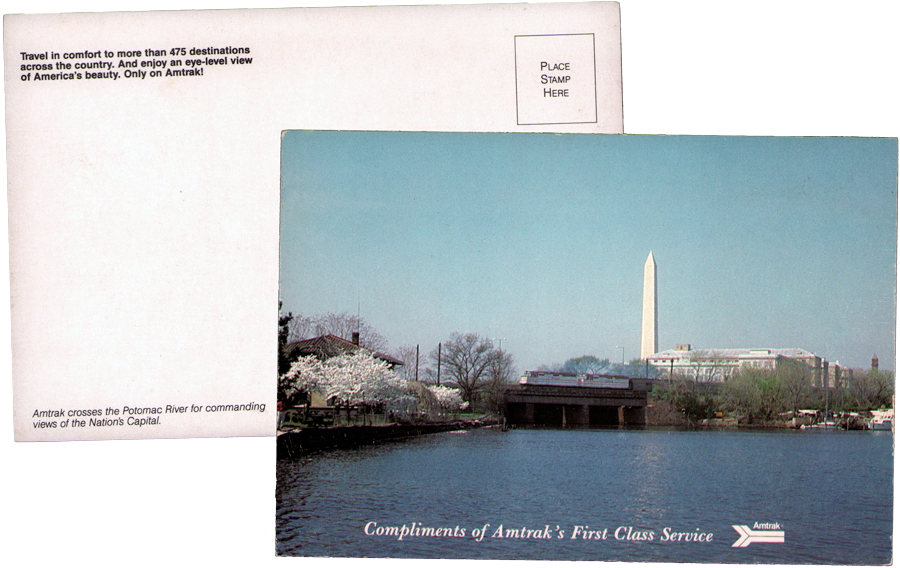
postcard / collection
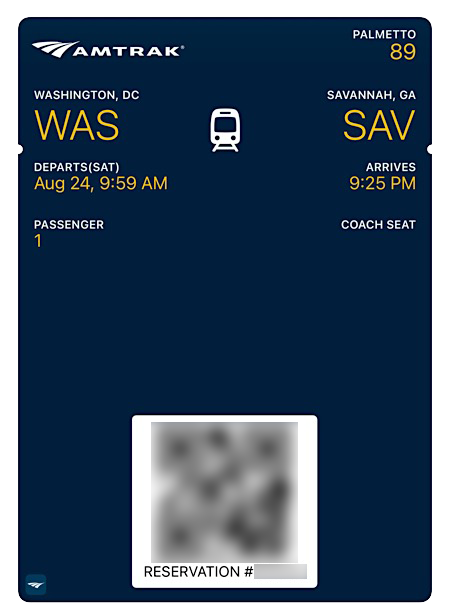

Washington, DC / Aug 2024 / RWH
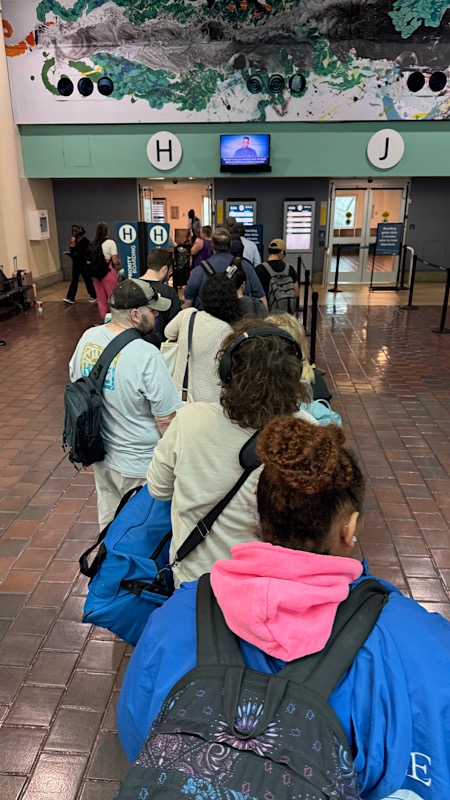
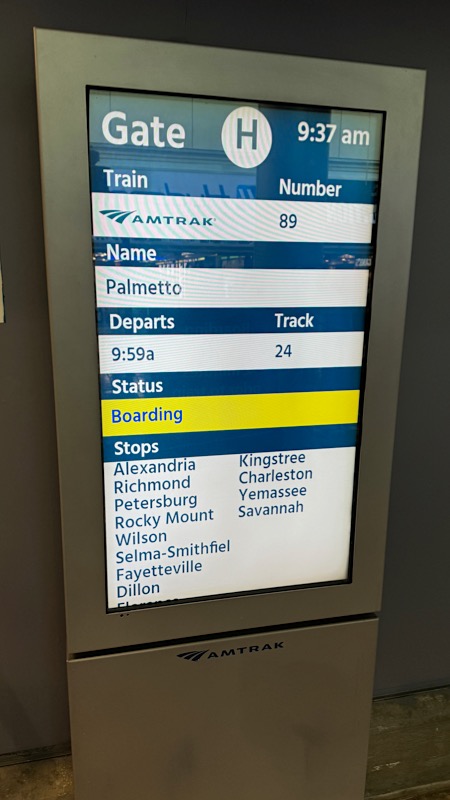
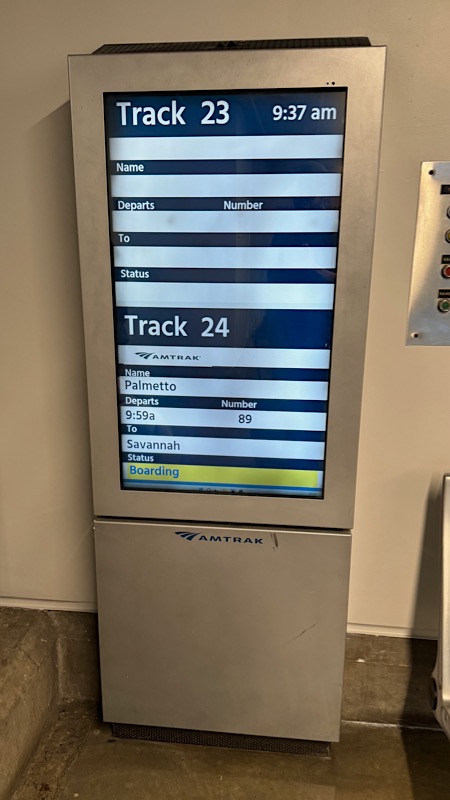
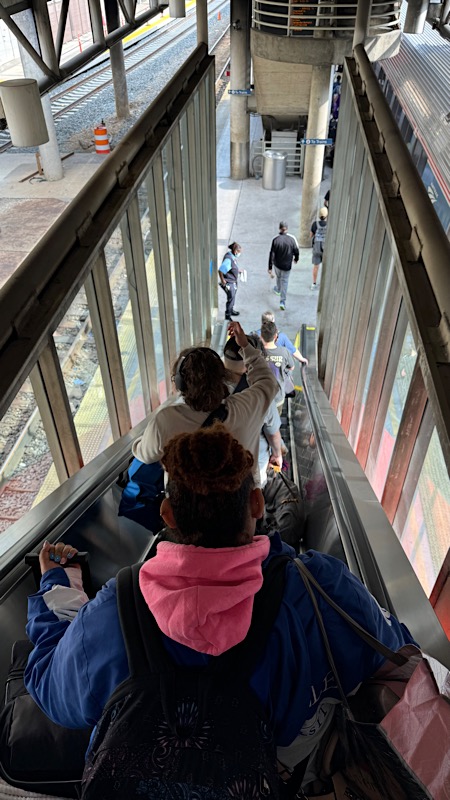

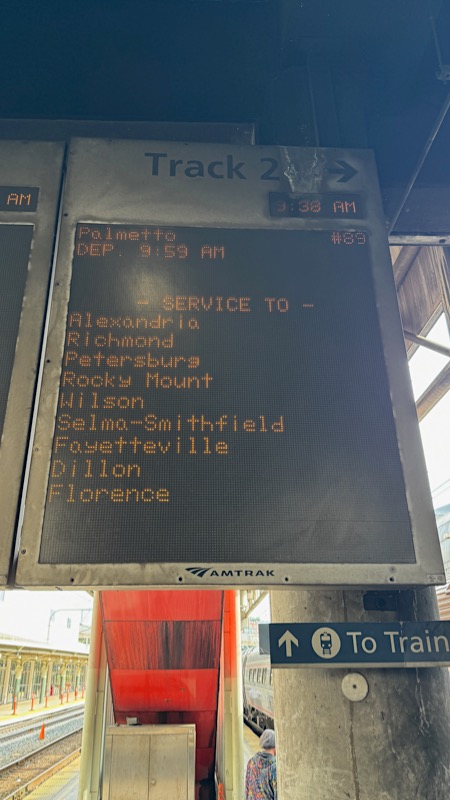


Washington, DC / Aug 2024 / RWH

Aug 2024 / RWH

Aug 2024 / RWH
 Union @ Night
Union @ Night

Washington, DC / Feb 2022 / RWH

Washington, DC / Feb 2022 / RWH

Washington, DC / Feb 2022 / RWH

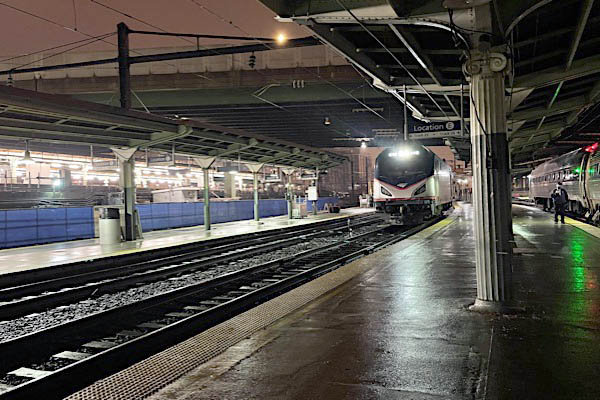
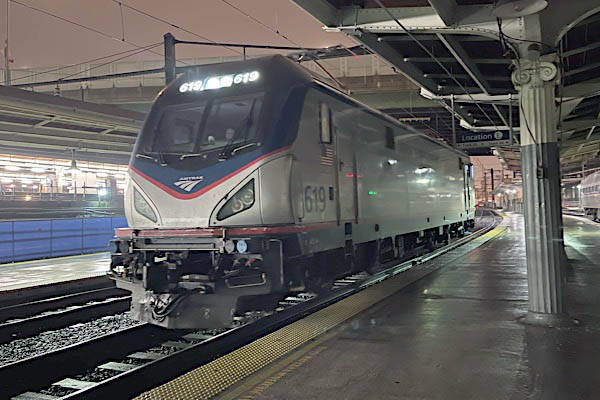
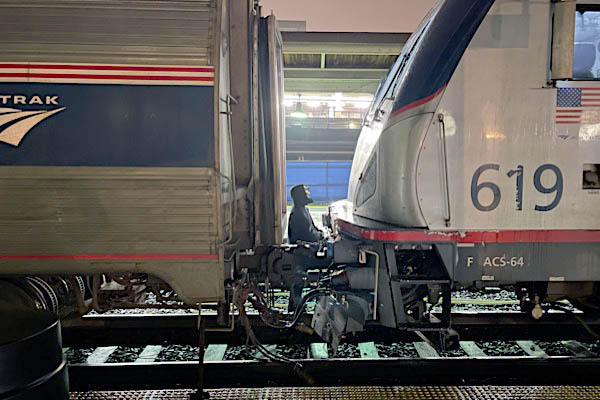
Washington, DC / Feb 2022 / RWH

Washington, DC / Feb 2022 / RWH
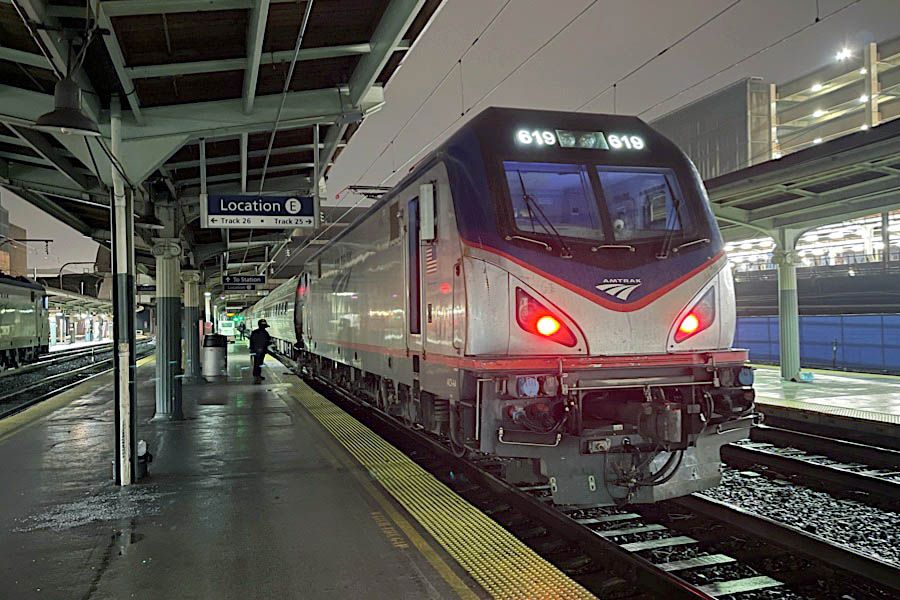
Washington, DC / Feb 2022 / RWH

Amtrak #611
Siemens ACS-64 (2014) / Washington, DC / Feb 2022 / RWH

Feb 2022 / RWH

Washington, DC / Feb 2022 / RWH

Washington, DC / Feb 2022 / RWH

Washington, DC / Feb 2022 / RWH

Washington Union Station - February 9, 2022 — Dismounted southbound Palmetto #89 to watch locomotive changeout procedure, transition from electric to diesel-electric motive power upon leaving Northeast Corridor overhead catenary. Northbound trains swap power in reverse procedure. Air brakes and Head End Power disconnected at first coach by Amtrak mechanical department. Amtrak #619 (Siemens ACS-64 b. 2014) uncoupled and pulled away to locomotive terminal. Amtrak #5 (General Electric "Genesis" P42DC b. 1996) backed into position and coupled. Brakes and power reattached. Reboarded Palmetto for departure.

Washington, DC / Feb 2022 / RWH
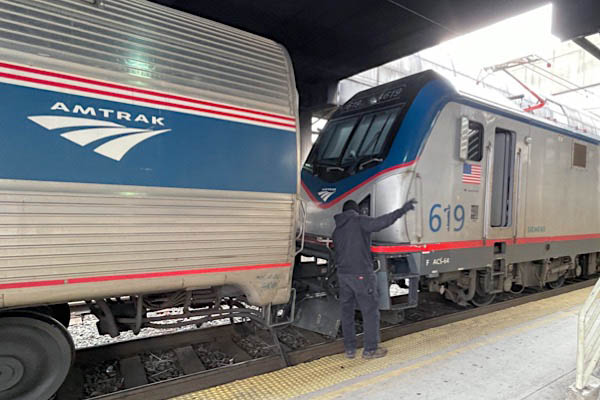
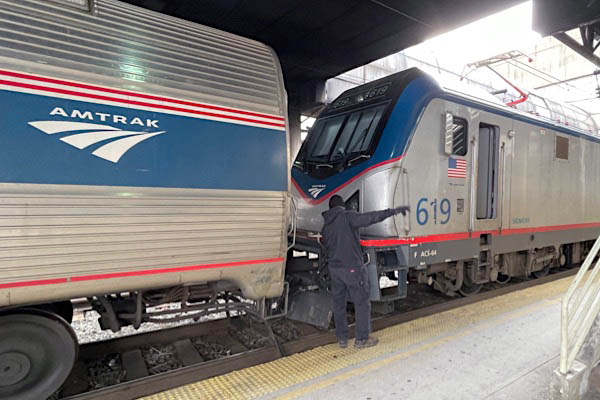
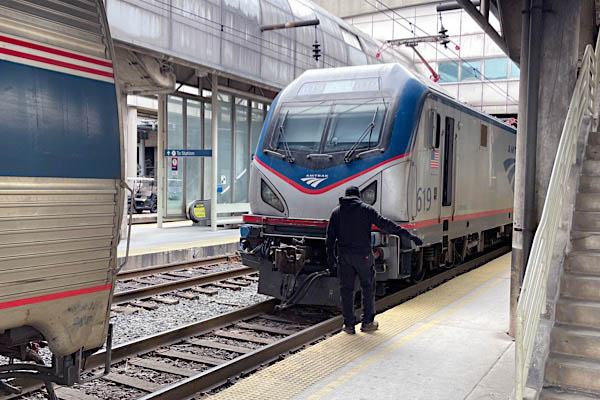
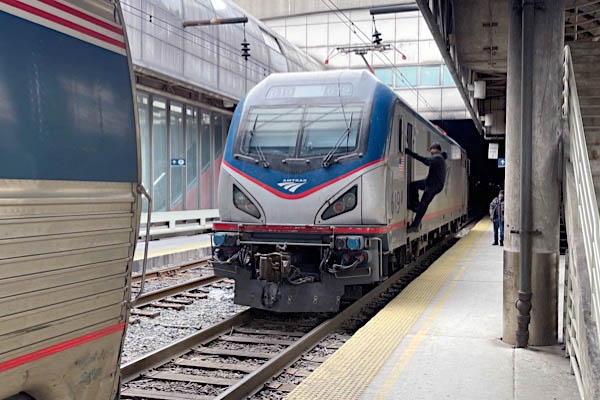
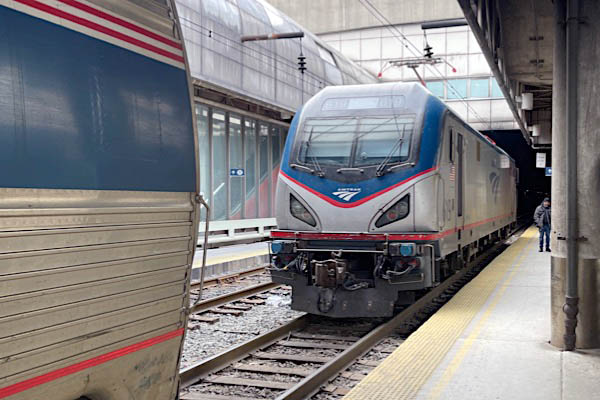
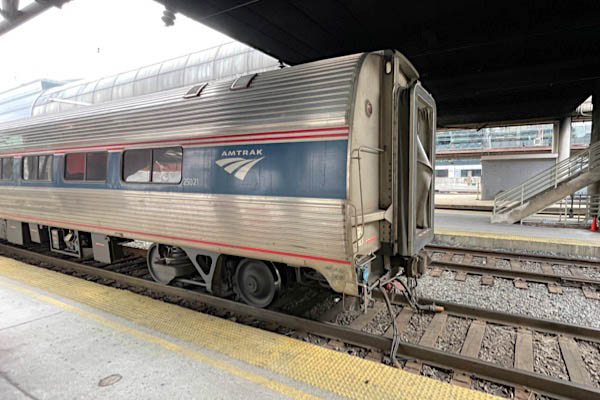
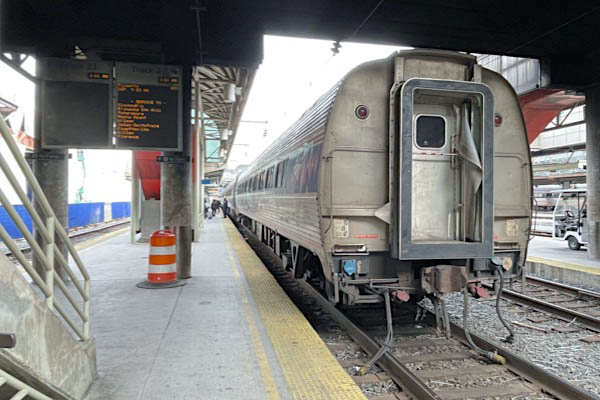
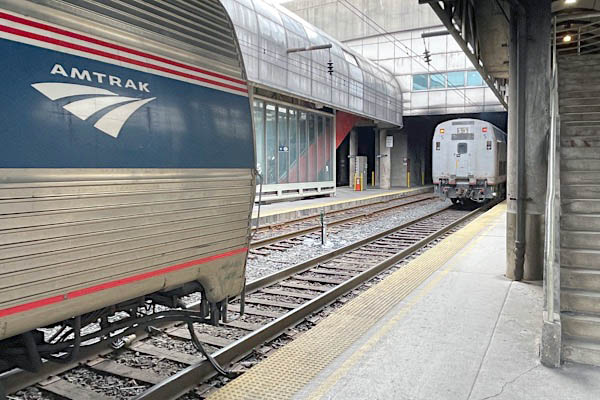
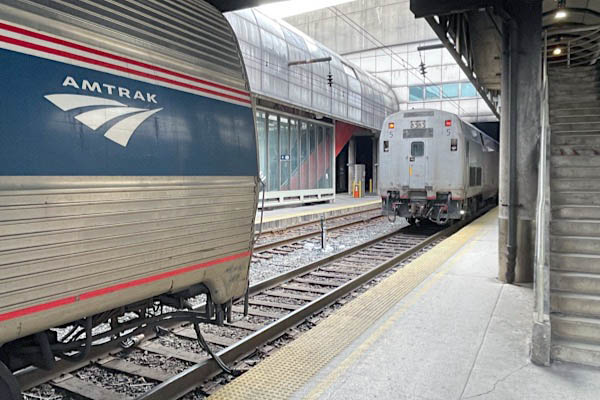
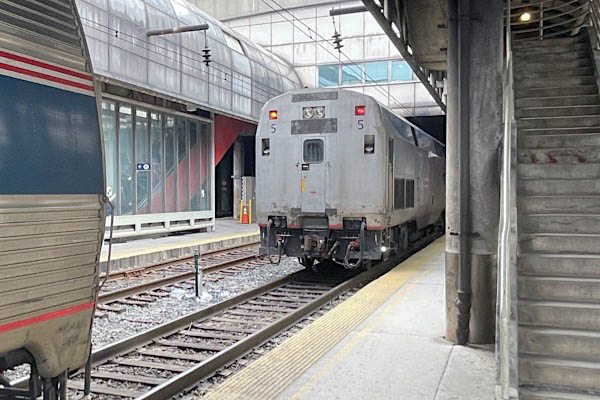


Washington, DC / Feb 2022 / RWH

See also our complete Amtrak Palmetto Route Scrapbook in Mainlines
 Lagniappe
Lagniappe

Daniel Hudson Burnham's Masterpiece
Aug 2024 / image and artwork RWH
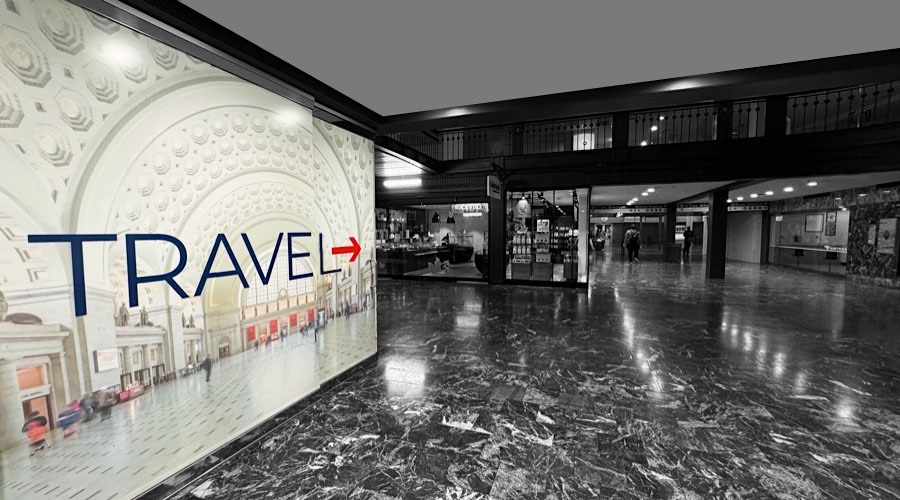
Your Carriage Awaits
Washington, DC / Aug 2024 / RWH

A Concourse for the People
Washington, DC / Aug 2024 / RWH
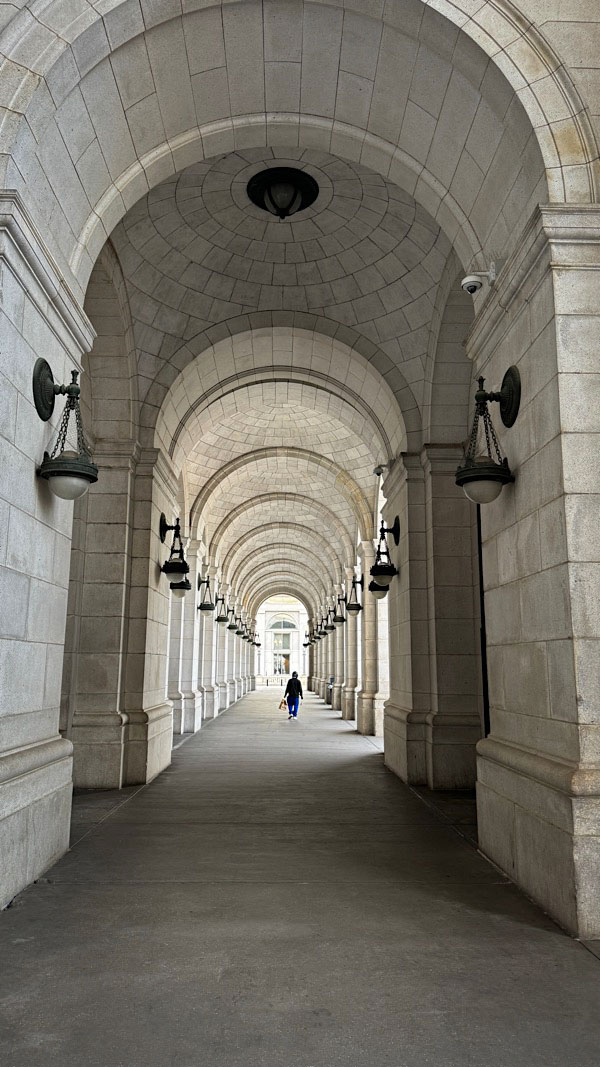
Time to Go Home
Aug 2024 / RWH
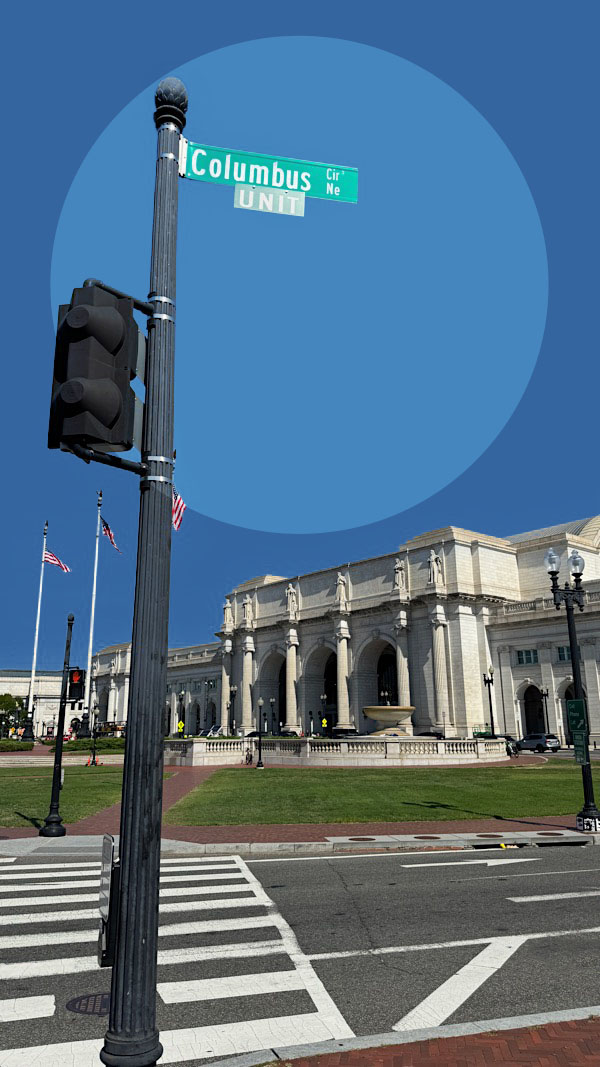
Columbus Circle
Aug 2024 / RWH

Thresholds
Aug 2024 / RWH
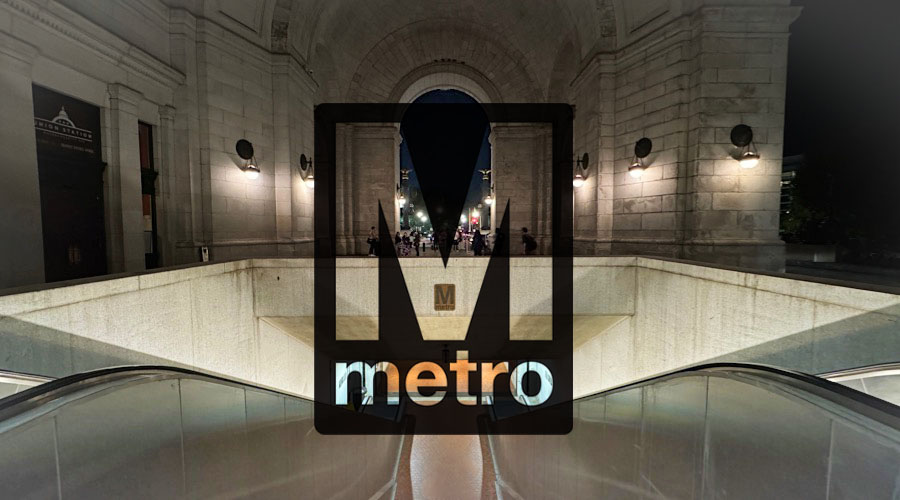
Metrorail Moment
image and artwork RWH
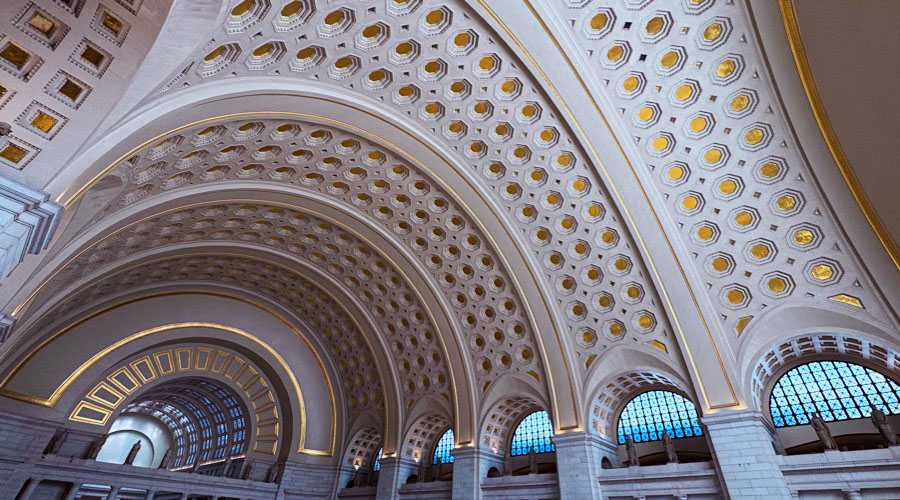
Baths of Diocletian
Washington, DC / Aug 2024 / RWH
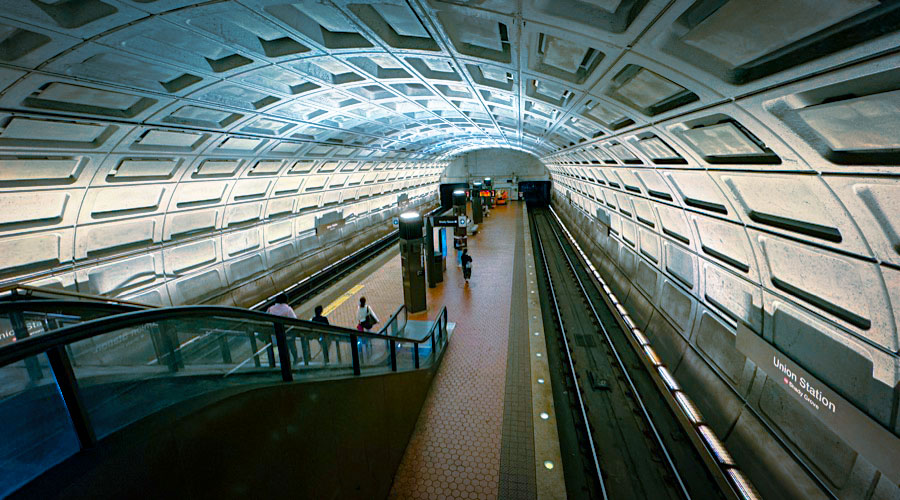
Underground Egress
Washington, DC / Aug 2024 / RWH

Embraced by the Light
Washington, DC / Aug 2024 / RWH

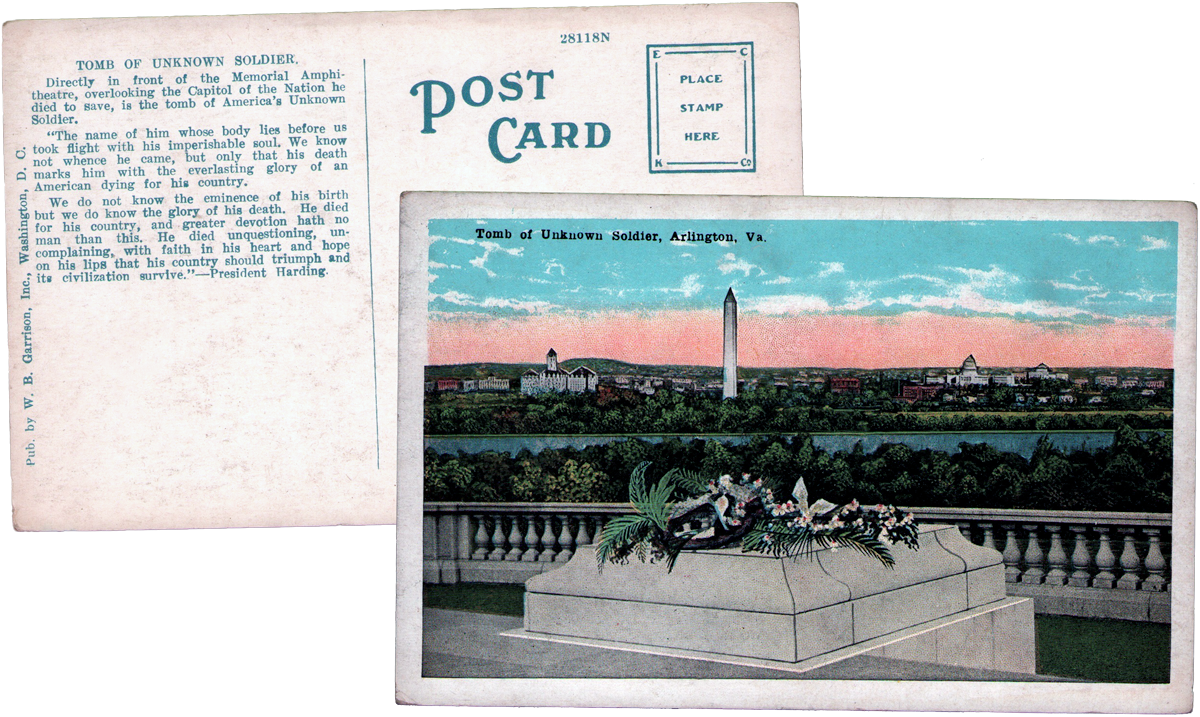
postcard / collection
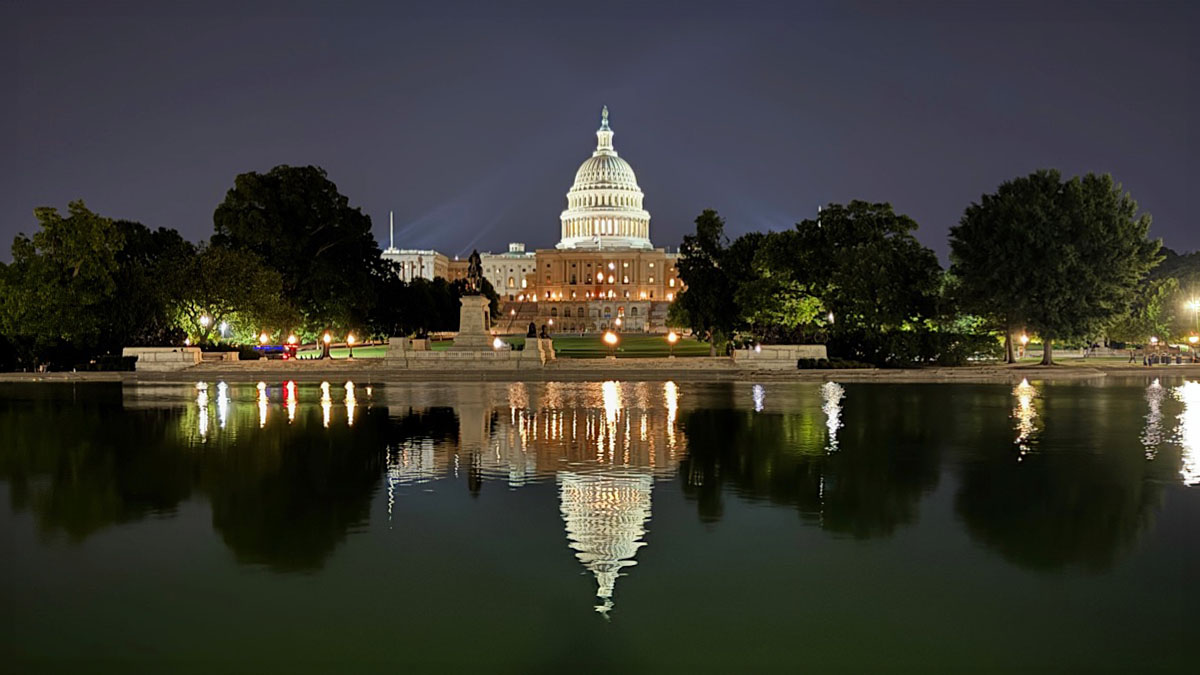
Washington, DC / Aug 2024 / RWH

Washington, DC / Aug 2024 / RWH
 Snapshots
Snapshots

Washington, DC / Oct 2008 / Elizabeth Hawkins

Union Station. The nation's second busiest railroad terminal. Five million souls pass through it in a given year. The Main Hall takes your breath away. The six statues greeting you over the front doors harken back to an American Renaissance. It is Europe, in America. I love every part of it.
Union became a fixture for my young daughter as our family made annual treks by train from Pittsburgh to Richmond, and return. Thus Union was always the pivotal connection — with lunch on the lower level, stores to peek into upstairs, and a quick glimpse of our nation's capital way beyond Columbus Circle. She got all the big feels of the Big City ... without ever leaving the building.
Honestly, I can sit for an hour in the cavernous Main Hall and people-watch to my heart's content; everyone headed somewhere, in a hurry. One Friday night in late summer, I had no train to catch until the morning: I meandered all over Union after the rush hours, looking for undiscovered nooks and crannies, listening for the calls for the evening trains up the Corridor, paying attention to passersby. In some sense, Union becomes even more interesting as the crowds thin out and only the late travelers come and go. An immense space, on its own terms. I sat with two strangers just off the main hall, eating a burrito and listening as the building settled down for the evening. The woman behind stared at her phone; the man next to me stared into space; but I was transfixed by the ancient arched ceiling and the Tennessee marbled floor. A sanctuary for the spirit of transportation, this place; a stillness, just before more movement. Was this what Daniel Burnham imagined — public wonder — drawing up those magnificent plans more than a century ago?
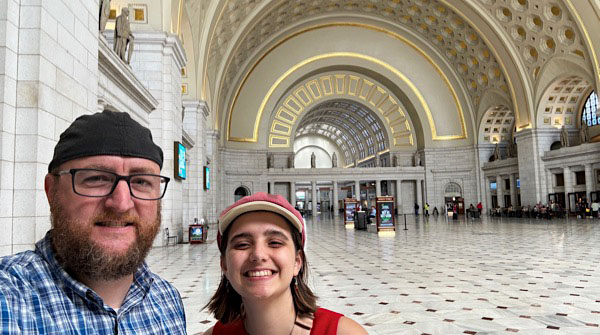
Washington, DC / Aug 2024 / RWH

Washington, DC / Aug 2024 / RWH
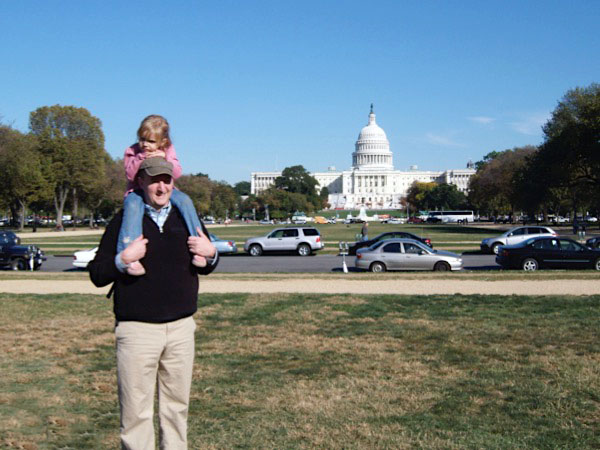
Washington, DC / Oct 2008 / Elizabeth Hawkins

Washington, DC / Oct 2008 / RWH
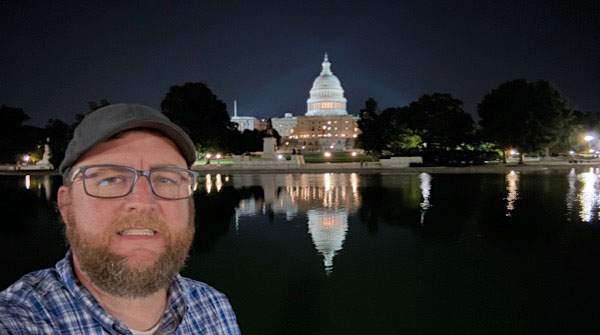
Washington, DC / Aug 2024 / RWH

Washington, DC / Aug 2024 / RWH
Links / Sources
- Washington Union Station website
- Amtrak's Washington Union page
- Great American Stations Washington Union page
- Wikipedia article for Washington Union
- Union Station Redevelopment Corporation
